EADIE, JAMES (1824-1884). Corporal, 1st New York Engineers, Company H. A native of New York City, Eadie enlisted there as a private on January 13, 1862, and mustered into the 1st New York Engineers on that day. He was promoted to artificer on July 1, 1862, to corporal on May 3, 1863, and mustered out on January 12, 1865, at Varina, Virginia. He last lived at 222 Bergen Street in Brooklyn. His death was caused by apoplexy. Section 45, lot 6358.
Civil War Bio Search
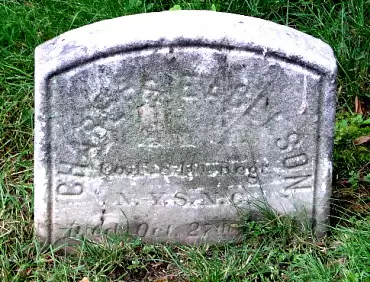
EAGLESON, CHARLES (1835-1886). First lieutenant, 84th Regiment, New York State National Guard, Company F; sergeant, 8th Regiment, New York State National Guard, Company F. He enlisted and mustered into the 8th Regiment’s National Guard at New York City on May 28, 1862, and mustered out on September 10 of that year. His next service was in 1863 with the 84th Regiment, serving 30 days with the rank of sergeant. When his unit was reactivated a year later, he re-enlisted as a first lieutenant on July 12, 1864, was commissioned in the next day, and served 100 days, mustering out with his company on October 29, 1864, at New York City.
A marble cutter by trade, his brother, an actor with the stage name of Thomas Wallace Keene, was a contemporary of the renowned thespian Edwin Booth, the brother of John Wilkes Booth, the assassin of President Abraham Lincoln. His last residence was 19 Suydam Avenue in Brooklyn. He died of “hypertrophy of heart.” In 1890, his widow, Margaret Eagleson, applied for a pension, which was granted under certificate 304,539. His Section 24, lot 6785.
EAKINS, JOSEPH B. (1844-1908). Sergeant, 6th New York Heavy Artillery, Company C. Eakins was born in Paterson, New Jersey. During the Civil War, he enlisted as a private on September 2, 1862, at West Farms, New York, and mustered into Company C of the 6th New York Heavy Artillery. Eakins was promoted to corporal on February 26, 1864, and to sergeant on June 3, 1865, before he mustered out with his company on June 28, 1865, at Petersburg, Virginia.
Eakins was appointed to the police force in New York City on March 1, 1866, made roundsman on December 6, 1868, sergeant on March 21, 1872, and was promoted to captain on October 19, 1876. His biography in Our Police Protectors described Eakins as a modest man who was popular, energetic and held in high esteem by his superiors. The New York City Directory for 1876 lists him as a policeman. At the time he mustered into Lafayette Post #140 of the G.A.R. on July 7, 1893, he lived in New York City and was employed as a police captain. On December 6, 1893, the New York Herald reported that Eakins was one of 13 police captains who were assigned to different precincts for “the good of the service”; Eakins was moved from Delancey Street to Mercer Street in Manhattan (there was no mention of wrong-doing by Eakins in the article). In 1907, his application for a soldier’s pension was approved, certificate 1,132,724. He last lived at 261 Irving Street in Brooklyn. His death was attributed to myocarditis. Eliza Jane Eakins, who is interred with him, applied for and received a widow’s pension in 1908, certificate 664,258. Section 33, lot 22778.
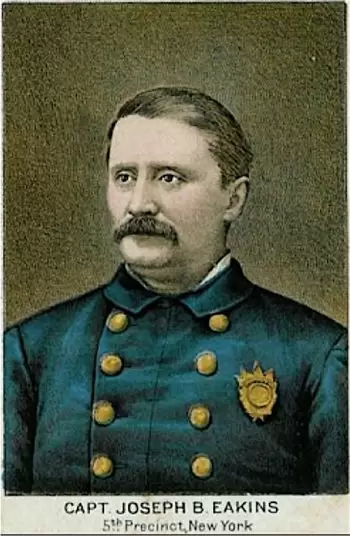
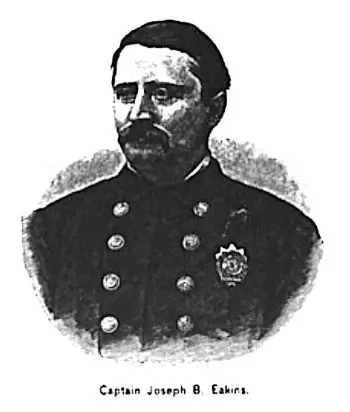
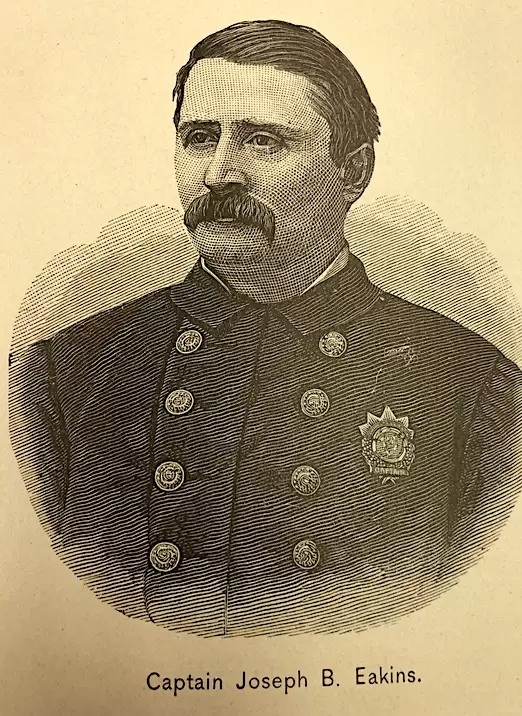
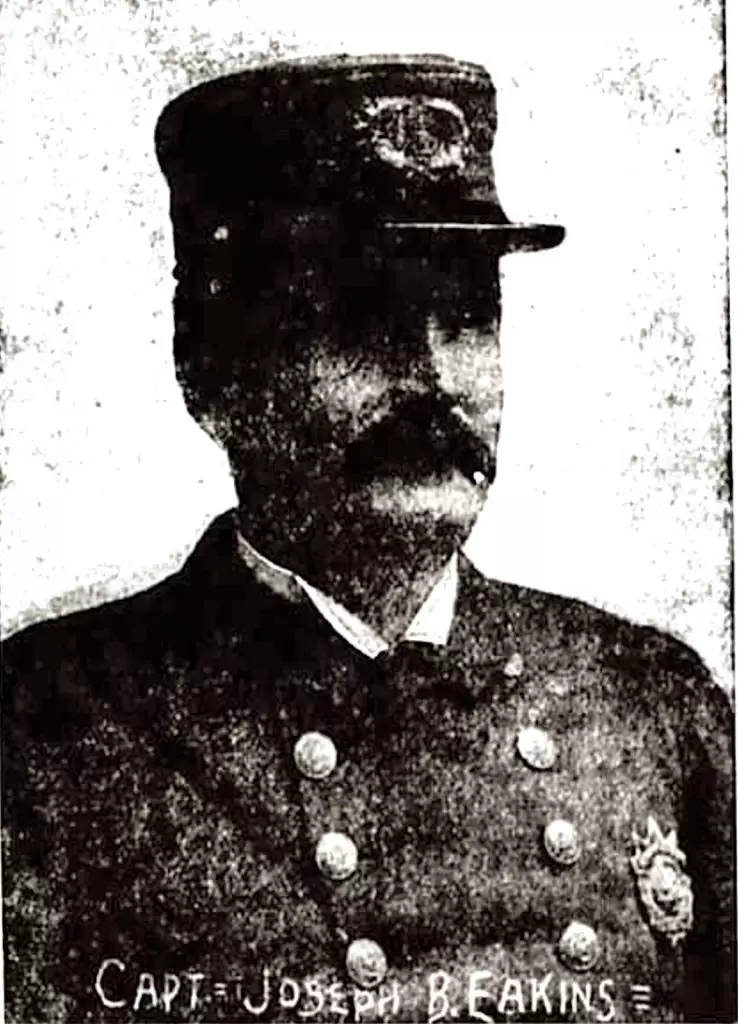
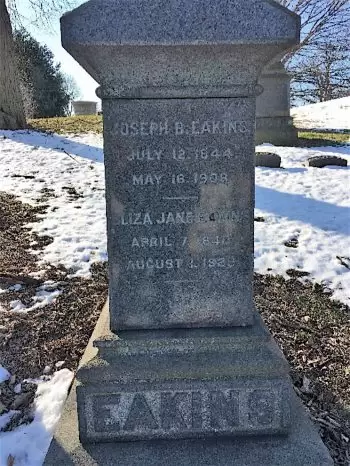
EARL, JOHN (1822-1906). Private, 173rd New York Infantry, Company E. Born in Ireland, Earl enlisted as a private at Brooklyn on September 3, 1862, mustered into the 173rd on October 30, and was discharged on November 15 of that year at New York City. As per the census of 1880 and the Brooklyn City Directory of 1882, he was a carpenter by trade. At the time of his death, he resided at 98 Warren Street in Brooklyn. Earl’s death was attributed to bronchitis. Section 138, lot 26493, graves 7 and 8.
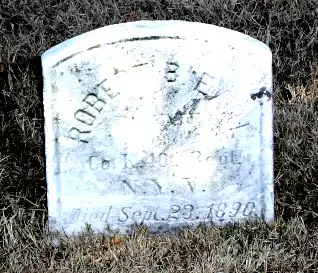
EARL, ROBERT B. (1838-1890). Private, 40th New York Infantry, Company K. As per the census of 1850, Earl was a resident of Yorktown, New York; in 1860, he lived in Ossining, New York. Earl enlisted as a private on June 27, 1861, and was discharged on March 6, 1862, pursuant to a surgeon’s certificate. According to the censuses of 1870, when he was living in Westchester and 1880, when he was living in Brooklyn, he was a file cutter by trade. (A file cutter made rows of files by cutting sharp teeth into metal.)
Earl joined Gouverneur K. Warren Post #286 of the G.A.R. in 1883, and remained a member until his death. On May 23, 1890, his application for an invalid pension was approved under certificate 510,764. The Veterans Schedule of 1890, which notes that he had heart trouble, confirms his military status as does an inscription on his gravestone. He last lived at 1614 Fulton Street in Brooklyn. Earl died from bronchitis. Shortly after his death, Sarah Earl, who is interred with him, applied for and received a widow’s pension, certificate 278,619. Section 190, lot 23259.
EARLE, EDWARD SMITH (1829-1892). Captain and commissary of subsistence, United States Volunteers; adjutant and first lieutenant, 3rd Michigan Infantry. Before Earle moved from New York City, his birthplace, to Michigan in 1853, he was a clerk in his father’s store and was a member of the 7th New York Cavalry for nine years. In Michigan, he was a grocer in Grand Rapids where his family established a business and became involved in 1855 with the newly formed militia there, called the Valley City Guard. He was a first sergeant of that unit in 1856 and rose to the rank of orderly sergeant, a position he held until the outbreak of the Civil War. Earle also served as judge advocate of the 51st Michigan’s State Militia in the western part of the state.
When the 51st was reorganized as the 3rd Michigan in April 1861, Earle enlisted as an adjutant and first lieutenant at Grand Rapids on May 13, was commissioned into the Field and Staff on June 10, but remained behind because of sickness when the regiment left on June 13 of that year. On June 24, 1861, he, along with the others from camp who did not muster the previous week, headed for Washington, D.C., arriving there to rejoin the regiment on July 6. He was appointed brigade commissary with the rank of captain thirteen days later and then, on September 9, was promoted to captain and commissary of subsistence of the United States Volunteers, serving until he mustered out on April 1, 1863. He apparently re-enlisted and may have been on General George Custer’s staff during the last half of the War, serving until 1865 or 1866. Further details of that enrollment are not known.
Earle returned to Grand Rapids after his discharge, and moved to Brooklyn around 1870 where he was employed as a clerk and bookkeeper in a dry goods store. He was also a bookbinder and retained his interest in military affairs with membership in the Old Third Michigan Infantry Association. In addition, he was a member of George Crockett Strong Post #534 of the G.A.R. in Brooklyn. In 1891, his request for a pension was accepted, certificate 819,068. At the time of his death, he lived at 824 Jefferson Avenue in Brooklyn. His death was attributed to heart failure. Anna T. Earle, who is interred with him, applied for and was granted a widow’s pension in 1892, certificate 394,712. Section 114, lot 17785.
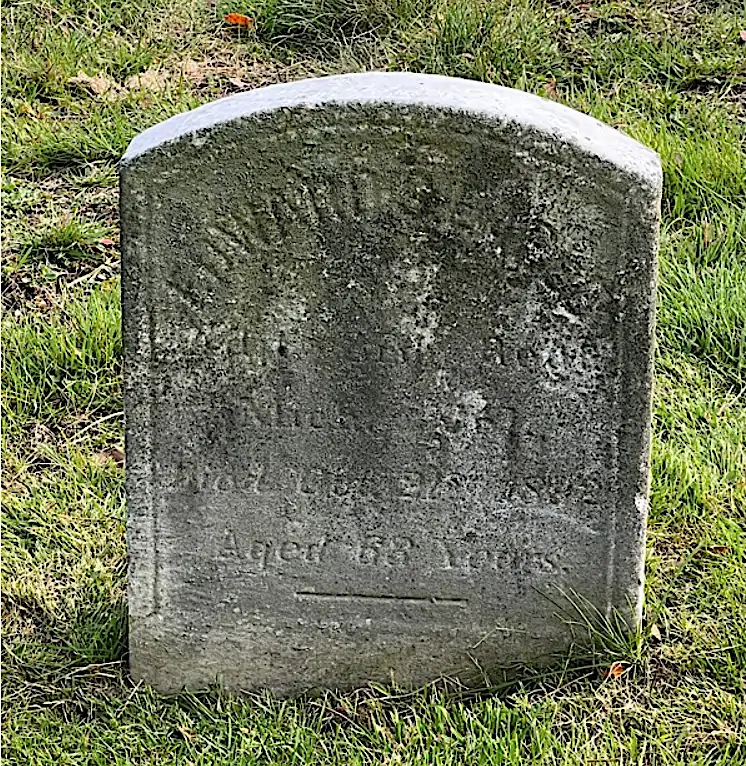
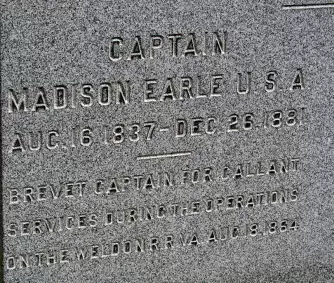
EARLE, MADISON (or MATTHEW) (1837-1880). Captain by brevet; first lieutenant, 12th Infantry, United States Army, Company G. Earle, who was born in New York, was the son of Major John Earle, a veteran of the War of 1812. He was a lawyer as per the New York City Directory of 1857 and the census of 1860 (which also notes that his personal estate was valued at $400).
After enlisting as a private on November 10, 1862, Earle mustered into the 12th Infantry of the United States Army on that date. He rose through the ranks becoming a second lieutenant that November and a first lieutenant on April 27, 1863. On August 18, 1864, he was brevetted to captain “for gallant service during the operations on the Weldon Railroad, Virginia.” His military service continued after the War when was transferred to the 21st Infantry on September 21, 1866, promoted to captain on March 26, 1868, and mustered out on January 1, 1871. In 1877, his application for an invalid pension was granted, certificate 153,217. He died at New York Hospital after a pistol shot to the head. Earle’s obituary in the New York Herald confirms his military service. Frederica Earle, applied for a widow’s pension shortly after his death in 1881, and it was granted, certificate 294,180. Section 25, lot 6939.
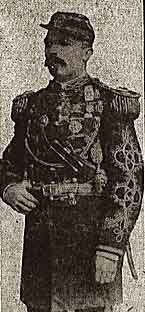
EASON (or EASEN), HENRY (1846-1902). Musician, 31st New York Infantry, Company B; private, 103rd New York Infantry, Company D. Eason was born in New York City. After enlisting as a musician on May 2, 1861, at New York City, he mustered into the 31st New York on May 27 as a drummer boy. According to his obituary in the Brooklyn Daily Eagle, he was injured at the Battle of First Bull Run, Virginia, and was taken to Stone Hospital near Washington, D.C. He was discharged for disability on October 4, 1861, at Alexandria, Virginia, but returned to service after recuperating. On November 25, 1861, he re-enlisted at New York City as a private, mustered into the 103rd New York on April 7, 1862, and was discharged from service at Washington, D.C., on November 25, 1864.
In 1879, Eason’s application for an invalid pension was granted, certificate 200,923. His obituary notes that he was an original member of William Rankin Post #10 of the G.A.R., as of 1870, and served as a drum major in that organization for many years. Mayor Seth Low appointed Eason an inspector of re-surveys for the Board of City Works and then inspector of taps and connections for the Water Department. He continued in the latter position until his death, serving as a city worker for thirty-three years. Maintaining his interest in music, he formed the Eason Drum, Fife and Bugle Corps, a group numbering fifty boys who played at public and military events. The Veterans Schedule of 1890 confirms his Civil War service. His last residence was 14 Linden Street in Brooklyn. He died from a cerebral hemorrhage. Ellinor Eason, who was active in the Women’s Relief Corps and had been president of the Ladies’ Aid Association of McPherson-Doane Post #499 and William Rankin Post #10 of the G.A.R., was awarded a widow’s pension upon his death in 1902, certificate 555,846. Section 85, lot 3330, grave 18.
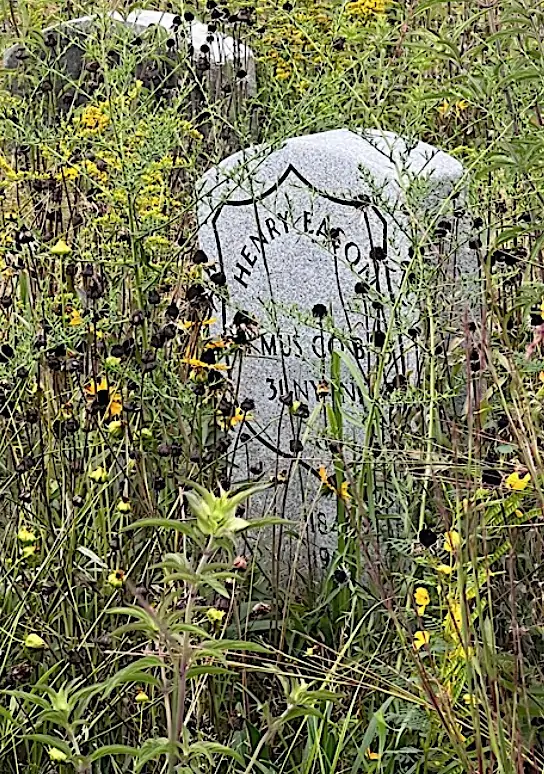
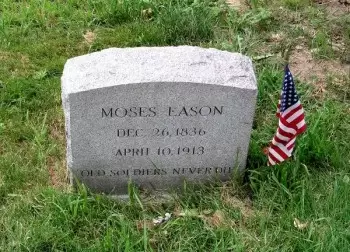
EASON, MOSES (1836-1913). Private, 82nd New York Infantry, Companies A and E. Eason, who was originally from Ireland, came to the United States when he was 20 years old. According to the census of 1860, he was a plasterer by trade. He enlisted and mustered into Company A of the 82nd New York on June 16, 1861, at New York City, and was transferred to Company E on July 15. After being injured and taken prisoner on June 30, 1862, at White Oak Swamp, Virginia, he was paroled on an unstated date, and discharged for disability at Hammond Hospital, Point Lookout, Maryland, on January 5, 1863.
The censuses of 1880 and 1900 indicate that he was employed as a plasterer. In 1899, Eason was awarded an invalid pension, certificate 1,108,974. Although his obituary in the New York Herald indicates Civil War service in the 69th and 82nd Regiments, there is no evidence in his soldier record or pension index that he served in the 69th. Eason died of nephritis. His gravestone reads, “Old Soldiers Never Die.” Section 6, lot 20018, grave 447.
EASSON, PETER (1841-1909). First sergeant, 48th New York Infantry, Company I. Of Scottish origin, Easson enlisted at Brooklyn as a private on September 17, 1861, and mustered into the 48th New York on October 10. He was promoted to corporal and first sergeant of his company during his service and was discharged on an unknown date. His last residence was 640 40th Street, Brooklyn. Section 189, lot 18967, grave 2.
EASTON, ALFRED H. (1835-1871). Corporal, 7th Regiment, New York State Militia, Company H. Born in New York State, he enlisted as a private and served with Company H of the 7th Regiment for 30 days in 1861. A year later, he re-enlisted as a corporal on May 25, 1862, mustered immediately into the same regiment and company, now part of the New York State National Guard, and mustered out after three months on September 5 at New York City. His last residence was 14 Washington Place in Manhattan. He died of pneumonia. Section ?, lot ?.
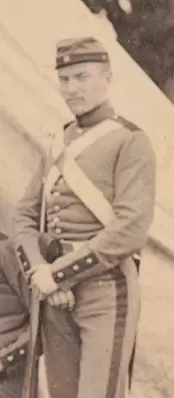
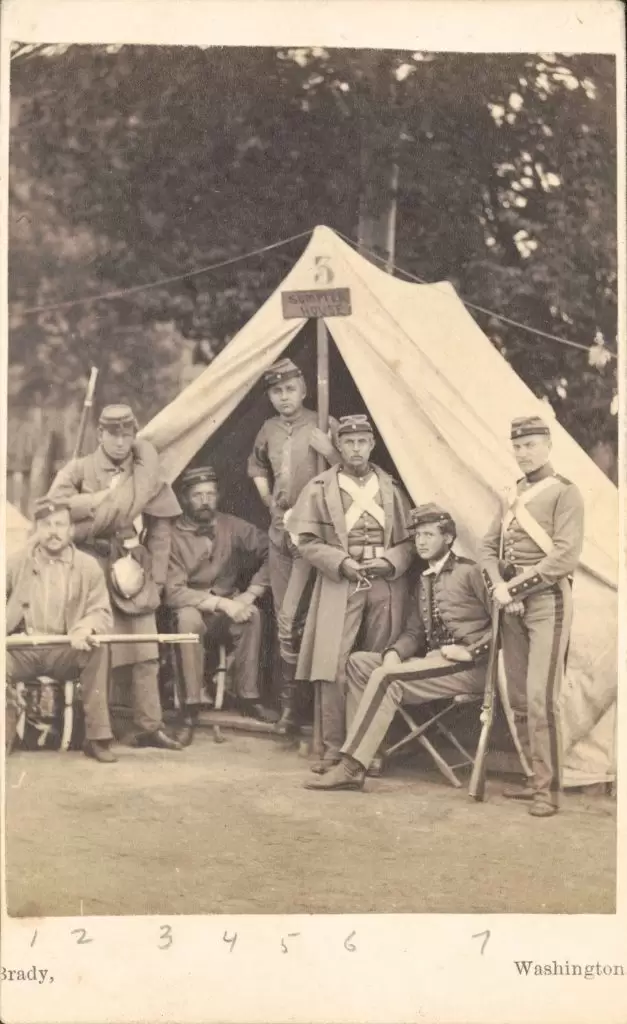
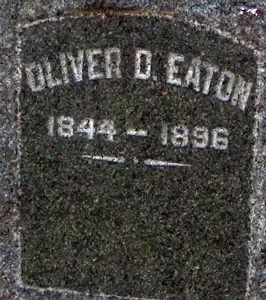
EATON, OLIVER D. (1844-1896). Private, 28th Maine Infantry, Company B. A resident of Farmington, Maine, his birthplace, Eaton enlisted and mustered into the 28th Maine Infantry on October 10, 1862, and mustered out on August 31, 1863, at Augusta, Maine.
Eaton was a member of Erastus Tefft Post #355 of the G.A.R. The treasurer of the Presbyterian Board of Home Missions in New York City, as per the census of 1880, he traveled throughout the country in support of its interests. The Veterans Schedule for 1890 confirms his Civil War service. According to the information on his passport application in 1896, he was 5′ 9½” tall with blue eyes, full face, brown hair and beard, straight nose, full mouth, high forehead and fair complexion. He last lived at 81 Downing Street in Brooklyn, his hometown for 32 years. He died of neuralgia of the heart at a hunting camp in Weld, Maine. Section 204, lot 29758, grave 3.
EBAUGH, THEODORE OLIVER (1843-1913). Private, 7th Regiment, New York State Militia, Company F. Ebaugh was born in Carlisle, Pennsylvania. As per an article in the New York Tribune on October 22, 1856, he was a member of the Arrangements Committee for the Young Men’s Fremont Vigilance Committee, an organization that supported John C. Fremont, the Republican candidate for president. Ebaugh served for 30 days with the 7th Regiment when it was activated in 1861. His pension record indicates that he was a paymaster’s clerk in the United States Army but there are no additional details about that service.
According to the Washington, D.C., Directory for 1870, 1879, 1888, and the census of 1910, he was a clerk at the Department of the Treasury. In 1907, he applied for a pension, application 1,360,143, but no certification number is listed. He last lived at 1915 Calvert Street in Washington, D.C. He died of cancer. Section 100, lot 3341.
EBBETS, EBENEZER W. (1840-1908). Private, 13th Regiment, New York State National Guard, Company F. Ebbets was a native of New York. As per his pension record, he served with the 13th Regiment, New York State National Guard. The 1870 census reports that he was a clerk in the cigar (segar) business; the 1877 Brooklyn Directory reports that he was a clerk and the 1878 Brooklyn Directory lists him as an agent. In 1905, his application for an invalid pension was approved, certificate 1,113,812. He last lived at 3 McDonough Street in Brooklyn. His death was attributed to cystitis. His wife applied for and received a widow’s pension under certificate 678,949. Section 156, lot 23216, grave 3.
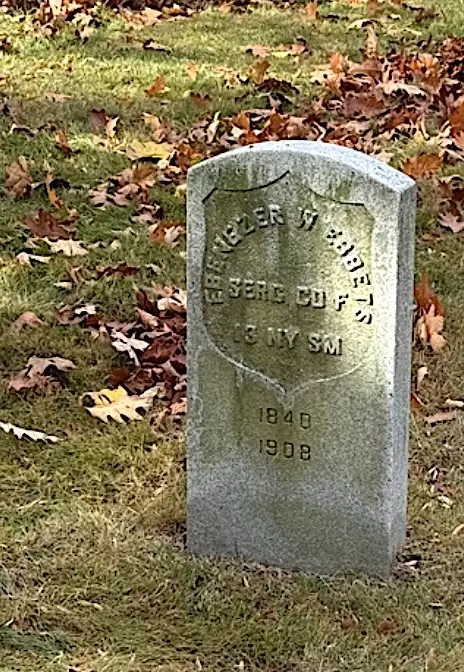
EBLING, JOSEPH E. (1818-1868). Quartermaster, 164th New York Infantry. A native of Pennsylvania, he was a confectioner as per the New York City Directory of 1839-1840 and the census of 1850. Originally on Houston Street, his confection shop was located at 200 Bowery in the 1840s and 1850s. Subsequently, Ebling was the commissioner of streets and lamps as per an article in the New York Herald on January 28, 1856, which reported that a jury was unable to come to a verdict in a case that accused him and other municipal officers of bribery related to the purchase of street sweeping machines. He was acquitted after a second trial. Another article in the New York Evening Express on March 6, 1857, noted that he was charged with the responsibility of receiving proposals for lighting street lamps with gas and furnishing and laying the needed supply-pipes for those lamps for blocks above 79th Street in New York City. On June 4, 1857, the New York Herald reported that Ebling was elected commodore of the Harlem Model Yacht Club. The census of 1860 noted that his occupation was “gentleman” and that he owned real estate valued at $15,000 and had a personal worth of $5,000. On July 7, 1861, his son, Eugene W. Ebling, a corporal in Company A of the 11th New York Infantry was shot in the forehead and instantly killed at the Battle of First Bull Run, Virginia.
During the Civil War, Joseph Ebling enlisted at Albany, New York, as a quartermaster on July 23, 1862, was commissioned into the Field and Staff of the 164th New York that same date, and tendered his resignation on October 2 of that year. He last lived in New York City at the foot of East 121st Street and the Harlem River. His death was caused by heart disease. Section 2, lot 4064.
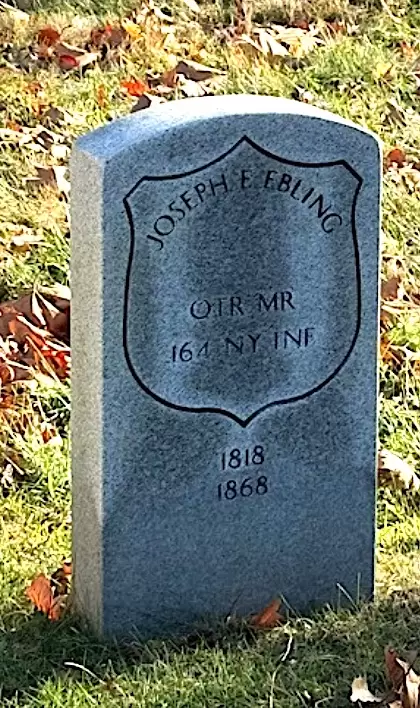
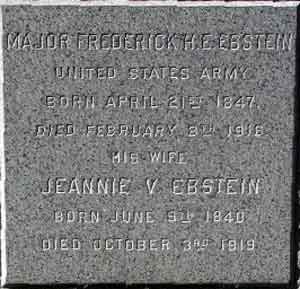
EBSTEIN, FREDERICK HENRY ERNST (1847-1916). Sergeant, 4th Infantry, United States Army, Company H. Of German birth, he immigrated to the United States at the age of 10 and settled with his family in Poughkeepsie, New York, where his father was a physician. A graduate of the Riverview Military Academy there, he was a reporter for the Poughkeepsie Eagle. He enlisted as a private on November 18, 1864, and served as a private, corporal and sergeant with the 4th United States Army.
Promoted to second lieutenant on September 12, 1867, Ebstein served with the 18th Infantry until his discharge on October 19, 1867. Assigned to the 21st Infantry on July 14, 1869, he was promoted to first lieutenant on February 19, 1873, and then served as regimental quartermaster from July 19, 1876-September 30, 1880. He was in command of the U.S. garrison at San Juan Island off the coast of Washington State when the island was in dispute with England; it was later ceded to the U.S. in 1872. Ebstein was promoted to captain in April 1885. On February 27, 1890, he was brevetted captain for “gallant service in actions against Indians at Cottonwood Ranch, Idaho, on July 4, 1877, at Canvas Meadows, Idaho, on August 20, 1877, and at Umatilla Agency, Oregon, on July 13, 1878.” Ebstein also fought in Indian campaigns in Colorado, Nebraska, Arizona, Washington, and Montana.
A veteran of the Santiago Campaign of the Spanish-American War, Ebstein became major by brevet of the 19th Infantry on January 16, 1899, and retired from the military on July 8, 1899. He was a professor of military science at the St. Francis Xavier School in New York City after his retirement and also at the De La Salle Institute. In 1902, he was appointed Deputy Police Commissioner of Brooklyn on the recommendation of Theodore Roosevelt, who had befriended Ebstein in Cuba during the Spanish-American War. Subsequently, he was an auditor in the Department of Finance and then became the receiver of taxes in Manhattan in 1910. His last residence was at 1302 Pacific Street in Brooklyn. Ebstein died of pulmonary edema. Jeannie Ebstein, his widow, applied for and was granted a pension in 1916, certificate 812,110. Section 79, lot 7858.
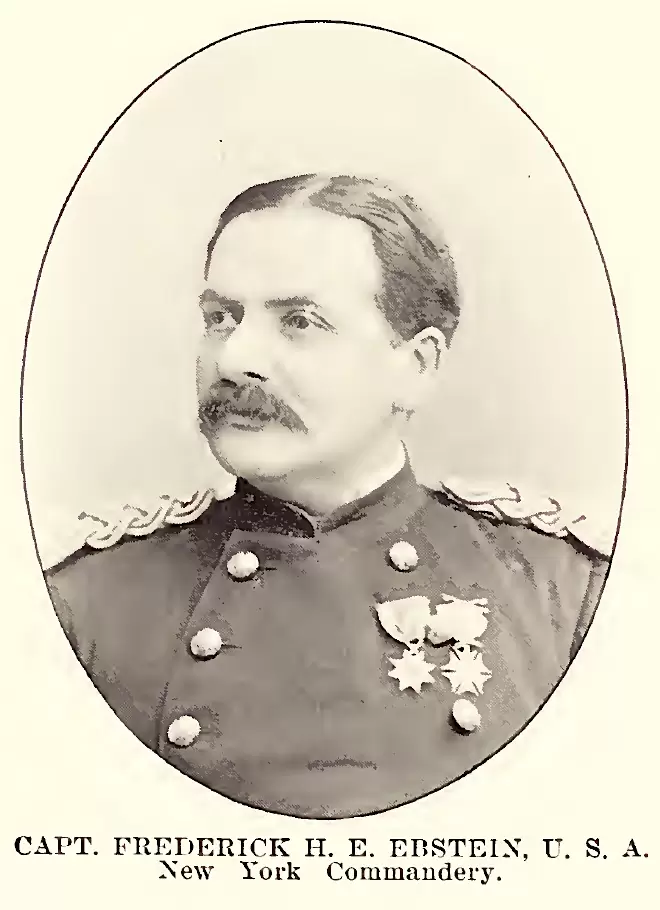
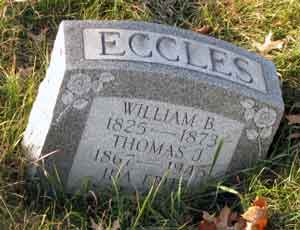
ECCLES, WILLIAM (1825-1873). Corporal, 139th New York Infantry, Company F. Of Irish birth, Eccles enlisted as a private at Brooklyn on August 30, 1862, mustered into the 139th New York on September 9, and was promoted to corporal of his company on November 15. He mustered out on June 19, 1865, at Richmond, Virginia. His last residence was 30 Fleet Street in Brooklyn. His death was caused by pneumonia. Section 17, lot 17245, grave 774.
ECK, CHARLES E. (1826-1879). First lieutenant, 15th New York Heavy Artillery, Companies C and I. German-born, Eck enlisted as a first lieutenant on November 12, 1863, at New York City, and was commissioned into Company C of the 15th New York Heavy Artillery on that day. He was transferred intra-regimentally to Company I before his discharge at Washington, D.C., on August 22, 1864. Eck last resided at The Mountain Home in Orange, New Jersey. His name was listed on the United States Federal Census Mortality Schedule for 1880 which noted that he was a broker. The cause of his death was pleurisy. Section 189, lot 18528.
ECKEL, FREDERICK (1835-1898). Acting second assistant engineer, United States Navy; third sergeant, 7th Regiment, New York State Militia, Company E. Eckel served with the 7th Regiment as a third sergeant for 30 days in 1861. He then entered the Navy as an acting second assistant engineer aboard the USS Saranac, served in the Pacific Squadron under Admiral Bell, and resigned after two years at San Francisco. After the War, he joined the G.A.R. His last address was 4 Fort Greene Place in Brooklyn. His death was attributed to apoplexy. Section 57, lot 13381.

ECKERSON, CHARLES W. (1838-1910). Private, 56th Regiment, New York State National Guard, Company B. Eckerson was born in New Jersey. As per the census of 1850, he lived in Brooklyn. On June 18, 1860, he married Eleanor Porter. During the Civil War, he served for 30 days when the 56th Regiment was activated in 1863. His Draft Registration for July 1863 shows that he was married, lived in Brooklyn and worked at the Navy Yard.
At the time of the 1865 New York State census, Eckerson was married with three young children, lived in Brooklyn and was a baker. The 1875 New York State census states that he lived in Brooklyn with his wife and five children. Subsequently, he was an employee of the Parks Department of New York City and was active in the Mansfield Post # 35 of the G.A.R. The 1900 census reports that he had been married for 40 years, worked as a teamster and lived in Brooklyn with his wife and two children. The 1905 census indicates that he was still working as a driver and lived in Brooklyn with his wife. He last lived at 152 North 10th Street in Brooklyn. Section 111, lot 14510.
ECKHARDT (or ECKHARD), JOHN P. (1825-1892). Private, 29th New York Light Artillery, Battery A. Eckhardt enlisted at New York City as a private on July 24, 1861, mustered into Battery A of the 29th New York Light Artillery on August 12, and mustered out on August 3, 1864. His pension record indicates prior service in Battery A of the 1st Battalion, New York Light Artillery. In 1879, his application for an invalid pension was granted, certificate 360,921. He last lived at 38 Centre Street, New York City. In 1905, Margaret Eckhardt, who is interred with him, applied for and received a widow’s pension under certificate 628,206. Section 153, lot 27262.
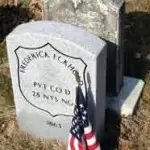
ECKHOLD (or EKHOLD), FREDERICK (or FRIEDRICH) (1836-1863). Private, 28th Regiment, New York State National Guard, Company D. Eckhold served for 30 days in 1863 with the 28th Regiment. He died in Brooklyn from typhoid fever on September 7, 1863. Section 115, lot 13536 (Soldiers’ Lot), grave 72.
ECKSTEIN, MICHAEL (1843-1879). Private, 68th New York Infantry, Company A. A native of Bavaria, he enlisted as a private at New York City on December 1, 1863, and mustered into the 68th New York, also known as the 2nd German Rifles, the same day. Serving in the Washington, D.C., area until the spring of 1862, the regiment was then ordered to the Mountain Department and became part of Fremont’s forces. He served the remainder of the War and mustered out on November 30, 1865, at Fort Pulaski, Georgia. According to the 1870 census, he was a tailor by trade. His last residence was at 210 Forsyth Street in Manhattan. Eckstein died of Bright’s disease. Isabella Eckstein, his widow, applied for and received a pension in 1890, certificate 348,011. Section 15, lot 17263, grave 2477.
EDDY, ADFUR (1827-1907). Unknown soldier history. Eddy, who was born in Rhode Island to a prominent family, served in a Rhode Island regiment during the Civil War according to an obituary in the Brooklyn Standard. Further details related to his military service are unknown although it appears that his regiment did not do federal service during the Civil War. According to an article in The New York Times, published on September 4, 1864, Eddy, a resident of 125 Front Street in Manhattan, paid for a substitute for the draft.
A personal description written on a notarized passport application in 1872, indicated that Eddy was 5′ 9½”tall, with a bony face characterized by blue eyes, brown hair, broad forehead, a prominent nose, and a small mouth and chin. He was a manufacturer of cotton goods in Providence, Rhode Island, and then became a member of the B. G. Arnold & Co. coffee and tea firm in New York City. The 1880 census listed him as a retired merchant who was living in Brooklyn. His last residence was 106 Sixth Avenue, Brooklyn. His death was caused by nephritis. Section 196, lot 30998, grave 1.
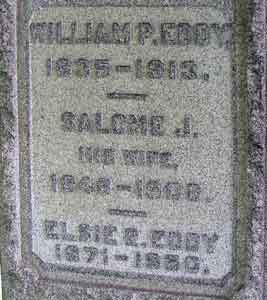
EDDY, WILLIAM P. (1835-1913). Private, 1st Massachusetts Heavy Artillery, Company E. A Massachusetts native, Eddy was a farmer and resident of Dudley, Massachusetts, when he enlisted there on August 8, 1862, and immediately mustered into the 1st Massachusetts. As per his muster roll, he was 5′ 5½” tall with blue-gray eyes, brown hair and a dark complexion. Eddy was severely wounded on May 19, 1864, at Spotsylvania Court House, Virginia, and had his right foot amputated. He was listed as absent for wounds on his muster roll for May and June of 1864. He was officially discharged for wounds on July 22, 1864, at Columbian Hospital in Washington, D.C. The report of the surgeon indicated that he was unfit for duty in the Veterans Corps because of his total disability. His final account notes that he was paid a bounty of $25 and was still due the next installment of $75; his clothing account was settled. On August 10, 1864, his application for an invalid pension was granted, certificate 35,128.
Eddy married in 1866 and lived in Brooklyn after the War. As per the 1871 Brooklyn Directory, the 1880 census, the 1884 Brooklyn Directory, the censuses of 1900 and 1910, and the 1902 New York State Census, he was in the tape measure manufacturing business located at 345-352 Classon Avenue in Brooklyn. That business, George M. Eddy and Co., of which he was a partner and which made tapes of cotton, linen and steel, was started by his older brother in 1845. The enterprise gained renown in Brooklyn, had business throughout the North America and exported to the West Indies, India and Australia. In addition to tapes, the concern manufactured hair pins, button hooks and corkscrews. George Eddy was well-known for inventing the machinery used in the production of the tapes while William P. Eddy was renowned for his business acumen and integrity. Eddy continued to challenge the government bureaucracy which only found him to be partially disabled. In 1889, he submitted the following affidavit describing his ordeal:
I was a tough young farmer in Mass [achusetts]. We had as fine a farm as man would care for. I left (from the hayfield with the crops half gathered) and the feeble old folks to the care of a younger brother who was not capable of managing the property….I was shot by bullet and buckshot in our first battle with [Confederate general Richard] Ewel[l] in Spotsylvania. The bullet ripped through the ball of the foot tearing the joints apart as far back as possible. The buckshot came out of the ankle….I put a handkerchief around it and was bundled into an ambulance was landed at [a] field hospital bleeding all this time till I was unable to hold my head up. I laid on the ground all that night with no care and only water no nourishment. That day I had the ride from there to Fredericksburg in an Army wagon. A cup of chocolate on arrival. No care yet till the next after-noon…foot as black as a boot. Amputation by Choparts style. That night on transport, next day on ocean, day after at Washington with a four mile ride to Columbia[n] Hospital. For two weeks I have not had a square meal. I was good as a dead man for three weeks…Being in such shape I had to make a change from the farm which we had to sell and I was four years getting into shape to get a living….But aside from the loss of the foot I have never recovered from the damage I got in the Army and nervous debility resulting from Army life….We enabled—by our loss—the government to [be] strong and able. Now she is able to help us who are weak….Can pensions compensate a man for years of neuralgia, shaking nerves, indescribable distress and the inability to do and act as other men? Can it pay a man for being in his second childhood from his thirty-fifth year to the day of his death?
Eddy was active in the U. S. Grant G.A.R. Post #327, which he joined in 1896. Eddy’s obituary in the New York Herald confirms his Civil War service. His last address was 272 Clifton Place in Brooklyn. He died from cancer. Section 5, lot 20126.
EDEN, JAMES ANDERSON (1843-1925). Musician, United States Marine Corps. On February 7, 1859, Eden, at age 15, 5′ 11″, brown haired with fair complexion and gray eyes, enlisted in the U.S. Marine Corps at Brooklyn, his birthplace, for a period of five years, ten months as a “boy bound to learn music…” He was sent to the marine barracks at Brooklyn the same day and on February 15 transferred to barracks in Washington, D.C. On January 12, 1860, he was given the rating of fifer and transferred to the marine barracks at Norfolk, Virginia. On February 2, he was transferred to the USS Pennsylvania, returning to the base at Norfolk on September 25. On October 1, he was transferred to the USS Richmond, where he saw service during the blockade of the Mississippi River and the Battle of Mobile Bay, Alabama, and contracted malaria. On February 10, 1865, he was transferred back to the marine barracks in Brooklyn, where he was discharged on March 4 at the expiration of his enlistment.
After the War, Eden lived in Brooklyn, New York City, Connecticut and New Jersey, eventually settling permanently in Brooklyn around 1890. He founded and ran the Eden Specialty Company, 4314 Third Avenue, Brooklyn, which manufactured carpenters’ levels and squares. A member of Ulysses S. Grant Post # 327, G.A.R., there is a marker from the organization on his grave. In 1890, he applied for and received a disability pension, Navy certificate 11,466. His last residence was 419 37th Street, Brooklyn. After his death due to a cardiac condition in 1925, Lillian Eden applied for and was awarded a widow’s pension, certificate, 11,466. Section 154, lot 27249.
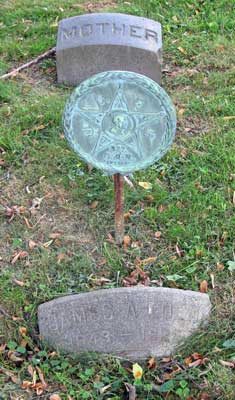
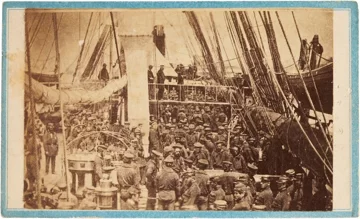
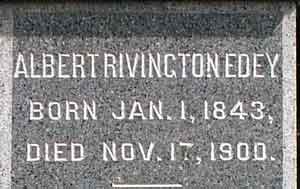
EDEY, ALBERT RIVINGTON (1843-1900). First lieutenant, 37th Regiment, New York State National Guard, Company I. Born in New York City, he enlisted there on June 24, 1863, was commissioned into the 37th National Guard, and mustered out at New York City on July 22.
According to the censuses of 1880 and 1900, he was a stockbroker. As per an article about his death, he was associated with the firm of Charles E. Edey & Son at 2 Wall Street in Manhattan. Edey, who was separated from his wife and family, was a boarder at 121 Lincoln Place in Brooklyn at the time of his death. A November 20, 1900, article in the New York Daily Tribune indicated that his sudden death was due to natural causes, possibly apoplexy. However, his death was shrouded in controversy. The Evening Telegram of November 20 reported that Edey’s waistcoat was buttoned, covering up the bullet hole that was discovered by the undertaker. In addition, a small rifle was standing in a corner of the room at the boarding house. No one in the house heard a gunshot and the waistcoat bore no bullet hole. A subsequent article in the Brooklyn Daily Eagle on November 21, 1900, noted that Edey carried a poem and news-clipping about suicide in the pocket of his clothing and confirmed that his death was attributed to a rifle shot to his heart. Section 94, lot 359.
EDEY, HENRY (1833-1877). Private, 7th Regiment, New York State National Guard, Company K. A Brooklyn native, Edey was a clerk at the time of the census of 1850. When he applied for a passport in 1856, he was 5′ 7″ tall with a high forehead, large nose, blue eyes, long chin, light brown hair and a fair complexion. During the Civil War, he enlisted as a private at New York City on May 25, 1862, the same date that he mustered into the 7th Regiment for its activation of three months. He was discharged on September 5, 1862, at New York City. He died in Croton Falls, New York. Section 34, lot 384.
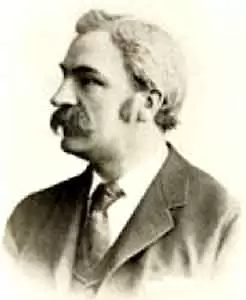
EDSON, JARVIS BONESTEEL (1845-1911). Acting third assistant engineer, United States Navy; private, 23rd Regiment, New York State National Guard, Company D. Edson was born in Janesville, Wisconsin, and educated at New York University. According to his obituary in The New York Times, Edson served as a private at Gettysburg, Pennsylvania, with the 23rd New York Volunteers and later entered the United States Navy as an engineer. His service with the 23rd National Guard was for 30 days in 1863. He entered the Navy as an acting third assistant engineer on November 1, 1864, and was ordered to South America where he served for three years. During this stint, he helped to seize the custom house and defend it and the American Consulate during the rebellion at Montevideo, Uruguay, and performed various tasks that were unusual for a Navy engineer. He was honorably discharged on August 27, 1868.
An inventor, Edson held numerous patents including a pressure recording gauge, a method for drying cotton by using compressed air, and artificial ivory. Active in professional and maritime organizations, he was a member of the American Society of Mechanical Engineers, the American Society of Naval Engineers, and the American Society of Naval Architects and Marine Engineers. A charter member of the New York Commandery (a military organization dedicated to preserving loyalty to the Union that was established after the assassination of President Abraham Lincoln), where he held the position of treasurer, he also held the same position in the General Commandery of the Naval Orders of the United States. Edson was a member of the New York and Columbia Yacht Clubs. His last address was 313 West 74th Street in Manhattan. Edson died of bronchitis. Section 53, lot 21405, grave 5.
EDWARDS, ALEXANDER (1814-1871). Private, 174th New York Infantry, Company H; 162nd New York Infantry, Company H. Originally from Scotland, Edwards owned a granite yard that bore his name on the corner of Van Brunt and Sedgwick Streets in Brooklyn as per a listing the Brooklyn Daily Eagle on May 23, 1860. The census of 1860 indicates that he was a stone-cutter whose real estate was valued at $8,000 and his personal worth was $5,000. The Brooklyn Directory for 1862 shows that he had a stone yard on Fifth Avenue and 25th Street in Brooklyn.
During the Civil War, he enlisted as a private at New York City on October 24, 1862, mustered into the 174th on November 10, and transferred into the 162nd New York on February 17, 1864, from which he deserted on September 1, 1864. According to the census of 1870, he had a marble works. At that time, his real estate was valued at $25,000, and his personal estate at $2,000. He last resided at 490 Hicks Street in Brooklyn. “Softening of the brain” is listed as the cause of his death. Section 112, lot 14526.
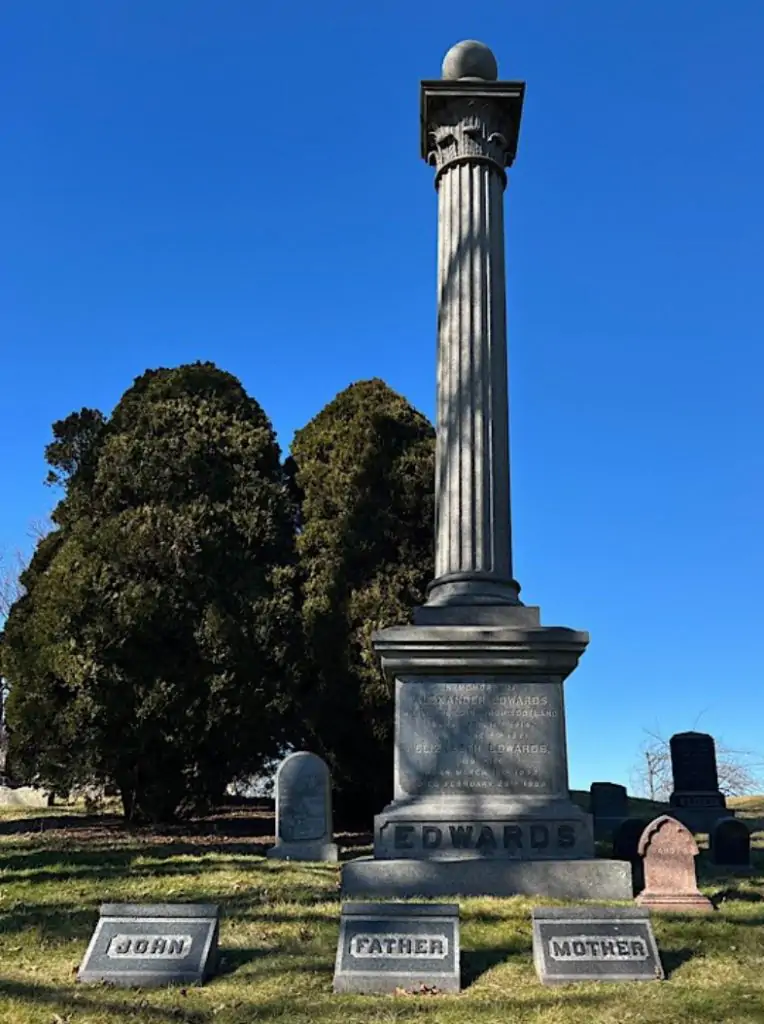
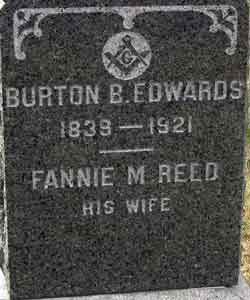
EDWARDS, BURTON BARNUM (1839-1921). Private, 36th Pennsylvania Infantry, Company G. A Pennsylvania native and resident of Bradford County there, Edwards enlisted as a private on July 4, 1863, mustered into Company G of the 36th Pennsylvania that day, and mustered out on August 11, 1863.
According to the census of 1870, he lived in Pennsylvania; according to the census of 1880, he relocated to Brooklyn and was a jeweler there. His name was listed in the Brooklyn Directory of 1888-1890 as a broker. As per the censuses of 1900 and 1910, and his obituary in The New York Times, he was a lumber merchant; he had retired from business by 1920. A Freemason, his last residence was 9546 116th Street in Richmond Hills, New York, where he died from malnutrition. Section 14, lot 10935.
EDWARDS, JR., JOHN B. (1837-1886). Private, 7th Regiment, New York State National Guard. Edwards was born in New York. As per the census of 1850, he lived in New York City with his parents and siblings; at the time of the 1860 census, he was working as a clerk. As per the 1890 Veterans Schedule, which was completed by his widow, Emma Olssen Edwards, John Edwards served for three months with the 7th Regiment during the Civil War.
The 1868 Jersey City Directory lists Edwards as a bookkeeper. The 1870 census and the 1872 Jersey City Directory note that he lived in Jersey City, New Jersey, and worked as a clerk. According to the 1880 census, he was living in Newark, New Jersey, with his wife and children and working as a bookkeeper. He was the brother-in-law of William E. Olssen (see). As per his obituary in the New York Herald, he was an employee of the Broadway Insurance Company in New York City. His obituary in the New York Sun notes that his funeral was held at the Reformed Church in Woodside, New Jersey, where he last lived. Section 101, lot 4436.
EDWARDS, JOSEPH (1840-1923). Private, 9th New York Infantry, Company A. Edwards was born in Liverpool, England, and enlisted at New York City on May 4, 1861, for a term of two years. At that time, he was employed as a machinist, stood 5′ 4½” tall, and had a fair complexion, blue eyes and brown hair. On August 19, 1861, he was discharged for disability after a very long and difficult march left him unfit for duty. A machinist as per the census of 1880, he repaired machinery according to the census of 1900, and was listed as a manufacturer of machinery on the 1920 census. In 1908, his pension application was accepted, certificate 1,150,830. His last residence was 279 Hancock Street in Brooklyn but he died at Atlantic Highlands, New Jersey, of arteriosclerosis. Section 113, lot 17659, grave 5.
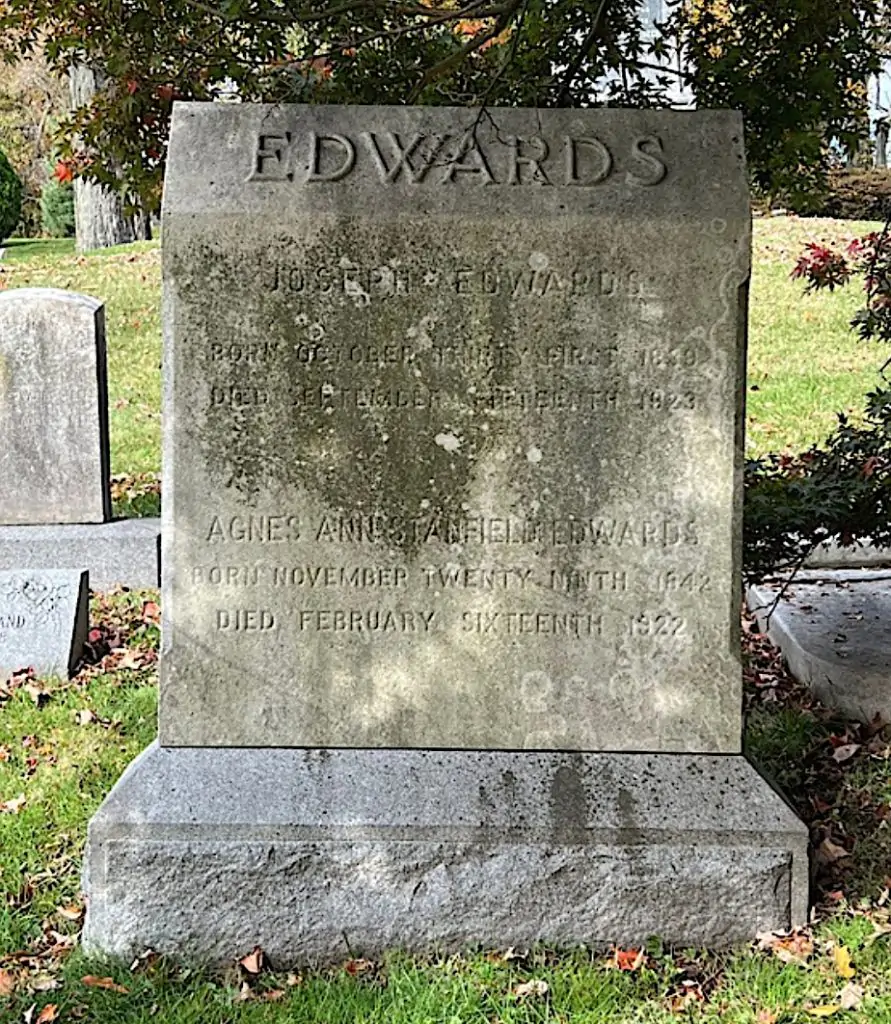
EGBERT, STEPHEN E. (1829-1879). Right general guide, 71st Regiment, New York State Militia. Originally from New York City, Egbert enlisted in 1861 as a sergeant. He was the right general guide for 71st New York State Militia for its three month activation and was assigned to the Field and Staff. He mustered out at the expiration of his enlistment. According to the United States Mortality Schedule for 1880, he was a butcher by trade. His last residence was 521 East 120th Street in Manhattan. The cause of his death was phthisis. Section 45, lot 6268.
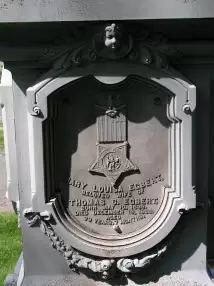
EGBERT, THOMAS C. (1839-1913). Private, 114th Pennsylvania Volunteer Infantry, Company D. Born in South Bend, Indiana, he enlisted as a private at Philadelphia, Pennsylvania, on August 11, 1862, and mustered immediately into the 114th Pennsylvania Infantry. Egbert was wounded twice, the first time on October 31, 1863, while on the skirmish line at Auburn Run, Virginia, where he was wounded in the thigh on the left side. He was sent to Judiciary Square Hospital in Washington, D.C., where he was treated for his wound and the gangrene that set in. The second time he was wounded in action was on April 2, 1865, at Petersburg, Virginia. Sustaining a gunshot wound to his left ankle, he was treated in a hospital at City Point, Virginia. He mustered out on May 29, 1865, at Arlington Heights, Virginia, while still hospitalized, and was honorably discharged for disability the following July 7. His application for an invalid pension was granted July 19, 1865, under certificate 66,875.
After the War, Egbert returned to Philadelphia but then moved to Brooklyn where he worked for the Brooklyn Rapid Transit as a railroader until his retirement. Prior to his retirement, he routinely missed work because of his ankle wound. Egbert was a member of the G.A.R. He last resided at 209 23rd Street, Brooklyn. Mary Egbert applied for and received a widow’s pension, certificate 766,359. Section 65, lot 5242.
EGERTON, GEORGE STEARNS (1835-1883). Second lieutenant, 11th Pennsylvania Cavalry, Company C. Originally from Vermont, Egerton was employed as a clerk in Troy, New York, according to the 1850 census. The 1857 New York City Directory lists him as an accountant but he returned to Troy where the 1860 census indicates that he was a bookkeeper. After enlisting at Philadelphia, Pennsylvania, and mustering in as a first sergeant on August 17, 1864, he was promoted to sergeant on November 3, 1864, to first sergeant on March 1, 1865, and to second lieutenant on August 8, 1865, but did not muster in at that rank. On August 13, 1865, he mustered out at Manchester, Virginia.
In 1870, he was living in Jersey City, New Jersey, where he worked as a railroad agent. In 1880, the census reports that he was living in Brooklyn and suffered from rheumatism; his wife was living at Norfolk, Virginia, at that time. A Freemason, Egerton died at the New York State Home for Soldiers and Sailors in Bath, New York, where his records show that he suffered from rheumatism contracted during his military service. In 1887, Hannah Egerton’s application for a widow’s pension was granted, certificate 274,313. Section 61, lot 13544.
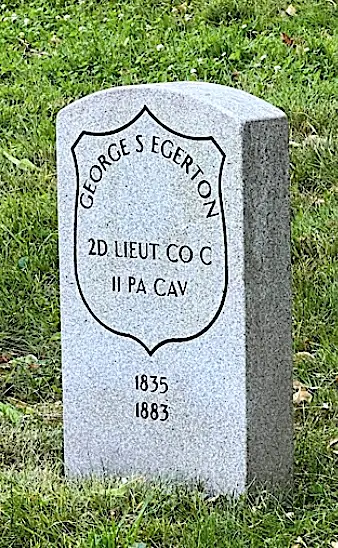
EGGERS, HENRY (1838-1871). Private, 39th New York Infantry, Company K; 5th New York Veteran Infantry, Company B. Born in Germany, Eggers enlisted at New York City on January 4, 1864, as a private, and mustered immediately into the 39th New York. He was discharged for disability at Stevensburg, Virginia, on February 24. Upon re-enlisting at New York City on March 24, 1865, he mustered into the 5th Veterans where he served until he mustered out at Hart’s Island, New York Harbor, on August 21 of that year. He last lived in New York City. The cause of his death was tuberculosis. Section 187, lot 20020.
EHRET, ADOLPH (1832-1875). Private, 1st New York Infantry, Company K. Of German origin, Ehret was listed as a printer on the census of 1850; the 1860 census reports that he was a lithographer. During the Civil War, he enlisted on April 22, 1861, as a private, and mustered into the 1st New York a day later. He deserted on or about August 1 of that year while on furlough. The New York City Directory for 1868 lists him as a printer. He last lived at 165½ Stanton Street in Manhattan. Ehret died of heart disease. Section 115, lot 4196, grave 755.
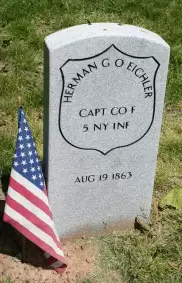
EICHLER, HERMAN G. O. (1831-1863). Captain, 5th New York Infantry, Companies E, H, I, and F. A German native, Eichler was an attorney as per the 1857 New York City Directory. He resided at 21 Christie Street in Manhattan at the start of the Civil War. He enlisted as a third sergeant at New York City on April 25, 1861, and mustered into Company E of the 5th New York on May 9. On September 13, 1861, he was promoted to second lieutenant and rose to first lieutenant on September 24, effective upon his transfer to Company H. He transferred into Company I on July 26, 1862. After becoming sick in August of 1862, he asked for a sick leave because he didn’t want to be discharged from “the regiment to which I am attached and devoted.” On September 24, 1862, he became captain of Company F but was not commissioned, and resigned the next month on October 4. He died of consumption on August 19, 1863. Section 115, lot 13536 (Soldiers’ Lot), grave 22.
EICKE, FRANK (1840-1874). Private, 11th Regiment, New York State National Guard, Company C. After he enlisted in 1863 as a private for a period of 30 days, he mustered into Company C of the 11th Regiment. Further details of his service are unknown. Eicke last lived at 11 5th Street, Brooklyn. Section 105, lot 3470.
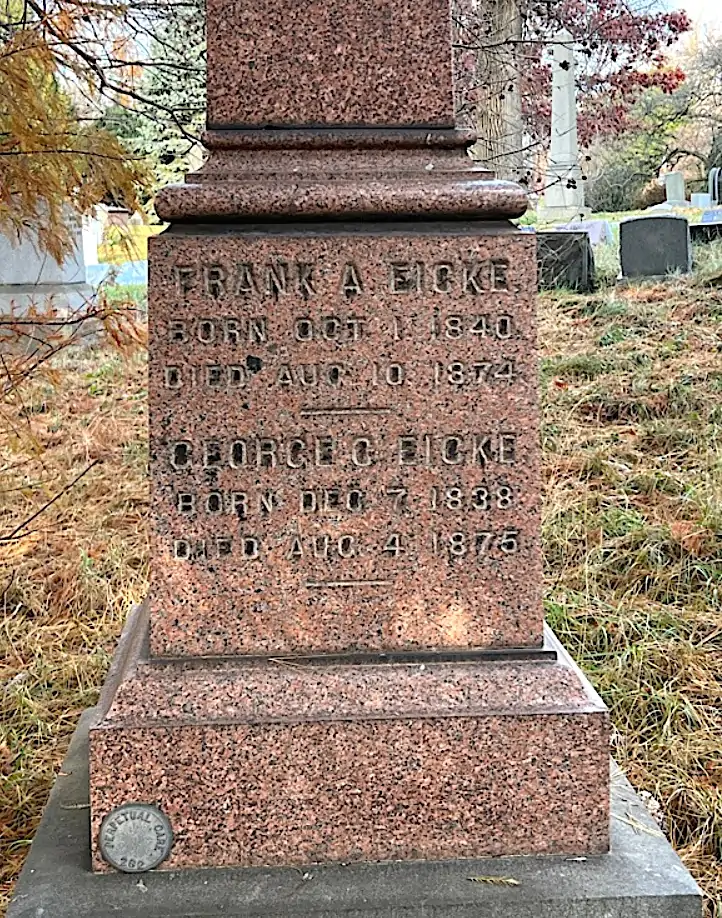
EICKHOFF, ANTHONY (1827-1901). Commissary general. Born in Westphalia, Prussia, he taught school there before immigrating to the United States during the German Revolution of 1846. He founded The St. Louis Zeitung, edited the Nordwestlichen Demokrat in Dubuque, Iowa, and edited the Staats-Zeitung in New York. During the Civil War, he was Commissary General for New York troops, and after the War, was a member of the New York State Assembly, New York City Coroner, and New York City Fire Commissioner. He served in Congress as a Democrat from 1877-1879. His last address was 854 West End Avenue in New York City. His death was caused by pancreatic cancer. Section K, lot 15000.
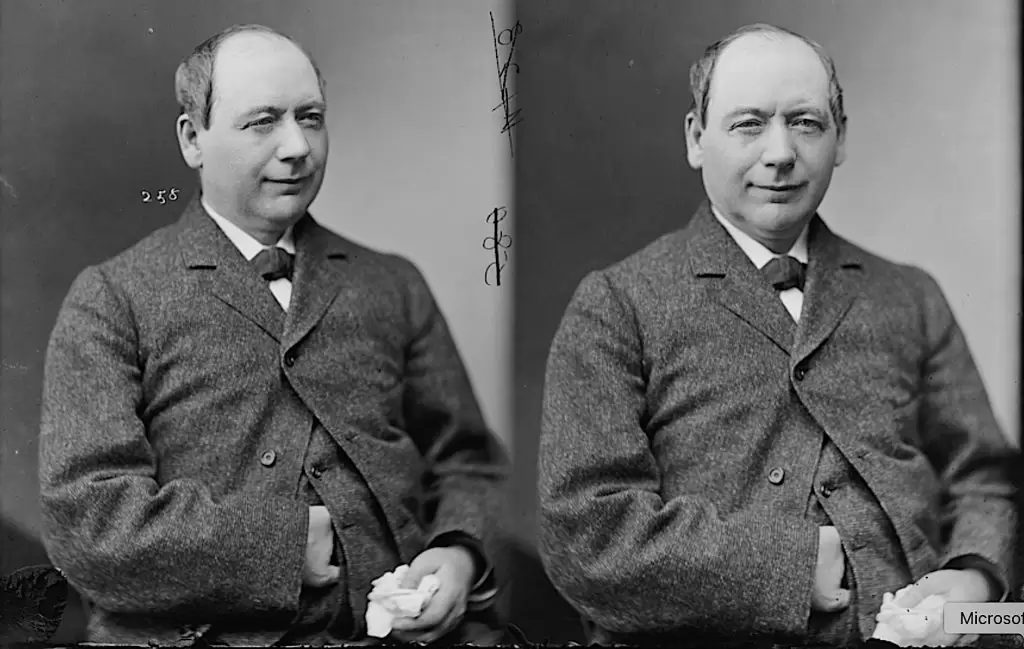
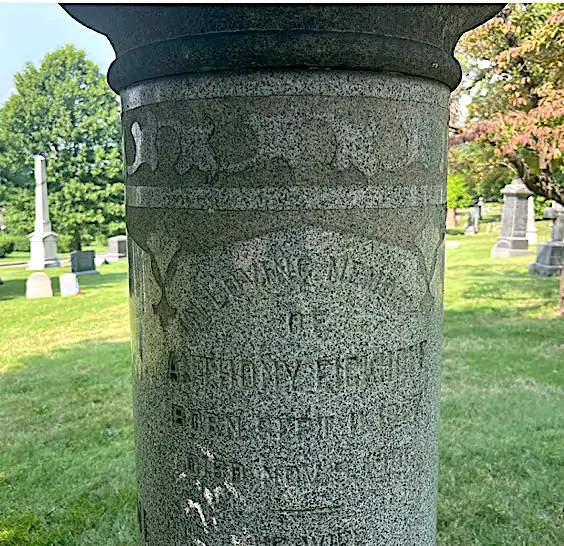
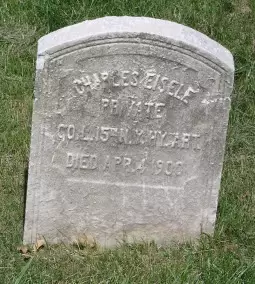
EISELE, CHARLES (1842-1900). Private, 15th New York Heavy Artillery, Companies K and L. A native of Germany, he enlisted and mustered into Company K of the 15th Heavy Artillery on September 28, 1863, at New York City. At some point, he transferred to Company L before he mustered out on August 22, 1865, at Washington, D.C. In 1891, his application for an invalid pension was approved, certificate 921,143. He last lived at 559 Driggs Avenue in Brooklyn. He died of Bright’s disease. Elizabeth Eisele applied for and received a widow’s pension in 1900, certificate 505,015. Section 136, lot 28307, grave 79.
EISEMANN (or EISEMAN), HENRY (1844-1891). Sergeant, 58th New York Infantry, Company I; corporal, New York United States Rifles, Company C; private, 55th Regiment, New York State National Guard, Company E. A German native, Eisemann enlisted as a corporal and mustered into the New York Rifles on October 2, 1861. The next month, he transferred into the 58th New York on November 1. At some point, he was promoted to sergeant but was reduced in rank to private on May 2, 1863, and deserted on July 7 at Summitsburg, Pennsylvania. However, that desertion may be listed in error because he served as a private with the 55th Regiment when it was activated for 30 days from June 24 through July 27, 1863.
According to the 1870 census, Eisemann was a chair-maker whose personal estate was valued at $600; the 1880 census lists him as a picture-frame maker. He was then listed as a carriage-maker in the New York City Directory of 1888. The Veterans Schedule of 1890 confirms his Civil War service. He last resided at 285 Broome Street in Manhattan. His death was caused by pneumonia. Mary Eiseman (his pension index spells his surname with one “n”) applied for a widow’s pension in 1893, application 571,874, but it was not certified. Section 178, lot 12071.
EISKAMP, DIEDRICH (1843-1925). Unknown soldier history. Eiskamp was born in Germany. While nothing is recorded related to his military service in Civil War databases, his Find A Grave entry notes that he served as a corporal in the 3rd United States Infantry, Company D. No years of service are provided. However, according to New York State Senate records, he later served as commander of Cushing Post #231 of the Grand Army of the Republic (G.A.R.), a fraternal order exclusively for veterans in the Union military services. His membership in the G.A.R. is proof that he must have served in the military during the Civil War. That powerful lobbying organization focused on veterans’ rights, including securing pensions for Union veterans. As reported in The Brooklyn Daily Times of June 21, 1919, Eiskamp attended the annual encampment of the G.A.R. for New York State and Canada, representing the Cushing Post.
As per the 1900 census, he was living on Sixth Avenue in Brooklyn with his brother, Frederick (a grocer), and his brother’s wife and two daughters. Diedrich was documented, at that time, as a government laborer. He continued to be noted as living with them in Brooklyn, later on East 3rd Street, through the 1920 census.
Eiskamp was naturalized as a citizen of the United States in Kings County in 1896. The records of his naturalization note his occupation as a retired non-commissioned officer. As per Army enlistment records, he re-enlisted in 1896. He died in Brooklyn on February 28, 1925, at approximately the age of 81; according to Green-Wood’s interment records, his last residence was at 248 East 3rd Street and his cause of his death was “cardiac.” His death certificate noted that he had lived in the United States for 65 years. Section E, lot 35943.
EITEL, CHARLES L. (1843-1897). Private, 2nd Infantry, United States Army, Companies H, G, and B. Of German birth, he enlisted as a private and mustered into Company H of the 2nd Infantry, United States Army. During his service, he transferred within the regiment to Company G, and then to Company B. According to the census of 1870 which listed his personal worth at $200, and the New York City Directories for 1880 and 1889, he was employed as a printer. Eitel last resided at 200 West 108th Street in Manhattan. His death was attributed to phthisis. Section 85, lot 5281, grave 4.
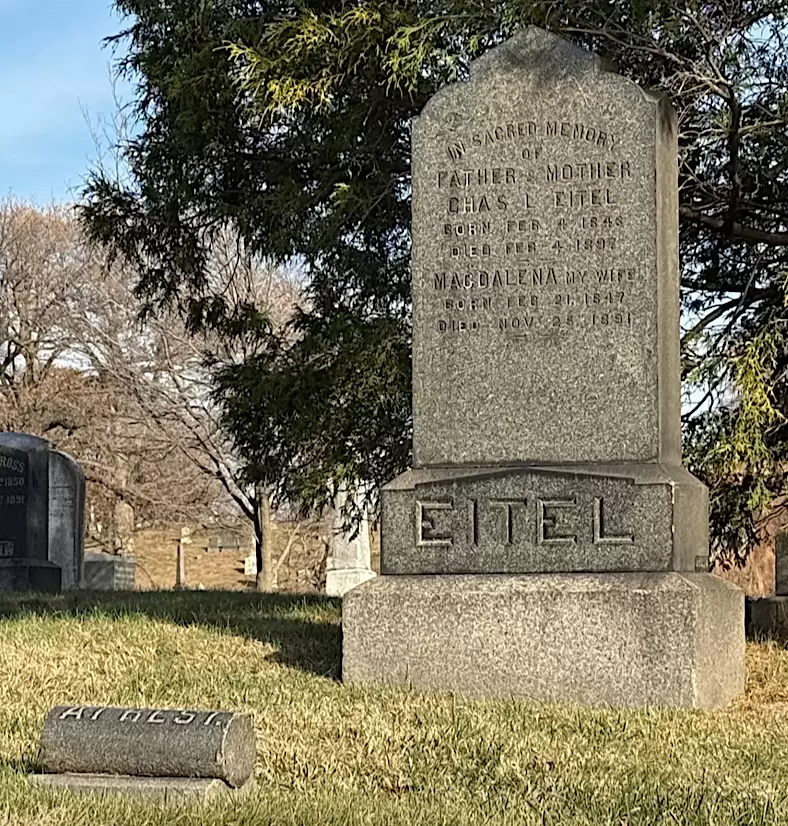
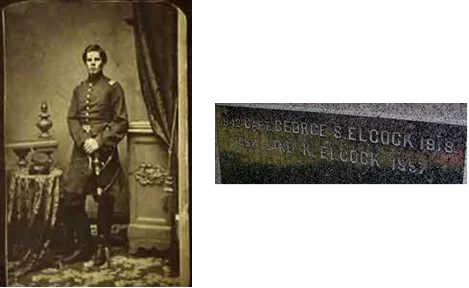
ELCOCK, GEORGE SHARP (or SHARPE) (1843-1918). Captain, 84th New York (14th Brooklyn) Infantry, Company E. A New York native, he was 5′ 8″ tall with grey eyes and light hair. At the onset of the Civil War, Elcock enlisted at Brooklyn on April 18, 1861, was commissioned into the 14th on May 23 as a second lieutenant, and was promoted to first lieutenant on August 4, 1861. On November 14, 1861, his actions at Upton’s Hill, Virginia, were recognized when the members of Company E presented him with a ceremonial sword and silk sash with a gold belt as symbols of their esteem. He rose to captain on February 22, 1862 (but was not commissioned).
Captured in action on August 29, 1862, at Groveton, Virginia, he was exchanged on December 7, 1862. Apparently unaware that Elcock was taken prisoner, the 14th Brooklyn incorrectly listed Elcock as among the dead in an article about the regiment in the Brooklyn Daily Eagle in September 1862. According to his muster roll, he was on recruiting duty from December 30, 1863, through April 17, 1864. He mustered out on June 6, 1864, at New York City. As per his biography for the Order of the Loyal Legion, a patriotic organization of which he was a member, he served in the Fredericksburg and Chancellorsville Campaigns in Virginia and in the Gettysburg and Mine Run Campaigns. His brother-in-law, Addison D. Martin (see), also served in the 14th Brooklyn.
The 1870 census lists Elcock in the iron business; the 1880 census lists him in steam heating as does the Brooklyn Directory for 1881. In 1879, his application for an invalid pension was granted, certificate 1,170,149. Elcock was elected alderman as a Democrat in 1887 and served from 1888-1889. An article in the Brooklyn Daily Eagle on February 28, 1889, reported that Alderman Elcock was head of a committee that was working jointly with the Grand Army of the Republic (G.A.R.) to archive the records detailing the role of Brooklyn in the Civil War. The Veterans Schedule of 1890 confirmed his Civil War service. As per an article in the Brooklyn Daily Eagle on June 5, 1892, Elcock, who lost his bid for re-election as alderman, was appointed secretary of the subway commission at a salary of $2,500 per year. That same article noted that he was highly respected and a member of the G.A.R. He was also the second vice president of the 14th’s Veterans’ Association.
A subsequent article in the Brooklyn Daily Eagle on November 8, 1895, reported that Elcock was subpoenaed by a committee investigating the misappropriation of funds related to the War memorial records. The New York Herald, which broke the scandal, reported on November 10, 1895, that Elcock had refused to testify and had stated, “…I decline to submit myself as a witness on the ground that I do not consider that the committee has any authority to subpoena, call or examine witnesses.” The results of the aforementioned investigation are not known. At the time of the census of 1900, the Brooklyn Directory of 1901, and the Brooklyn Census of 1915, he was a clerk. He last lived at 26 Halsey Street in Brooklyn. The cause of his death was myocarditis. Jane Elcock applied for a widow’s pension in 1920, application 1,150,974, but it was not certified. Section 132, lot 34130.
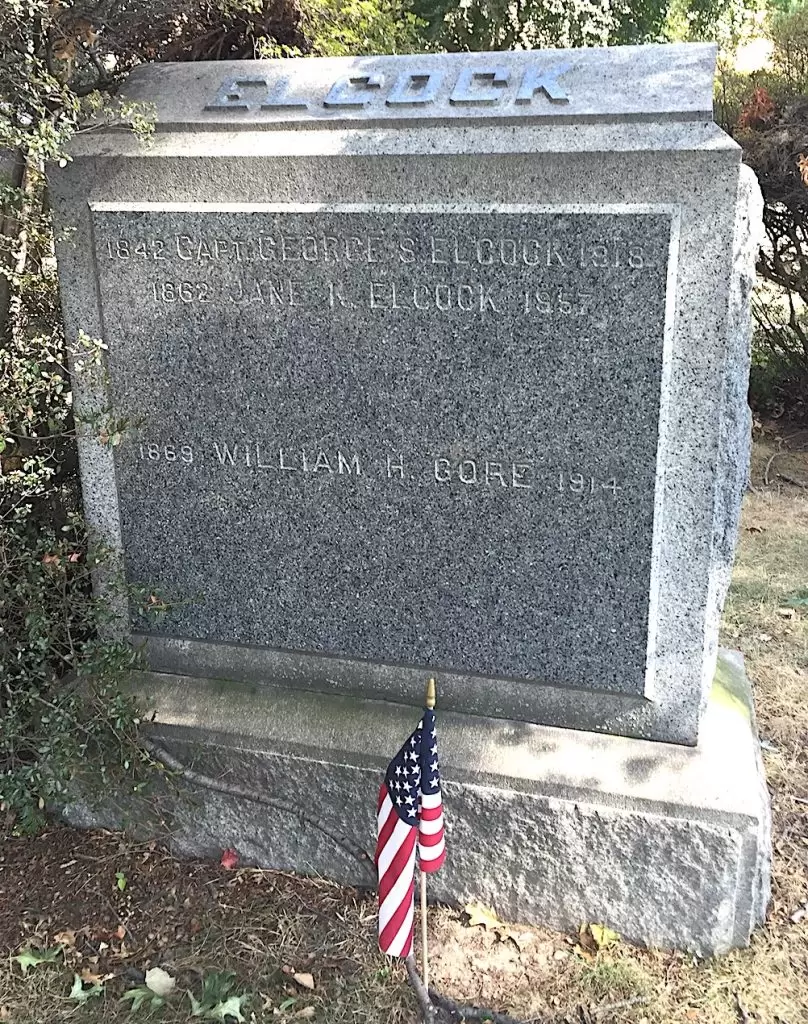
ELDREDGE, CHARLES H. (1839-1916). Paymaster, United States Navy. Originally from Massachusetts, Eldredge first served as an acting assistant paymaster in the Navy after enlisting on July 10, 1861. A career serviceman, he rose to assistant paymaster on October 23, 1861, and paymaster on February 6, 1862. He was attached to the steam-sloop Canandaigua in the South Atlantic Blockading Squadron from 1862-64. In addition, he was on the store-ship Supply in the North Atlantic and Gulf Squadrons.
After the War, he was on special duty at the New York Navy Yard in 1866, then reported to the Navy Yard at Pensacola, Florida, from 1867-68. Eldredge was the storekeeper in the Asiatic Squadron in 1869. He became a pay inspector on July 3, 1871, and then a pay director on August 31, 1881. He continued to reside in Norfolk, Virginia, his last post, after retiring from the Navy in 1903. As per his obituaries in the New York Herald and in the Evening Post, he had the relative rank of rear admiral on the retired list. Both obituaries confirmed his Civil War service. It appears that he was the son of Joseph Eldredge (see). Eldredge died of arteriosclerosis. Section 94, lot 10517.
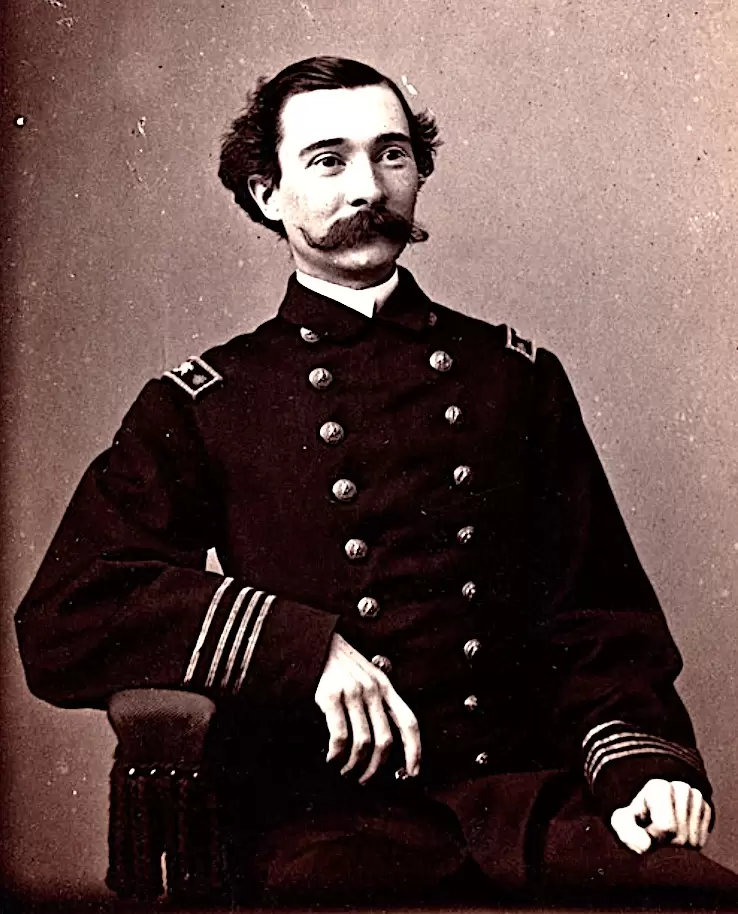
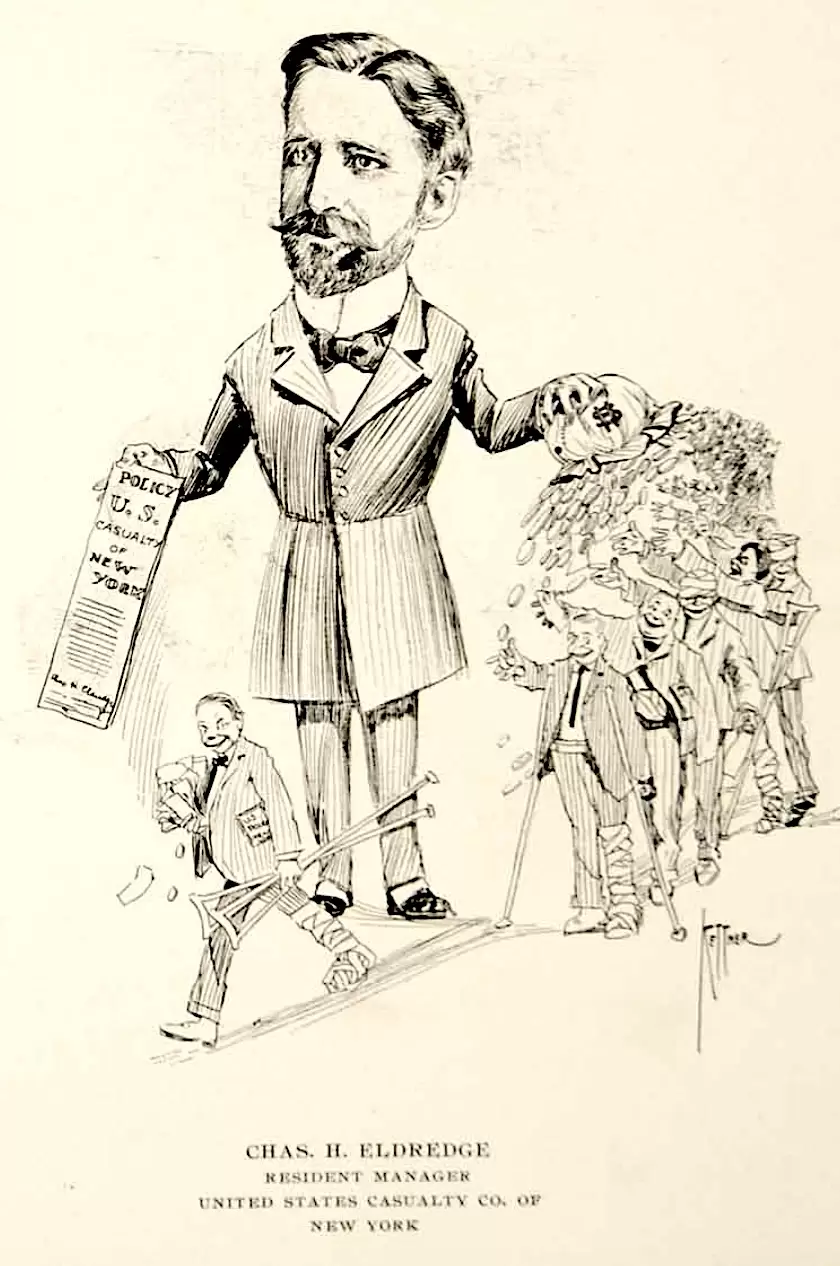
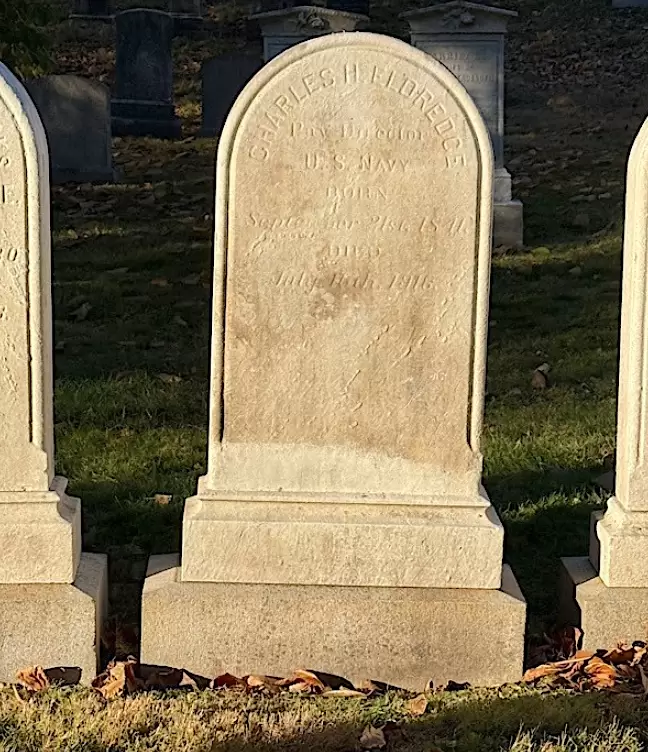
ELDREDGE, JOSEPH C. (1818-1881). Purser, United States Navy. Eldredge, who was born in New York, began his naval career as a purser on February 2, 1847, and was assigned the Brazilian Squadron. Next, he was on the Porpoise, a brig that plied the waters off the coast of Africa from 1850-52. He was assigned to the frigate Powhatan as part of the East India Squadron from 1853-56, and was with Commodore Matthew Perry when the first trade agreement with Japan was signed in 1854. Eldredge was with Captain William Hudson when the first transatlantic cable was laid in 1858. He then became an inspector at New York from 1858-61.
During the Civil War, Eldredge was on the Lancaster, a steam-sloop in the Pacific Squadron from 1862-63, and spent part of that time assigned to New York for special duty. According to one biography, he was paymaster of the Pacific fleet during the Civil War. He was paymaster at New York from 1866-69. Eldredge was promoted to pay director on March 3, 1871, and retired from service on March 8, 1880. He was likely the father of Charles Eldredge (see). His last residence was at 49 Cambridge Place in Brooklyn. His death was caused by apoplexy. Section 94, lot 10517.
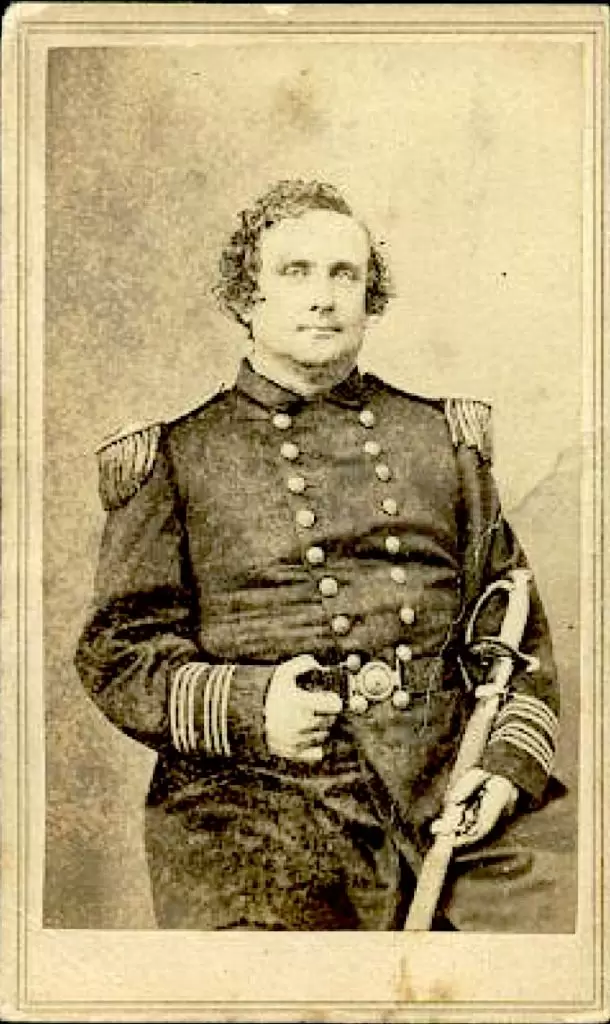
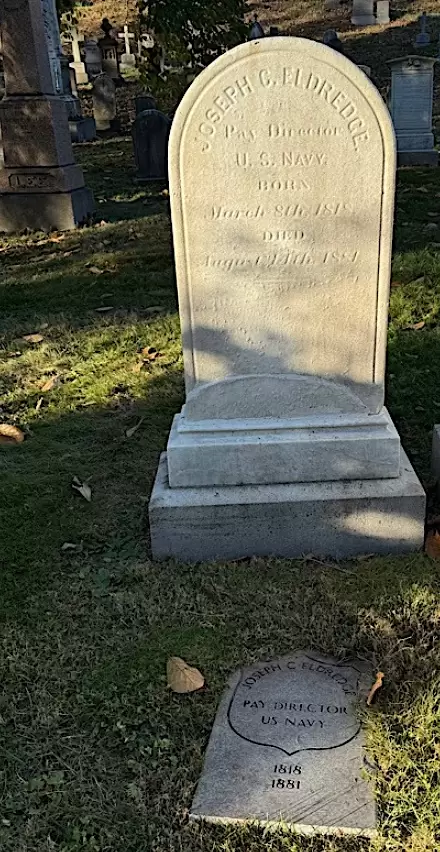
ELLER, JACOB (1828-1885). First lieutenant, 5th Regiment, New York State Militia, Engineers Company. Originally from Germany, he was a saloon-keeper according to the 1860 census. He enlisted as a corporal at Washington, D.C., on May 16, 1861, mustered into the 5th Regiment, also known as the Jefferson Guard, on that date, and mustered out on August 7, 1861, at New York City. In 1863, he returned to the regiment, now part of the New York State National Guard, as a first lieutenant, and served for 30 days.
The 1870 census lists his occupation as shoe-maker. As per his obituary in the New York Herald, he was a member of John A. B. Dahlgren Post #113 of the G.A.R. and the Ancient Order of United Workmen, a fraternal organization that provided social and financial support. Members of both groups were invited to his funeral. He last lived at 540 East 148th Street, New York City. Eller succumbed to stomach ulceration. Mary Eller, who is interred with him, applied for and received a widow’s pension in 1890, certificate 305,569. Section 19, lot 7346.
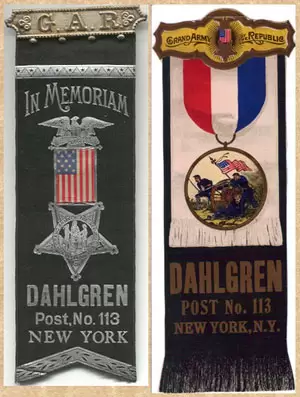
ELLER, MARTIN (1830-1884). Private, 15th New York Heavy Artillery, Company C. Of German origin and a cabinet-maker by trade, Eller enlisted as a private at New York City on October 22, 1861, and mustered into the 15th New York Heavy Artillery on that day. According to his pension record, he also served in the 3rd Battalion, New York Heavy Artillery, Company C, a unit that merged into the 15th Heavy Artillery on May 29, 1863. The censuses of 1870 and 1880 list him as a cabinet-maker. In 1882, he applied for an invalid pension, application 466,155, but there is no certification number. He last lived at 198 Eldridge Street in Manhattan. His death was caused from hepatitis. Salome Eller, who is interred with him, applied for a widow’s pension in 1890 that was granted under certificate 332,356. Section 14, lot 4969, grave 394.
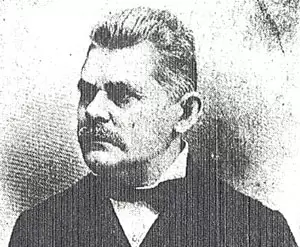
ELLIOTT, CHARLES B. (1831-1896). Captain, 73rd New York Infantry, Company I. A native of New York City, Elliott was appointed assessor in 1858. He was also an assistant engineer with the Brooklyn Volunteer Fire Department. During the Civil War, he enlisted as a captain at New York City on May 3, 1861, and was commissioned into the 73rd New York three months later on August 2. That regiment, originally known as the Second Fire Zoaves, consisted mostly of firemen and their runners. His commanding officer, William R. Brewster (see), cited him in his field report from Williamsburg, Virginia, on May 7, 1862, for assisting him during the battle there two days earlier, “… in urging forward the men when exposed to a galling fire and obliged to advance through a thick entanglement of brush and felled timber.” Elliott was discharged on April 10, 1862.
According to his obituary in The New York Times, Elliott was a maker of rowing shells and devised a sliding seat for rowers. He made shells for Harvard, Yale and other colleges. In 1869, he accompanied the Harvard crew team to England. An article on July 18, 1932, in the Brooklyn Daily Eagle highlighting “Stories of Old Brooklyn” focused on Elliott and his many talents. That article talked about how Elliot had accompanied the Harvard crew team to England with plans for a new shell that he constructed in fourteen days. The English boat-builder described the finished product “as near perfection as anything in the shell-building line could be.” In addition, he designed a vessel to cross the Atlantic in six days, and was an active yachtsman. Active in political life, he was elected alderman in 1867 and re-elected in 1869. In 1871, he was elected police justice and served for seven and a half years until he was elected Kings County clerk in 1879. In 1892, he applied for and received an invalid pension, certificate 817,173. He last lived at 595 Lexington Avenue in Brooklyn. Elliott died at the Gravesend Race Track in Brooklyn where his son was a trainer. His death was attributed to endocarditis. Elizabeth Elliott applied for a widow’s pension in 1896, application 687,157, but it apparently was not certified. Section 118, lot 11258, grave 8.
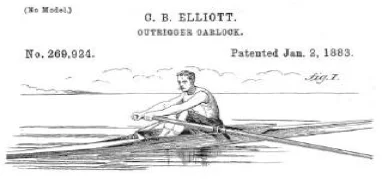
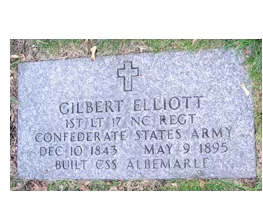
ELLIOTT, GILBERT (1843-1895). First lieutenant and adjutant, 17th North Carolina Infantry, Confederate States of America. A native of North Carolina, Elliott was educated as a marine engineer, served as a law clerk by 1860, and enlisted in the 17th North Carolina at the age of 19. He probably enlisted at Camp Magnum, North Carolina, on May 16, 1862, was appointed first lieutenant the next day and given the position of regimental adjutant. The muster rolls for January-February 1863 and November-December 1863 stated that he was absent and detailed to build a gunboat at Halifax, North Carolina. Serving on the Confederate General Staff, he was given command of a project to build a mammoth ironclad ram in a North Carolina shipyard on the Roanoke River.
Elliott wrote about the construction in The Century (July 1888), “No vessel was ever constructed under more adverse circumstances. The shipyard was established in a cornfield, where the ground had already been marked out and planted for the coming crop, but the owner of the land was in hearty sympathy with the enterprise, and aided me then and afterwards, in a thousand ways, to accomplish the end I had in view. It was next to impossible to obtain machinery suitable for the work in hand. Here and there, scattered about the surrounding country, a portable sawmill, a blacksmith’s forge, or other apparatus was found, however, and the citizens of the neighborhoods on both sides of the river were not slow to render me assistance, but cooperated, cordially, in the completion of the ironclad…” Following the designs of Chief Engineer John L. Porter, the assignment was completed within a year and named the CSS Albemarle. In describing the construction, Elliott wrote, “The work of putting on the armor was prosecuted for some time under the most disheartening circumstances, on account of the difficulty of drilling holes in the iron intended for her armor. But one small engine and drill could be had, and it required, at best, twenty minutes to drill an inch and a quarter hole through the plates, and it looked as if we would never accomplish the task…” (An associate invented a twist-drill that significantly shortened that process.) One of the best constructed vessels of the War, it was 152 feet long with a draft of 9 feet making it formidable on the seas or inland waterways. Once the project was completed, Elliott submitted his resignation as adjutant on December 15, 1863, and officially resigned on January 20, 1864.
A nemesis of the Union Navy, the Albemarle was named in dispatches by Lieutenant Commander Charles W. Flusser, who commanded the squadron at Plymouth, North Carolina. The Albemarle saw action during the Battle of Plymouth on April 19, 1864, when it rammed and sank the USS Southfield. When a shell from the USS Miami struck the iron plating of the Albemarle in that same engagement, it bounced back onto the Miami, killing Flusser. A sailor on board the Albemarle at Plymouth was impressed by its thick hull and reported that “the noise made by the shot and shell as they struck the boat sounded no louder than pebbles thrown against an empty barrel.” Two weeks later, on May 5, the ironclad survived ramming attacks by Union gunboats with only minor damage. The Albemarle was destroyed by a special operations raid on the dry docks of North Carolina on October 27 of that year, led by Navy Commander William Cushing, four days before the Union recaptured Plymouth. On October 30, 1864, Cushing wrote that he was honored to report that the Albemarle was at the bottom of the Roanoke River. He described how his boat was flooded by a torpedo shot and that after refusing to surrender dove into the water and began to swim ashore. When he emerged from the water at daylight, one of only two who managed to escape safely, he saw two of the Albemarle’s officers, assumed that the vessel had sunk, and soon thereafter verified the information. Eventually the Albemarle was taken to the Norfolk Navy Yard, Virginia, in April 1865 where she remained until October 1867 when she was sold. Elliot finished his service on the General Staff of the Army of Northern Virginia.
According to the census of 1870, Elliott lived in Norfolk, Virginia, where he was a lawyer. By 1880, he was residing and practicing law in St. Louis, Missouri. In 1889, he opened another practice in New York City; the New York City Directory for 1889 lists him as a lawyer at 320 Broadway (later moving to 206 Broadway in 1893). He last lived in Fort Wadsworth, Staten Island. His death was caused by erysipelas (a bacterial skin infection). Originally interred in lot 8839, his remains were placed in the current location on November 10, 1895. Section 137, lot 29238.
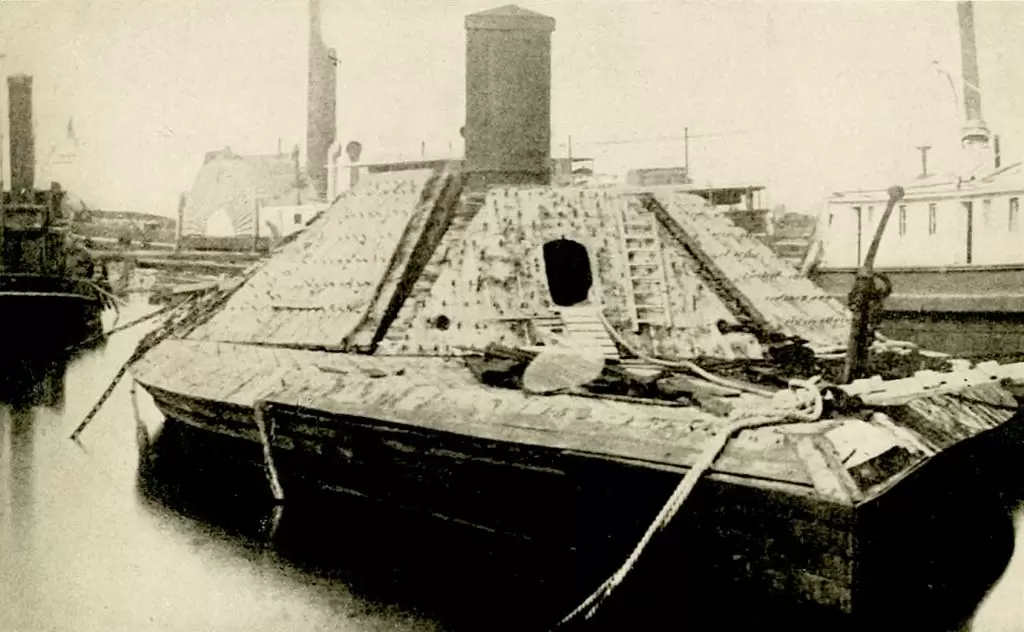
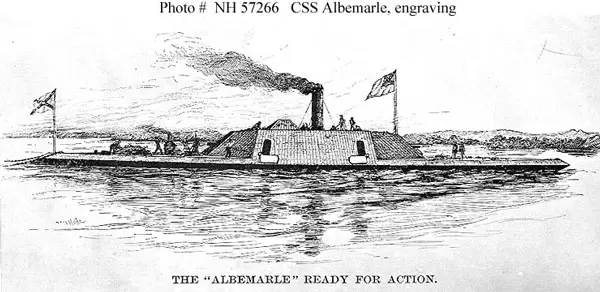
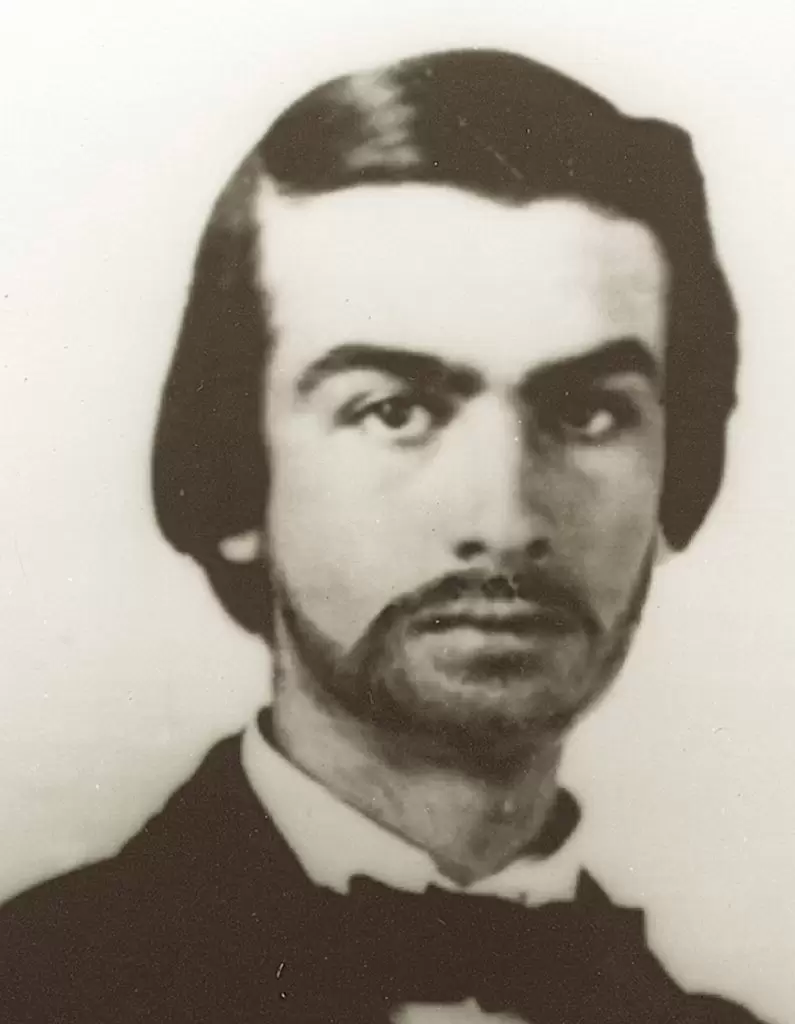
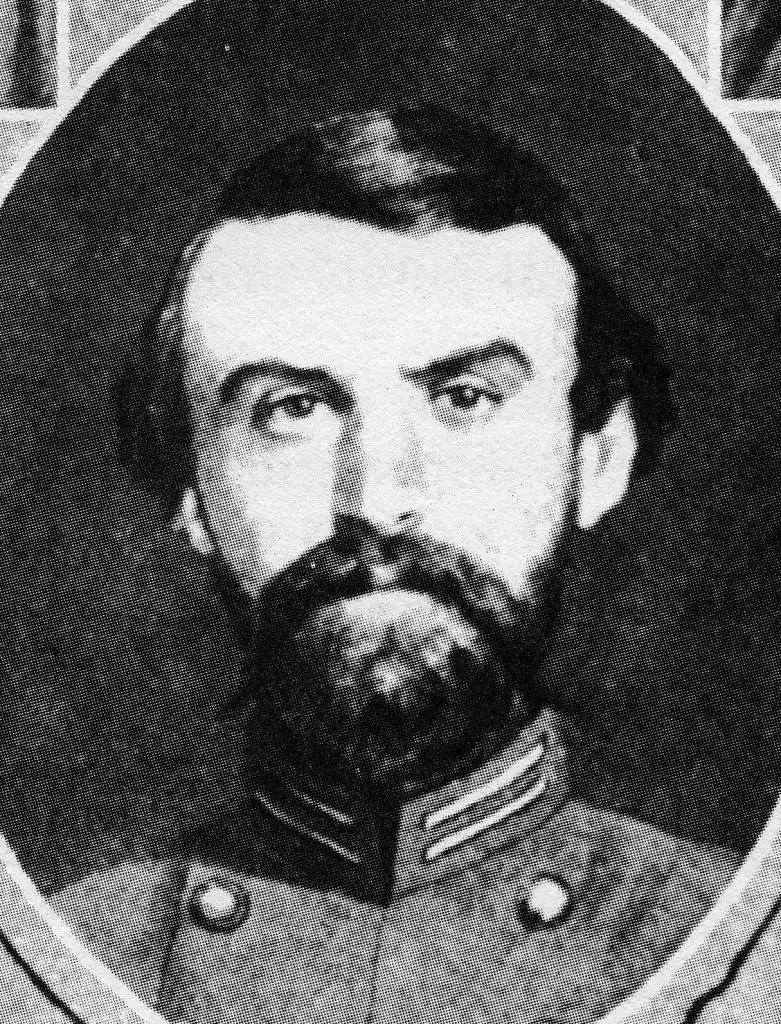
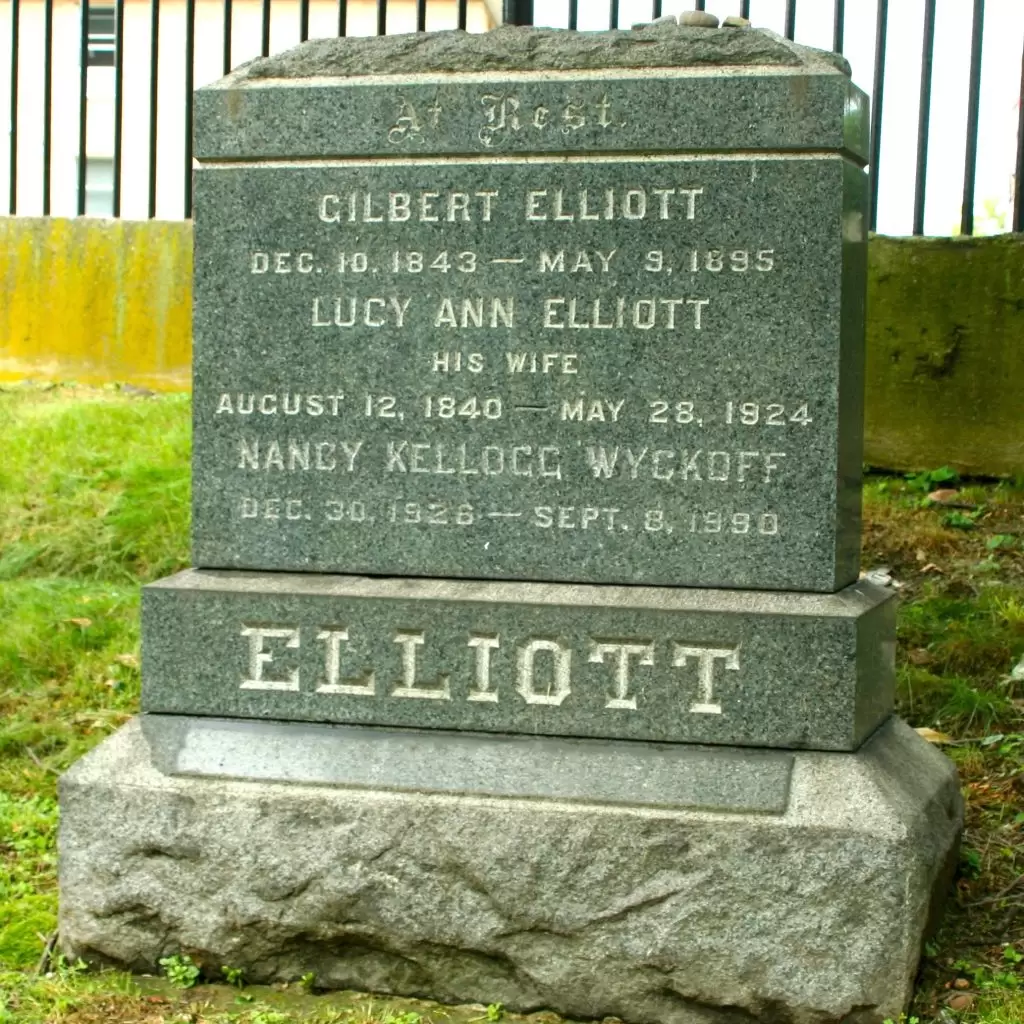
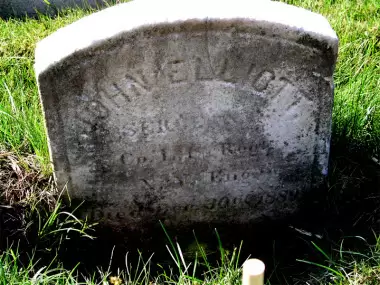
ELLIOTT, JOHN D. (1835-1889). Sergeant, 1st New York Engineers, Company L; private, 4th New York Light Infantry. Originally from Ireland (although his muster roll incorrectly says Brooklyn), Elliott lived at 3 Nelson Street in Brooklyn at the onset of the Civil War. He enlisted as a private and mustered into the 4th New York Light Infantry (company unknown) on October 15, 1861, at New York City. On December 12, 1863, he transferred into Company L of the 1st New York Engineers. Elliott received promotions to corporal on March 1, 1864, and to sergeant on September 1, 1864, before he mustered out on October 14, 1864, at Varina, Virginia.
On October 22, 1866, Elliott became a naturalized citizen. His naturalization papers, the censuses of 1870 and 1880 and the Brooklyn Directory for 1876 all list his occupation as lithographer. In 1882, he applied for and received an invalid pension, certificate 483,332. He last lived at 307a 16th Street in Brooklyn. The cause of his death was edema of the lungs (excess fluid in the lungs). Charlotte Elliott, who is interred with him, applied for and received a widow’s pension in 1890, certificate 354,353. Section 6, lot 20118, grave 528.
ELLIS, DAVID (1842-1897). Artificer, 1st New York Engineers, Company B. Of Canadian birth and employed as a clerk, his muster roll describes him as 5′ 10″ tall with grey eyes, dark hair and a dark complexion. Ellis enlisted as a private at New York City on March 28, 1865, and immediately mustered into the 1st New York Engineers. After he was promoted to artificer, an enlisted man responsible for the upkeep of small arms, on April 23, 1865, he deserted at Richmond, Virginia, on May 29.
As per the census of 1870, he was a store-clerk; the 1878 Brooklyn Directory indicates that he was dealing in straw goods at 116 Mercer Street in New York City. The 1880 census lists him as an importer of straw; the 1892 Brooklyn census indicates that Ellis was an importer. He last lived on 20th Street in Brooklyn. He died of apoplexy. Section 17, lot 17245, grave 1140.
ELLIS, EDWIN A. (enlisted as SMITH, THOMAS) (1848-1872). Musician, 73rd New York Infantry, Company E. Born in New York State, Ellis, using the alias Thomas Smith, enlisted as a musician at Camp Lawrence, Maryland, on November 7, 1861, and mustered into the 73rd New York on December 27. He re-enlisted on December 30, 1863, and mustered out on June 29, 1865, at Washington, D.C. His widow, Mary Ellis, was awarded a pension in 1892, certificate 389,761. There is a star indicating membership in the G.A.R. attached to his tombstone. Section 3, lot 12838.
ELLIS, GREGORY C. (1843-1872). Private, 87th New York Infantry, Company I. After enlisting as a private on September 15, 1861, at Williamsburg, New York, he mustered into the 87th New York on September 28. On June 30, 1862, he was listed as being on furlough for sickness. His muster roll indicates that he was transferred to the 40th Infantry on September 6, 1862, but that there does not to appear to be any record of him in that regiment. Census records show that there was only one Gregory Ellis living in Brooklyn. Therefore, it is likely that this Civil War veteran is the same man who is listed as a bookkeeper in 1870 as per that census and in the Brooklyn Directory for 1871 as a barkeeper. His last residence was in Brooklyn where he died of heart disease. Section 169, lot 14487.
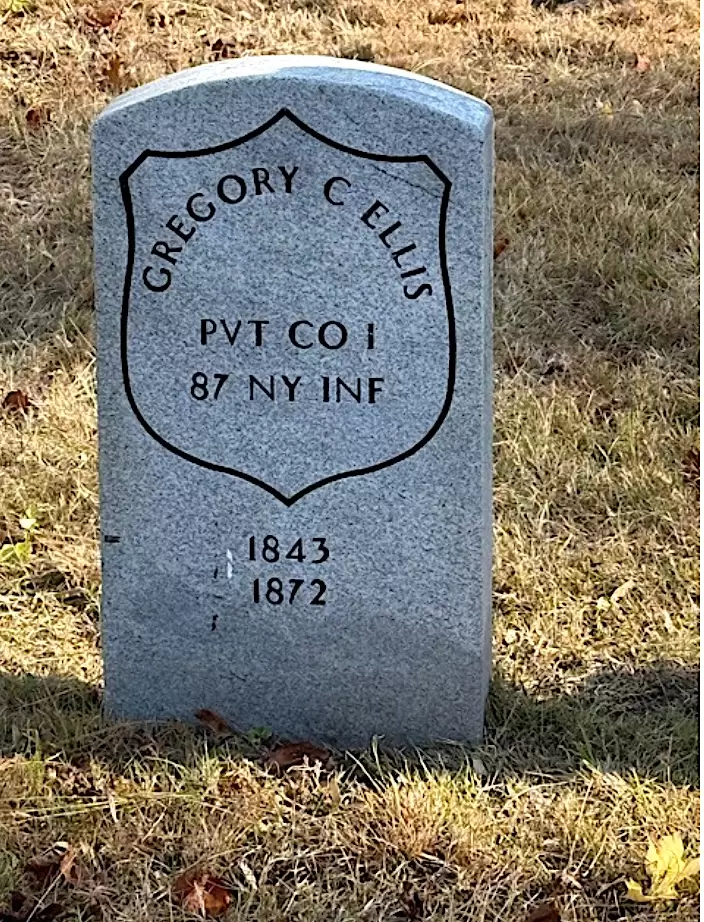
ELLIS, RICHARD (1826-1884). Private, 5th New York Heavy Artillery, Company B. Ellis, a Connecticut native, enlisted on January 10, 1862, at New York City, and mustered immediately into the 5th New York Heavy Artillery. He deserted at Fort Wood in New York Harbor on May 26 of the same year. He was living in Brooklyn at the time of his death from stomach cancer. Section 15, lot 8587.

ELLIS, SAMUEL W. (1820-1868). Corporal, 4th New York Infantry, Companies G and H; private, 16th New York Heavy Artillery, Company B. A native of New York, he resided in Hoboken, New Jersey, at the time of the census of 1860. At that time, he was an ostler, an inn employee who looked after the horses of visitors. Ellis enlisted at New York City as a private on April 22, 1861, mustered into Company G of the 4th New York on May 7, and was transferred into Company H the next day. He was promoted to corporal on August 1 of that year, was reduced to the rank of private on February 11, 1862, and mustered out on May 25, 1863, at New York City. After re-enlisting as a private at New York City on January 12, 1864, he immediately mustered into the 16th New York Heavy Artillery, and mustered out on August 21, 1865, at Washington, D.C. He last lived at 215 West Street in Manhattan. Ellen Ellis, who is interred with him, applied for a widow’s pension in 1890 that was granted under certificate 350,632. Section D, lot 7078, grave 106.
ELLISON, FRANCIS BLEECKER (1803-1884). Commodore, United States Navy. Born in New York City, Ellison came from a Navy family. His father was an officer in the United States Navy and was attached to the Brooklyn Navy Yard. On May 28, 1819, Ellison received his warrant from President Monroe as a midshipman, and he spent his first years at sea on the schooners Enterprise (1819-20), Constitution (1821), and the USS Washington. In February 1828, he was promoted to lieutenant and ordered to serve on the schooner Shark. He then served in the Mediterranean, and was subsequently stationed at the New York Navy Yard. In 1845, he also served on the Concord, Brandywine, United States and Lexington, and brought home the remains of Commodore Edward Shubrick (an officer in the War of 1812) from the Mediterranean. Ellison was promoted to commander on May 29, 1850, and assigned to the New York Navy Yard. He subsequently commanded the Jamestown on the coast of Africa from 1855-1858, and was promoted to captain on March 2, 1857.
When the Civil War broke out, Ellison was ordered to take command of the R.R. Cuyler, one of the first vessels fitted out at the New York Navy Yard. This steamer, which blockaded the Gulf coast during the War, was under Ellison’s command when it seized and burned the Confederate ship Finland which was prepared to receive a shipment of cotton off Apalachicola, Florida, on August 26, 1861. At that time, an outbreak of smallpox afflicted many of the Cuyler’s crew. In 1861, he commanded the frigate Richmond and participated in the bombardment of Forts McRae and Barrancas, Florida, where he was under attack from heavy fire for seven hours and was finally forced to retire with his badly damaged ship. When he came to New York for repairs, he was ordered to duty as Inspector of Vessels for the Government under the War Department. On July 16, 1862, Ellison took the rank of commodore and commanded the naval station at Sackett’s Harbor, New York, until 1870. In all, Commodore Ellison served in the Navy for 66 years. He last lived in Boston, Massachusetts. He died of cancer. Section 116, lot 15615, grave 297.
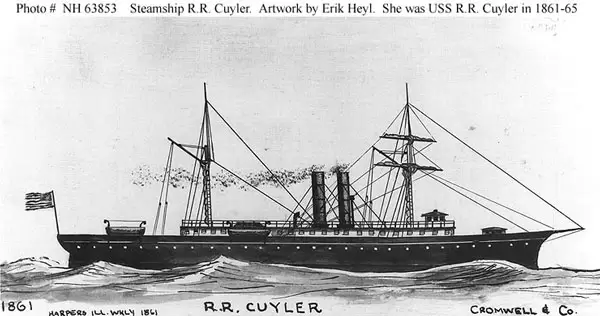
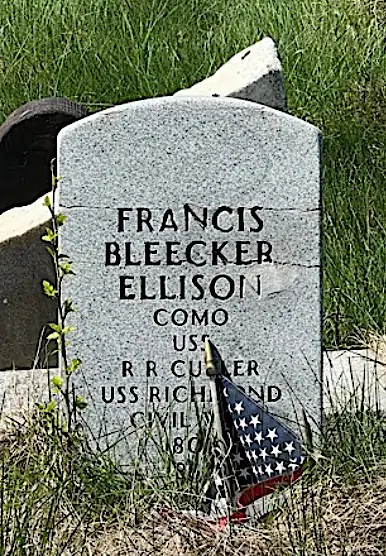
ELLWOOD (or ELWOOD), LEROY M. (1826-1889). Private, 84th New York (14th Brooklyn) Infantry, Company G. Ellwood, a native of Newton, Connecticut, first served in the Mexican War, enlisting on May 18, 1847. In 1850, he was living in Newtown, Connecticut, where he was a farmer. During the Civil War, he enlisted as a private at Brooklyn on August 20, 1862, the same day that he mustered into the 14th Brooklyn. As per his muster roll, he was a hatter who was 5′ 9½” tall with gray eyes, black hair and a dark complexion. He deserted at Antietam, Maryland, on September 16, 1862, “while under fire of the enemy.”
The 1862 Brooklyn Directory lists him as a hatter living on Tompkins Avenue in Brooklyn. He is also listed as a hatter in the Brooklyn Directories for 1883 and 1887; in 1883, he was living at 133 Stockton Street. Ellwood last lived at 145 Stockton Street in Brooklyn. He died from a cerebral hemorrhage. According to Catherine Ellwood, his widow, his personal property at the time of his death totaled less than $25. He was survived by his wife and two children. Section 69, lot 1590, grave 22.
ELMORE, LOUIS (or LEWIS) (1846-1904). Corporal, 9th Minnesota Infantry, Company E. A New Yorker by birth, he enlisted as a private on February 8, 1864, and mustered immediately into the 9th Minnesota. After a promotion to corporal at some point, he mustered out on August 24, 1865, at Fort Snelling, Minnesota.
As per the 1880 census, Elmore was living in Atchison, Missouri, where he worked as a plasterer. In 1891, he filed for and was awarded an invalid pension, certificate 802,219. He moved to Brooklyn at some point, where he was a horse trainer as per the 1900 census and the 1904 Brooklyn Directory. As per his obituary in the New York Sun, he was well-known among horse trainers and began his operations with a stable in the Far West. One of his horses, Spokane, ran in the Kentucky Derby. In New York, his firm was Elmore and Trowbridge. He last lived in Sheepshead Bay, Brooklyn, at Voorhies and Ocean Avenues but died in Sarasota Springs, New York, where he succumbed after an operation for appendicitis. Shortly after his death in 1904, Jennie Elmore, who is interred with him, applied for and received a widow’s pension, certificate 671,880. Section 145, lot 31810.
ELLSWORTH, WILLIAM (1838-1903). Private, 13th Regiment, New York State National Guard, Company G. A Brooklyn native, he enlisted as a private on May 28, 1862, mustered into Company G of the 13th Regiment, and was discharged with his company after three months on September 2. When the 13th was reactivated the next year, Ellsworth enlisted as a private on June 20, 1863, returned to Company G, and was discharged with his comrades after 30 days on July 30, 1863.
The 1880 census indicates that he was employed as an insurance clerk. On May 16, 1890, Ellsworth mustered into Marquis de Lafayette Post #140 of the G.A.R.; his description notes that he was living at 16 Lafayette Avenue in Brooklyn and working as a clerk. Ellsworth died from an ulcer. He last lived at 16 Lafayette Avenue in Brooklyn. Section 57/68, lot 3982.
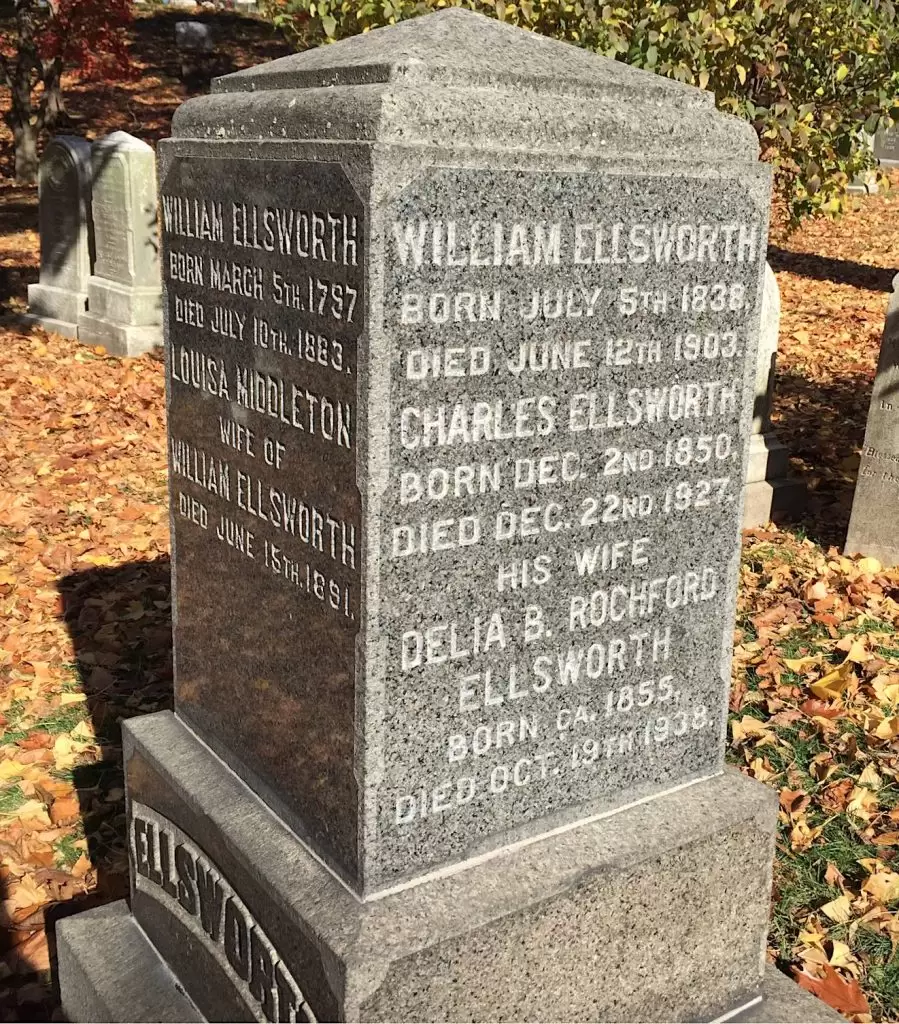
ELOESSER (or ELOSSER, ELEESER, ELLESSER), SOLOMON (or SALOMON) (1828-1906). First sergeant, 2nd Missouri Infantry, Company B; 43rd Illinois Infantry, Companies H and E. Eloesser was born in Germany. He first had service in Company B of the 2nd Missouri, where he enlisted in 1862 and mustered out as a first sergeant on an unknown date; his soldier cards for the 2nd Missouri record his name as both Elosser and Ellesser. On September 22, 1864, he enlisted as a private and mustered into Company H of the 43rd Illinois as a substitute on October 19. He was transferred intra-regimentally into Company E on December 16 and mustered out on August 7, 1865, at Little Rock, Arkansas. He applied for a pension from New York, citing service in both of the aforementioned regiments, in December 1891; his application was granted under certificate 1,014,351. His is a rare name; no other Solomon Eloesser is listed in any Civil War database. He last lived at 221 Christie Street in Manhattan. He succumbed to pneumonia at St. Francis Hospital. Section 181, lot 18513, grave 66.
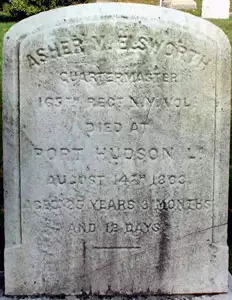
ELSWORTH (or ELLSWORTH), ASHER MARTIN (1838-1863). First lieutenant and quartermaster, 165th New York Infantry; corporal, 7th Regiment, New York State National Guard, Company F. A native New Yorker and brother of Edward (see), Asher Elsworth first joined the 7th Regiment at age 18 in 1856. A clerk, he enlisted at New York City at the onset of the Civil War on April 17, 1861, and mustered into the 7th Regiment which left for Washington, D.C., on April 26. He mustered out with his company at the expiration of his enlistment at New York City on June 3. When the 7th was activated a year later, he re-enlisted at New York City as a private on May 25, 1862, mustered immediately into the 7th Regiment, was promoted to corporal on July 24, and mustered out after three months on September 5 at New York City. The following day, he was commissioned into the Field and Staff, 165th New York, and served as first lieutenant and regimental quartermaster until August 14, 1863, when he died from dysentery at Port Hudson, Louisiana. He was interred at Green-Wood on December 18, 1863. Section 169, lot 13653.
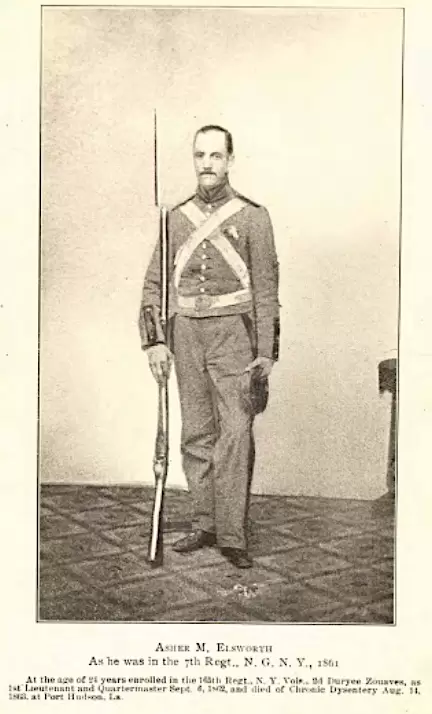
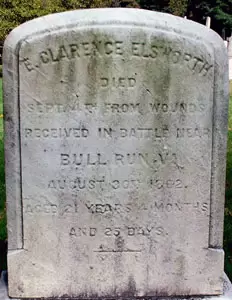
ELSWORTH (or ELLSWORTH), EDWARD CLARENCE (1842-1862). Corporal, 5th New York Infantry, Company B. A native of New York and a clerk as per the census of 1860, Elsworth was one of 15 children and the brother of Asher M. (see) who also served in the Civil War. His family’s lineage could be traced back to the Elswaerts who came from Holland to Manhattan in 1653. His father was well-known in New York with interests in shipping, banking and insurance.
Edward C. Elsworth enlisted as a corporal at New York City on April 14, 1861, mustered into the 5th New York on May 9, and was reduced to the rank of private on August 19. In October and December 1861, letters were written to New York State Governor Edwin D. Morgan by D.R. Martin, a financier of the regiment and uncle of Elsworth, recommending him for a commissioned position. After being listed as sick with dysentery at White House Landing, Virginia, on June 5, 1862, he returned to the front and was killed in action at the Battle of Second Bull Run, Virginia, on August 30, 1862. According to his obituary in The New York Times on September 15, 1862, his remains were first interred near Centreville, Virginia. He was re-interred at Green-Wood on November 13, 1862. Section 169, lot 13653.
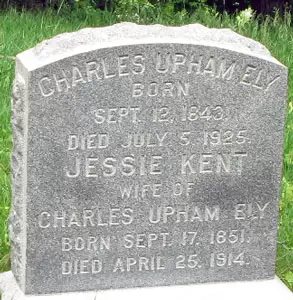
ELY, CHARLES UPHAM (1843-1925). First lieutenant, 46th Massachusetts Infantry, Company E. On September 5, 1862, when he was a student living in West Springfield, Massachusetts, Ely enlisted as a first lieutenant. On October 15, he was commissioned into the 46th Massachusetts from which he mustered out on July 29, 1863, at Hampden Park in Springfield.
According to the census of 1880, Ely worked as cloth goods manufacturer; the Brooklyn Directory of 1884 indicates that he was a plater. The censuses of 1910 and 1920 list him as a manufacturer at a metal foundry; the 1915 New York State census notes that he worked at a nickel-plating factory. He filed for a pension in 1907, certificate 1,144,171. His last residence was in New Haven, Connecticut. His death was attributed to cancer. Section 34, lot 3749.
ELY, EZRA BROCKWAY (1839-1894). Corporal, 34th Pennsylvania Infantry, Company A. Originally from Massachusetts, he enlisted on June 3, 1863, as a corporal. After mustering into Company A of the 34th Pennsylvania Infantry that same date, he was discharged from service on August 24, 1863. Ely was president of a coal operating company in New York and then in New Jersey. He was also vice-president of the Delaware, Susquehanna and Schuylkill Railroad Company and was involved in many local business and charitable enterprises. He last lived at 93 1st Street in Bayonne, New Jersey. Section 194, lot 28919, graves 6 and 7.
ELY, GRISWOLD (or GRISWALD) LORD (1843-1919). Acting assistant paymaster, United States Navy. Ely was born in New York City. After enlisting as a landsman on October 14, 1861, he served on the USS North Carolina and was a yeoman when he was discharged on November 13, 1862. Appointed as a pay clerk the next day, he served on the USS Supply until his appointment as an acting assistant paymaster on September 23, 1863. He served in that capacity on the USS Release until December 31, 1865, at which time he was given a three month leave of absence prior to his honorable discharge.
In 1866, Ely entered the wholesale cutlery business of Marshall Dickinson & Co. which was later renamed Ely & Wray. The 1876 Brooklyn Directory and the censuses of 1880 and 1900 list him as being in the hardware business. Ely was awarded a pension from the Navy in 1902, certificate 35,228. At the time he applied for a pension, he was 5′ 7½” tall with blue eyes, light hair, light complexion and a coat of arms tattoo on his right forearm. As per his obituary in the New York Sun, he was active in Ulysses S. Grant Post #327 of the G.A.R. and was a Freemason. He died of nephritis. Section 154, lot 25426.
ELZEA, JOSEPH (1848-1924). Private, 1st Minnesota Heavy Artillery, Company A. Elzea was born in Danbury, Connecticut. A resident of Blue Earth County, Minnesota, and claiming to be nineteen years old, he enlisted and mustered into the 1st Minnesota Heavy Artillery on September 12, 1864, and mustered out on June 20, 1865.
As per the 1878 Brooklyn Directory and the 1880 census, at which time he was living in Norwalk, Connecticut, Elzea was employed as a hatter. (Norwalk was a major hat-making center in the United States until the 1970s.) The Brooklyn Directory for 1884 lists him as a hatter. In 1904, he was granted a pension, certificate 1,157,157. In addition, he was a member of the G.A.R. and was elected adjutant of the Erastus T. Tefft Post #355 in 1912; he was also a member of the Odd Fellows and held the post of district deputy grand master. The 1910 census indicates that he was a carpenter; by 1915, he was retired. By the time of the 1920 census, he had relocated to Norwalk, Connecticut. His death was attributed to chronic nephritis. Eliza Elzea, who is interred with him, applied for and received a widow’s pension shortly after his death in 1924, certificate 962,681. Section 56, lot 4563.
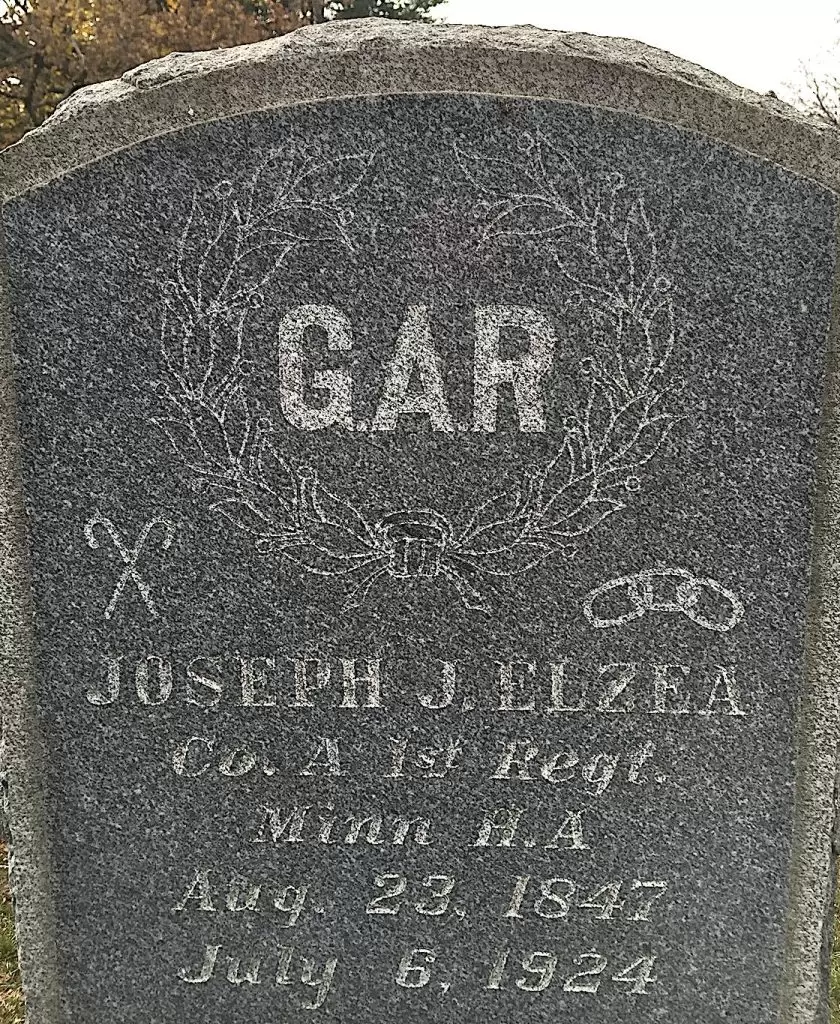
EMANUEL, JOHN H. (or C.) (1841-1923). Private, 23rd Regiment, New York State National Guard, Company C. Manhattan-born, Emanuel served for 30 days in 1863 in the 23rd Regiment. In civilian life, he was a member of the New York Produce Exchange. His obituary in the Brooklyn Daily Eagle, which confirmed his service in the Civil War, said of him, “Mr. Emanuel was very active for a man of his age and was able to follow his custom of taking a daily trip to Manhattan and taking part in the business of the Produce Exchange up until a week before he died.” He last lived at 130 Fort Greene Place in Brooklyn, his home for forty-five years. Section 174, lot 18315.
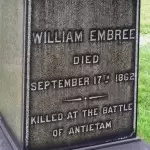
EMBREE, WILLIAM (1845-1862). Corporal, 66th New York Infantry, Company B. A New York City native, he enlisted there at age 16 as a private on October 8, 1861, and mustered into the 66th on November 20. At some point, he was promoted to corporal. Embree was killed in battle at Antietam, Maryland, on September 17, 1862, and was interred at Green-Wood on December 3 of that year. As per his obituary in the Brooklyn Daily Eagle, the reverend of his church on Sands Street planned to make a reference to the young man at the Sunday service. His family lived at 18 Willow Street in Brooklyn. In 1886, Isaac Embree, his father, a well-off builder, applied for a survivor’s pension, application 347,387, but it was never certified. Section 14, lot 8427.
EMIL, CARL (or KARL) (1842-1911). Private, 14th New York Cavalry, Company M. On June 10, 1863, Emil enlisted at New York City and mustered into the 14th New York Cavalry on July 18. He deserted at Camp Canby, New York, on August 10 of that year. Section ?, lot ?.
EMMEL, CHARLES (1844-1874). Private, 6th Regiment, New York State National Guard, Company C. Born in Hanua, Germany, Emmel enlisted at Brooklyn as a private in 1863. He served with the 6th Regiment for its 30 day activation, mustering out at the expiration of his enlistment. After the War, he worked as a merchant. He became a naturalized citizen on November 1, 1873. At the time he filed for a passport in 1873, he was 5′ 6¾” tall with blue eyes, brown hair, prominent nose, large mouth, round chin and full face. He succumbed to typhoid fever. As per his obituary in the New York Daily Tribune, members of the 22nd New York State National Guard were asked to assemble in dress uniform for his funeral and wear a mourning badge for thirty days; his association with the 22nd is unknown. His last address was 207 East 15th Street in Manhattan. Section 15, lot 17263, grave 973.
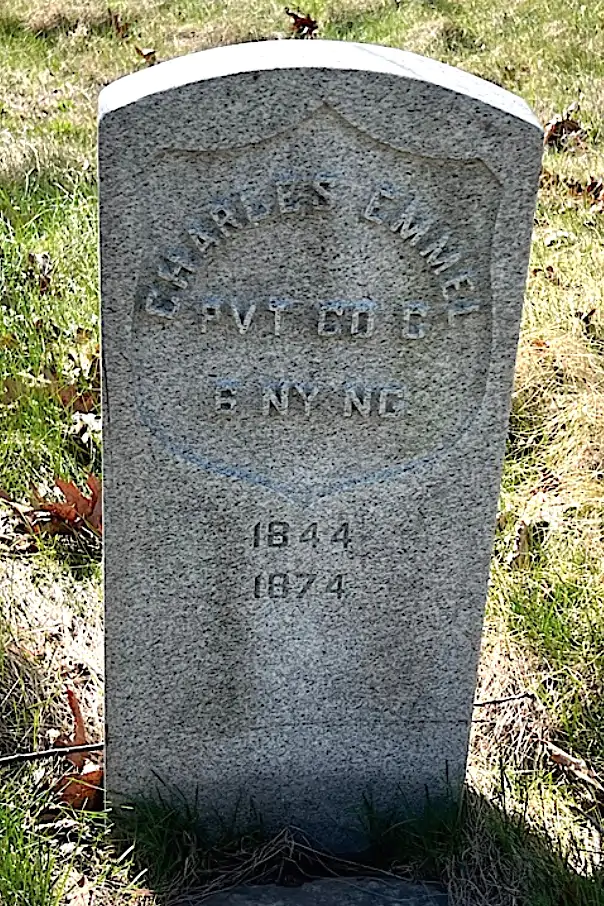
EMMONS, GEORGE T. (or D.) (1834-1886). First assistant engineer, United States Navy. Emmons, who was born in Pennsylvania, began his career in the Navy in 1858. He first served as third assistant engineer on the Mohawk which captured the slave trader Wild Fire in the Gulf of Mexico. After assuming that position on May 3, 1859, he rose to second assistant engineer on April 21, 1862, and to first assistant engineer on May 20, 1863. After the War, he was promoted to chief engineer on March 5, 1871, serving until he was honorably retired on October 31, 1879. Emmons resided at 189 North Calhoun Street in Baltimore, Maryland, at the time of his death. Section 78, lot 17653.
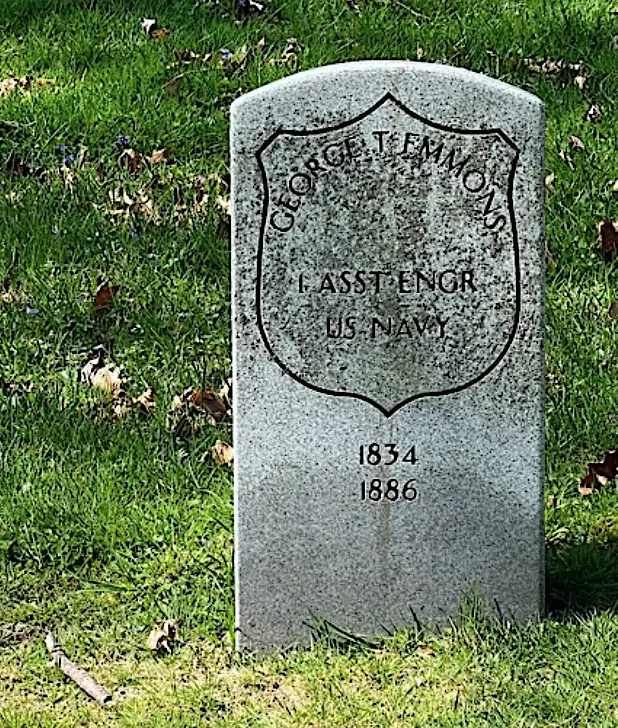
ENDRESS (or ENDRES, ENDRIS), FRIEDRICK (or FREIDRICH) (1830-1891). Orderly sergeant, 58th New York Infantry, Company B; private, 8th New York Infantry, Company D. Born in Germany, he enlisted as a private on April 23, 1861, at New York City, and mustered into the 8th New York. On July 26, 1861, he was discharged for disability at Washington, D.C. He subsequently served as an orderly sergeant in Company B of the 58th New York.
In 1879, Endress’s application for an invalid pension was approved, certificate 206,017. As per the Brooklyn Directory for 1879, he was in the liquor business; the 1880 census lists him as a hotel keeper and the 1882 Brooklyn Directory shows that he was working in a restaurant. Endress was a member of Rankin Post #10 of the Grand Army of the Republic joining on December 15, 1882. According to his obituary in the Brooklyn Daily Eagle, he was a member of several fraternal organizations, including the Freemasons, the Knights of Pythias, the Brooklyn Saengerbund (a singing group that highlighted German culture) and the Brooklyn Schuetzen Corps (a German shooting club). The obituary, which spelled his name, Endris, validated his Civil War service. His last residence was 382 12th Street in Brooklyn. He died from cirrhosis of the liver. Dorothea Endress, who is interred with him, applied for and received a widow’s pension in 1891, certificate 450,521. Section 196, lot 27443.
ENGEMAN, WILLIAM A. (1839-1884). Scout and proprietor of the Brighton Beach Racetrack. Born in New York City, he studied the carpentry trade, then went West to work as a teamster on the Mississippi River and in New Orleans, as a deckhand and galley-chef on a Gulf of Mexico schooner, as a smuggler in Mexico, a mule-skinner on the frontier, and as a sutler in Indian territory. He achieved fame in the Southwest as a scout and daring horseman. When the Civil War began, he declined the colonelcy of a Union regiment, and made a fortune herding wild mules and selling one million of them to the Union. He barely escaped lynching by Union men who took him for a Confederate spy, and by Confederates who thought he was spying for the Union.
After the war he came to Brooklyn, where he planned a racecourse for Coney Island. But his scheme seemed so improbable that he was dubbed “Crazy Bill Engeman.” He persisted, was able to get the surveyor of Gravesend to record his name as owner on the property maps on file with the clerk and was able to lease land at cheap prices. The early development of Coney Island is attributed to him and his brother George. In 1878, the Brighton Beach Hotel and Bathing Pavilion was built by him. A year later he built his racetrack where a swamp had been, and the horses ran very slow times through the sand. He and his brother constructed the first ocean pier in America nearby. He also ran the Ocean House at Coney Island. Section 146, lot 24586.
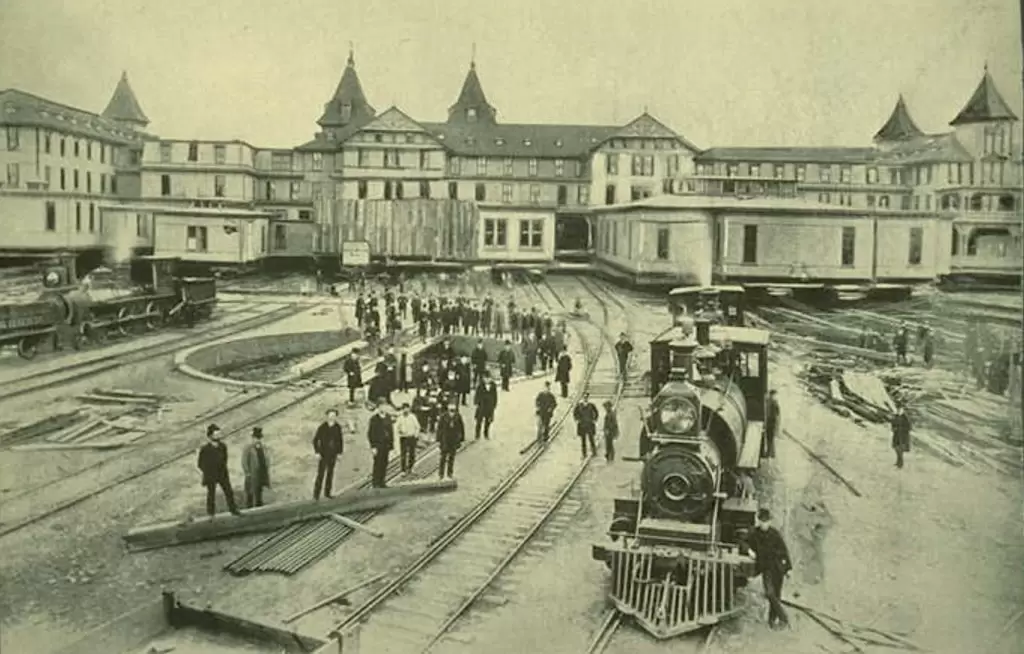
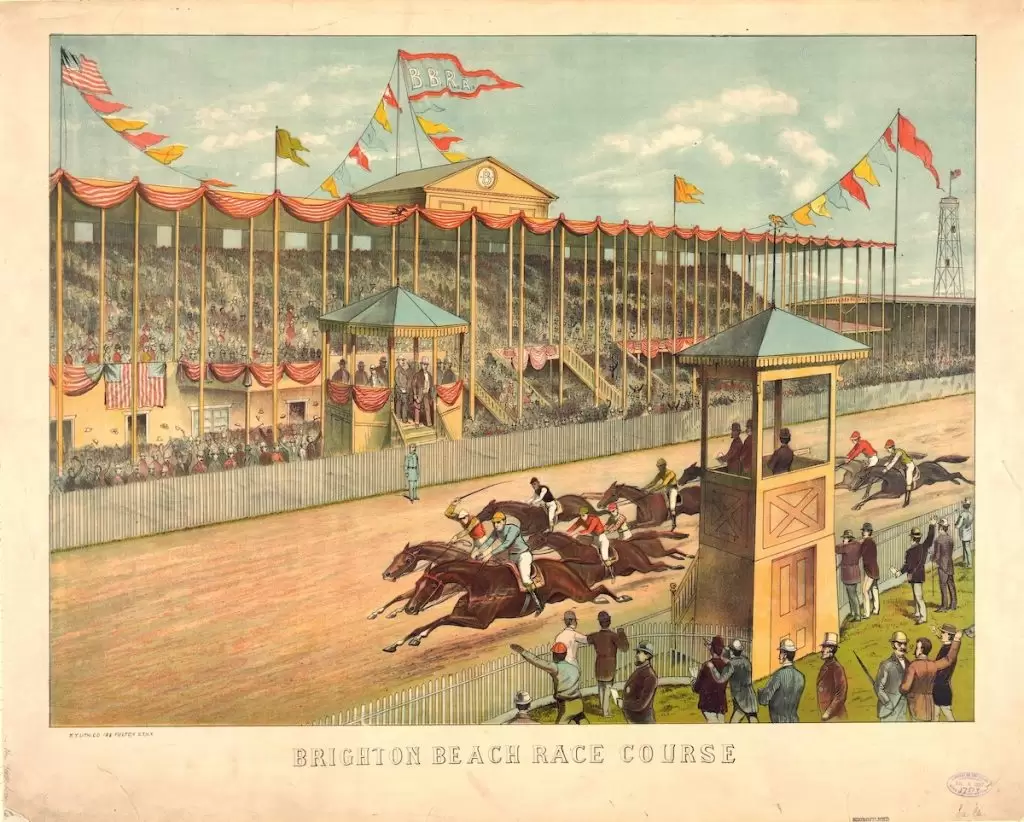
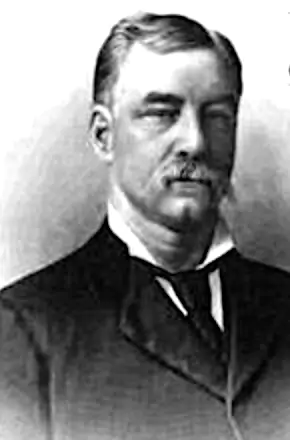

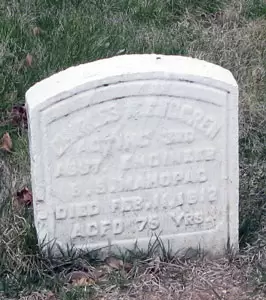
ENGGREN, CHARLES AUGUST (1836-1912). Acting third assistant engineer, United States Navy. Born in Skojde, Sweden, Enggren came to the United States in 1852. He enlisted in the United States Navy on September 21, 1864, as an acting third assistant engineer, and first served on the USS Mohican. He then served on board the USS Mahopac until June 21, 1865. Remaining in the Navy after the War, he was assigned to the Atlantic Squadron, served on the USS Rhode Island, then was sent to Philadelphia for duty on the USS Bienville until December 19, 1866, when he was assigned to the USS Sorrel. Enggren was honorably discharged on October 19, 1867.
In civilian life, Enggren was an engineer at Pierrepont House on Montague Street in Brooklyn. According to his descendant, he received a pension from the Navy of $20 a month beginning in 1911, certificate 16,276. His last residence was in Long Branch, New Jersey. His second wife, Mary, applied for and received a widow’s pension after his death. Section 115, lot 4196, grave 103.
ENGLAND, JAMES (1842-1912). Private, 170th New York Infantry, Company C. Of English origin, he served in the 170th New York. Further details of his service are unknown. He last resided in the Bronx at 412 East 178th Street. His death was attributed to myocarditis. Section 122, lot 17806, grave 252.
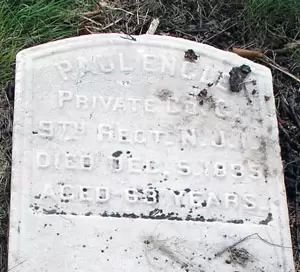
ENGLE (or ENGEL), PAUL (1832-1895). Corporal, 9th New Jersey Infantry, Company G. A German native, Engle enlisted as a private on September 30, 1861, immediately mustered into the 9th New Jersey, and mustered out on an unspecified date and place. He re-enlisted on November 25, 1863, was promoted to corporal on July 1, 1865, and mustered out on July 12, 1865, at Greensboro, North Carolina.
As per the 1880 census, Engle was a music teacher; the 1888 Brooklyn Directory lists his profession as musician. In 1891, his application for an invalid pension was approved, certificate 789,873. He last lived at 786 Fourth Avenue in Brooklyn. Shortly after his death, caused by phthisis, in 1895, Wilhelmina Engle, who is interred with him, received a widow’s pension, certificate 426,953. Section 15, lot 17263, grave 741.
ENGLIS, JOHN (1808-1888). Shipbuilder. Born in Brooklyn, he apprenticed in a ship-building firm, then became foreman of a shipyard. In 1837, he founded a shipbuilding firm in Buffalo, New York, specializing in steamships. There he built the Milwaukee, Red Jacket, and Empire City. These ships, from 210 to 230 feet in length, were substantially faster than any craft then on the Great Lakes. His reputation established, he returned to New York City, opened his yard there, and produced the most famous Hudson River and Long Island Sound steamers of the time. They included the Albany, Hendrik Hudson, Troy, Knickerbocker, and Charter Oak. His yard was at first at the foot of East 10th Street in New York City; later it was in Greenpoint, along the East River on the Brooklyn side. Englis was not just a builder, he was also a self-taught naval architect and designer, though the ships he built were typically designed by others.
In 1861, Englis built the Unadilla, a gunboat needed to maintain the Union Civil War blockade of Southern ports, for the United States Navy in eight-two days. Ships of this class, designed to be close to the shore for blockading, were called “90-day gunboats.” Englis’s vessel, the first of this class, was launched on August 17, 1861, and commissioned on September 30; 22 other ships of this class, built at privately owned shipyards along the East coast, were commissioned by early 1862. The Unadilla was engaged in the capture of Port Royal, South Carolina. The Unadilla-class gunboats were vital in the capture of New Orleans in April 1862 and subsequently in the Vicksburg campaign and the Battle of Mobile Bay, primarily serving to maintain the blockade along the Confederate coast. In 1863, Englis built the St. John; of all the other steamers in the world, only the Great Eastern was a larger steamship. At the end of the Civil War, Unadilla-class ships were sold off by the Navy with most of them becoming part of the merchant service. In 1867, the Unadilla was transferred to the Asiatic Squadron, employed in suppressing piracy off the coast of China and later becoming the first American warship to enter Siam (now Thailand) in June 1868, bearing gifts from President Andrew Johnson to the King of Siam. By 1869, the Unadilla was declared unfit for duty, sold and later sunk in a collision off Hong Kong in the fall of 1870. During Englis’s lifetime, wood, rather than iron, continued to be the building material of choice at his yard. In all, the Englis shipbuilding firm built eighty-nine vessels. It was the last of the great New York ship-building firms to go out of business, surviving into the first decade of the 20th century. Section 168, lot 19514.
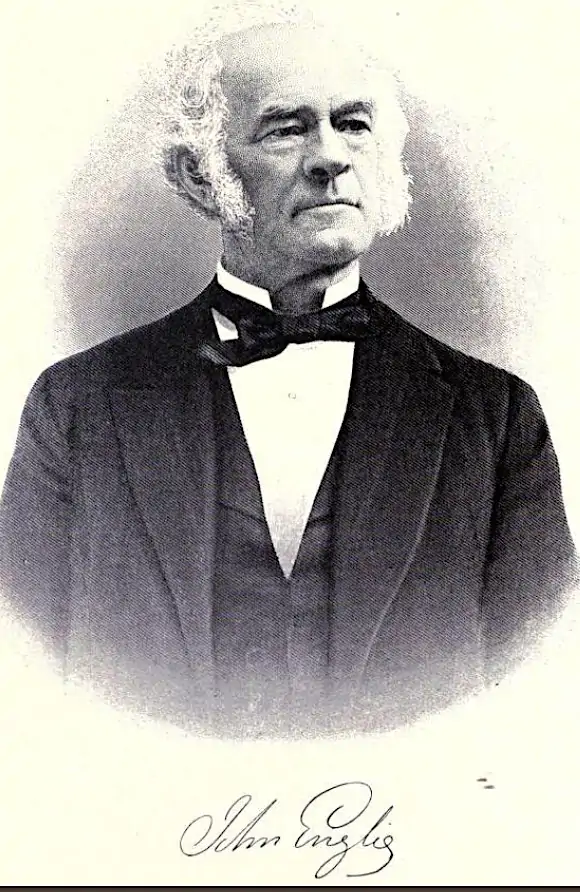

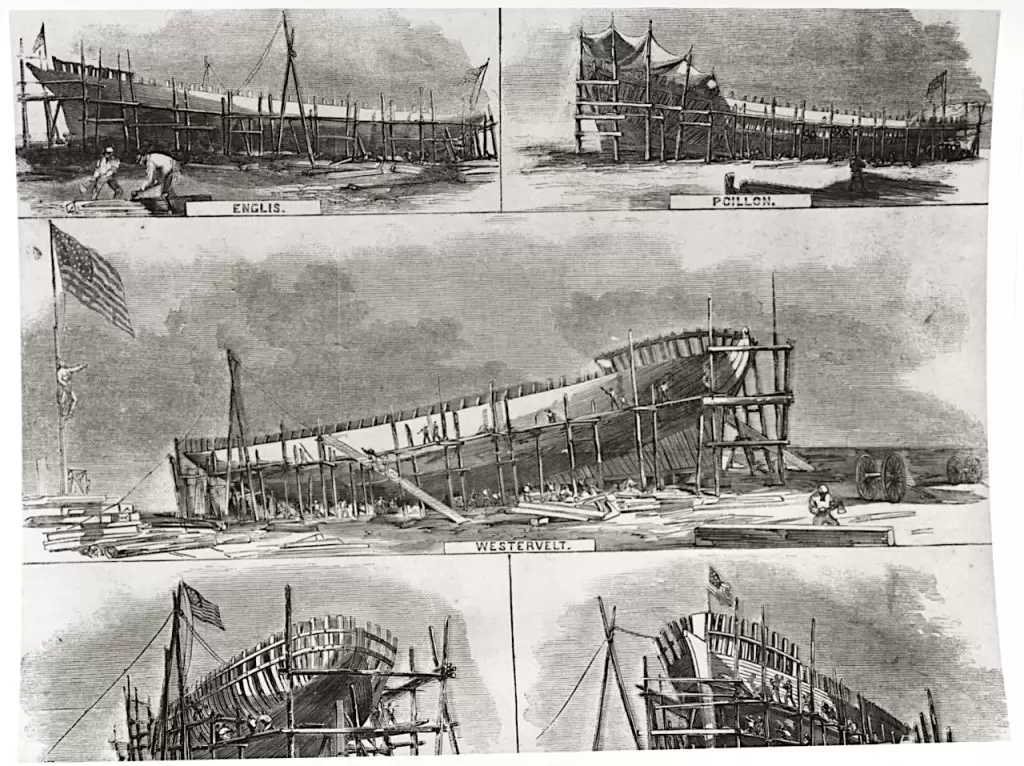
ENNIS, BARTHOLOMEW WILLIAM (or B. WILLIAM) (1839-1925). Private, 13th Regiment, New York State National Guard, Company H. Originally from Ireland, Ennis became a naturalized citizen on December 15, 1859. A printer at the time of the 1860 census, he enlisted at Brooklyn as a private on May 28, 1862, mustered immediately into the 13th Regiment, and mustered out three months later at Brooklyn on September 12.
In 1868, Ennis was nominated by the Fifth Ward Democratic Club, the German Democratic Club, and the Soldiers’ and Sailors’ Conservative Club for supervisor of the Fifth Ward. The censuses of 1870, 1880 and the Brooklyn Directories of 1876 and 1885 all list his occupation as printer. As per an article in The New York Times on July 5, 1896, he was active in Gouverneur K. Warren Post #286 of the G.A.R. and was present for the unveiling of Warren’s statue, designed by Henry Baerer, at Prospect Park Plaza in Brooklyn. The Warren Post raised $1,500 of the monument’s $10,000 cost. In 1903, he read a paper at a meeting of the Thirteenth Regiment’s Veterans Association, “Incidents at Little Round Top, Gettysburg.” In 1905, his application for an invalid pension was granted under certificate 1,116,001. Ennis spent some time in the Soldiers’ Home for Disabled Veterans in Bath, New York, from July to November 1908. As per his records there, he was 5′ 6″ tall with grey hair, blue eyes and a light complexion.
On December 31, 1912, Ennis’s poem, “The New Year,” was featured in the Brooklyn Daily Eagle. The poem, with the oft repeated refrain, “The New Year’s come to reign,” underscores the feelings of hope, joy, peace and love that exemplify new beginnings. According to his obituary in The New York Times, which confirmed his Civil War service, he was the historian of the 13th Regiment Veterans Association and was a contributor to magazines and periodicals. His obituary in the Brooklyn Union Standard indicated that he had been a national department and post officer in the G.A.R. The members of the Society of Old Brooklynites, 13th Regiment Veterans, and Brooklyn City Post #233 of the G.A.R. were invited to attend his funeral. His last address was 298 Macon Street in Brooklyn. Section 166, lot 27422.
ENTWISLE (or ENTWISTLE), ISAAC (1843-1914). Musician, 17th New York Infantry. A native of New York, Entwistle enlisted at New York City as a musician, although his soldier history indicates enlistment as a private, on September 25, 1861, and mustered into the Band of the 17th New York on that same day. He was discharged on June 18, 1862, allegedly for incompetence. As per the censuses of 1870, 1880, and 1900, he was a house painter. The Veterans Schedule of 1890 confirms his Civil War service. In 1901, his application for a pension was approved, certificate 1,160,448. His last residence was 858 East 23rd Street in Brooklyn. Myocarditis was the cause of his death. Section 5, lot 34086, grave 2.
ENTWISTLE, JAMES (1827-1899). Major, 176th New York Infantry, Company C; first lieutenant, 6th New York Infantry, Companies D and K. Originally from Sheffield, England, he was a wood moulder, according to the census of 1860. At the onset of the Civil War, Entwistle enlisted at New York City as a private on April 25, 1861, and mustered into Company D of the 6th New York five days later. On February 17, 1862, he was transferred into Company K, and was promoted to first lieutenant on April 25, 1862. He mustered out on June 25, 1863, at New York City. Subsequently, he enlisted as a captain on October 9, 1863, was commissioned into Company C of the 176th New York at New Orleans, Louisiana, on December 16, and was promoted to major on November 14, 1864. As per his muster roll, he was absent “in arrest” as of February 2, 1865, awaiting court-martial (the result of which is unknown). On October 1, 1865, he was listed as absent, on leave, and then listed as present as of February 1866. He mustered out on April 27, 1866, at Savannah, Georgia.
The census of 1870 lists Entwistle’s occupation as sash and blind-maker with real estate and personal estate each valued at $2,000. In 1879, his application for an invalid pension was approved under certificate 266,809. In 1880, he was living in Jersey City, New Jersey, and working as a steward in a hotel. The 1890 Veterans Schedule, at which time he was living in Cora, Montana, validates his Civil War service and indicates that he was “feeble for his age.” Entwistle joined the G.A.R. on May 8, 1893. On October 13, 1899, the day of his death, caused by rheumatism with resulting heart disease, he was brevetted major of Company D of the 176th New York. As per his obituary in the New York Herald, Entwistle was a Freemason; members of his lodge and survivors of the 6th and 176th New York were invited to attend his funeral. His died in Meredith (Delaware County), New York. Shortly after his death, S. Agnes Entwistle applied for and was awarded a widow’s pension under certificate 492,142. Section 162, lot 15468, grave 2.
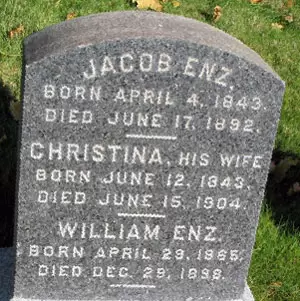
ENZ (or ENCE), JACOB (1843-1892). Private, 16th New York Cavalry, Company G; 3rd New York Provisional Cavalry, Company A. Enz, who was born in Germany, enlisted as a private on February 22, 1864, at Buffalo, New York, and mustered immediately into the 16th New York Cavalry. As per his muster roll, he was a 5′ 2″ tall laborer with grey eyes, light hair, and a fair complexion. He was taken as a prisoner of war on July 30, 1864, when his regiment was at Fairfax, Virginia, and paroled on February 22, 1865. He transferred into the 3rd New York Provisional Cavalry on August 17, 1865, when his regiment was consolidated, and mustered out on September 21 at Camp Barry, Washington, D.C.
According to the census of 1870, he was a laborer. His last residence was 72 West Broadway in Manhattan. Enz died of phthisis. Christina Enz, his widow, who is interred with him, died in the General Slocum steamboat disaster in New York Harbor in 1904. Section 135, lot 27263, grave 500.
ERDT, CHARLES ERNST (1836-1908). Captain, 41st New York Infantry, Companies E and G. Of German birth, he enlisted as a first lieutenant at New York City and was commissioned into Company E of the 41st New York on June 6, 1861. Upon his promotion to captain on August 4 of that year, he was transferred into Company G, and was discharged on May 19, 1862, at Franklin, Tennessee. Erdt was the recipient of an invalid pension, certificate 1,109,028.
According to the census of 1880, at which time he was living in Montclair, New Jersey, he was employed as a corn merchant. The New York City Directory for 1888 lists him as a broker. His last residence was 80 Union Street in Montclair, New Jersey. Cerebral thrombosis caused his death. His widow was awarded a pension in 1908, certificate 675,068. Section 174, lot 18405, grave 11.
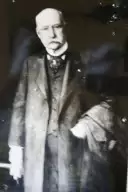
ERHARDT, JOEL BENEDICT (1839-1909). Captain, 1st Vermont Cavalry, Company A; private, 7th Regiment, New York State Militia, Company F. Born in Pottstown, Pennsylvania, he came to New York City at the age of three. When the Civil War began, he successively joined the 9th Militia, the 2nd, and the 71st, but quit each due to delays, and marched off as a member of the famous 7th Regiment of the New York State Militia, serving as a private for 30 days in 1861. He later helped to raise the 1st Vermont Cavalry, entering as a first lieutenant. The regiment’s colonel, Charles H. Tompkins, commended him from Raccoon Ford, Virginia, on August 3, 1862, citing that he deserved praise “for coolness and gallantry under the peculiar circumstances, it requiring as much bravery and more firmness to prevent a rout than to insure a victory.” Erhardt was promoted to captain in 1863. He was then appointed a Provost Marshal of New York City, where, according to Secretary of War Stanton, he recruited few men, but the men he recruited were fighters, not bounty jumpers. During the Draft Riots of July 1863, he was attacked while visiting a building at Broadway and Liberty Street in Manhattan. For three hours he held off a mob with his pistol, until help arrived which allowed his escape.
At the time he applied for a passport in 1868, Erhardt was 5′ 10½” tall with a high forehead, brown eyes, light hair, florid complexion, and small chin. After the war, he served as assistant United States Attorney in Brooklyn and was appointed Police Commissioner. President Arthur appointed him United States Marshal for the Southern District in 1883. He was the unsuccessful Republican candidate for mayor of New York City in 1888. Erhardt also served as Collector of the Port of New York from 1889-1893, and as president of the New York City & Northern Railroad. The census of 1900 indicates that he was a lawyer. In 1904, his application for a pension was approved, certificate 1,091,429. As per his obituary in the Rochester Democrat and Chronicle, he was president of the Lawyers Surety Company at the time of his death and died at his room at the Union League Club, where he was staying while his family vacationed abroad. That obituary also noted that he had been an officer in the State Trust Company, the Bowery Savings Bank and other financial corporations. He last resided at 120 East 57th Street in Manhattan. The cause of death was angina pectoris.
His obituary in the New York Sun included details about his funeral at the Madison Square Presbyterian Church which included a special service co-conducted by W.E. Boyd, the chaplain of Lafayette Post #140 of the G.A.R., of which Erhardt was a member. The pallbearers were Admiral A. S. Kenny, retired; Senator Elihu Root, Justice Edward Patterson, Judge Edward T. Bartlett, Col. Frederick Wagner, John Whalen, George G. DeWitt, George S. Terry, George R. Sheldon, Thomas A. Hunt, Thomas B. Shaw and William H. Hollister. Delegations from the Union Club, the Lafayette Post, the Freemasons, the Loyal Legion (a patriotic fraternal group), the St. Nicholas Society, and the Bar Association were in attendance. Belle Erhardt, who is interred with him, applied for and received a widow’s pension in 1910, certificate 699,642. Section 15, lot 17981.
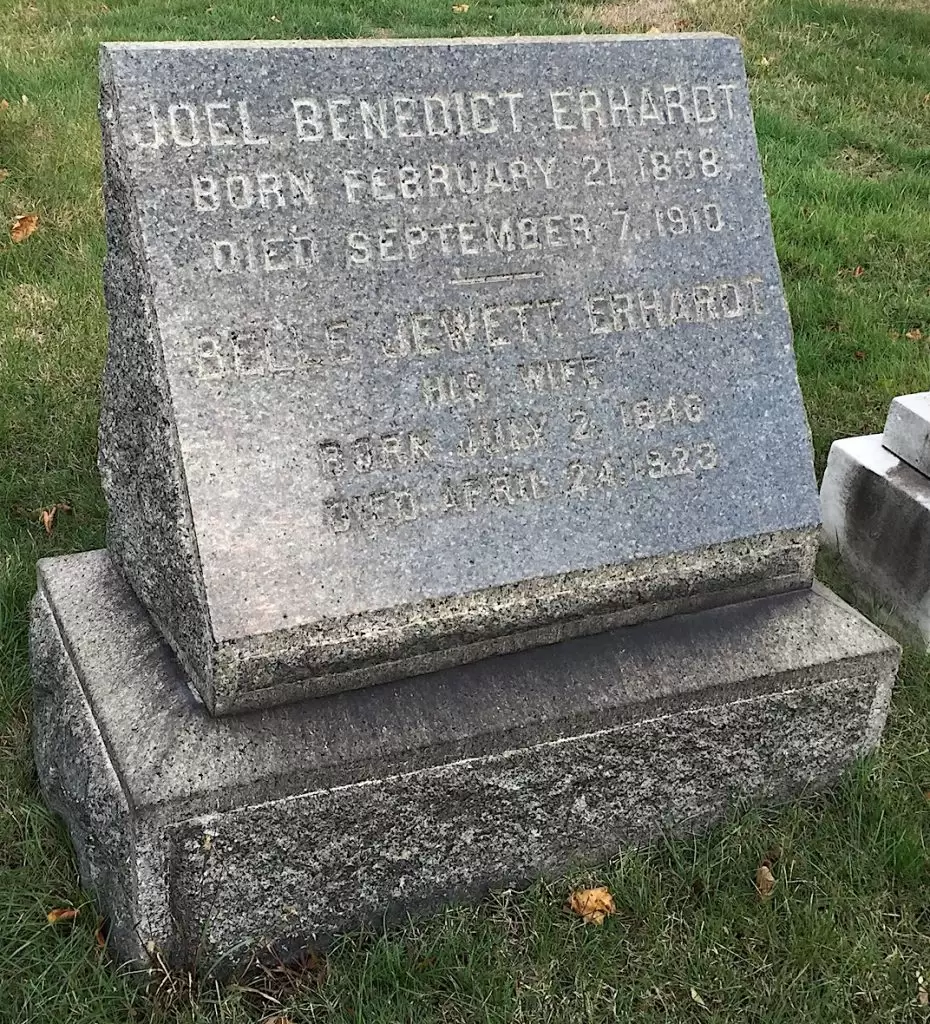
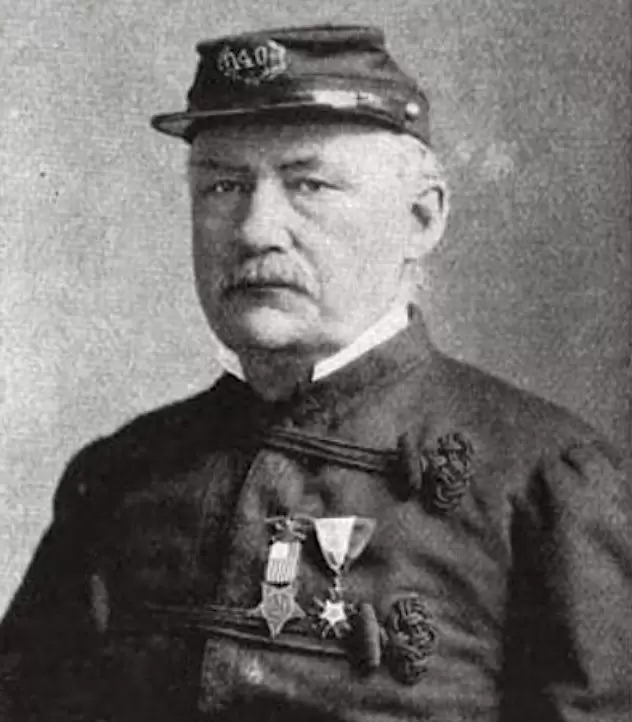
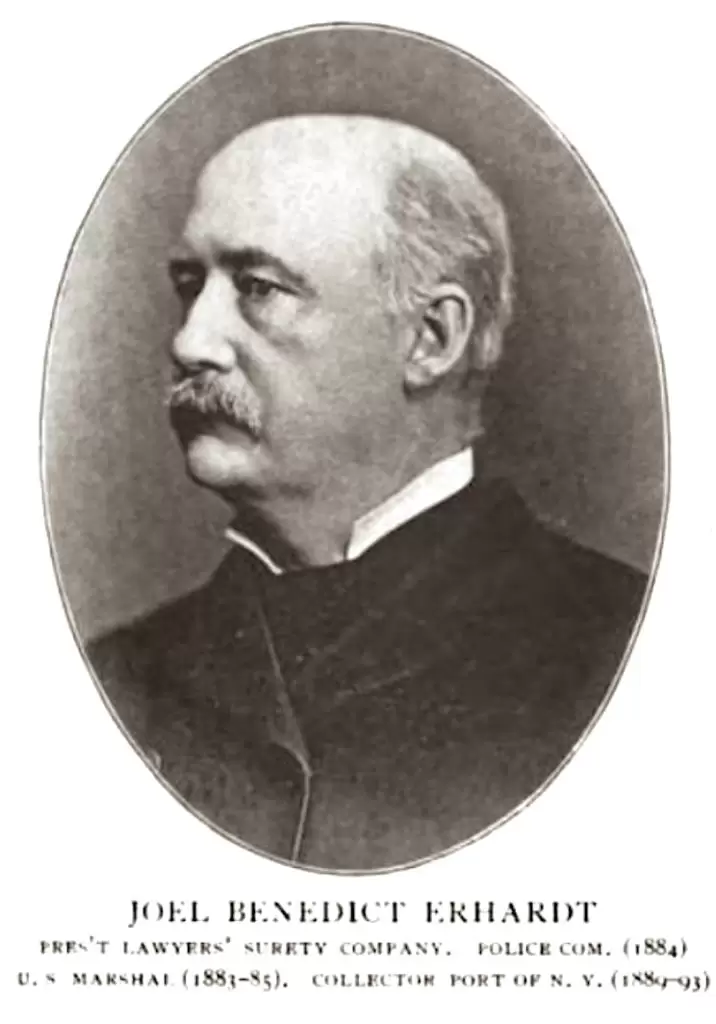
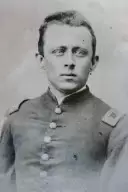
ERICKSON, JOHN H. (1841-1888). Second lieutenant, 57th New York Infantry, Company E; 61st New York Infantry, Company K. A native of Norway who immigrated to Brooklyn (although his muster roll records Rahway, New Jersey, as his birthplace), his family lived in Columbus, Mississippi, as per the 1860 census. At the onset of the Civil War, he enlisted on August 19, 1861, at New York City, as a first sergeant. A student, he was 5′ 8″ tall with blue eyes, dark hair and a light complexion. On October 4, 1861, he mustered into Company E of the 57th, where his father, Julius E. (see), and brother, Julius H. (see), both served. He was promoted to second lieutenant on July 27, 1862.
After being captured in action on October 14, 1863, in Auburn, Virginia, Erickson was later paroled. As per his soldier record, he signed a petition complaining about conditions at Camp Sorghum. That camp, located in Columbia, South Carolina, had few physical barriers but was known for its terrible conditions, lack of food, clothing and medicine. Because the typical rations were cornmeal and sorghum syrup, it was known as Camp Sorghum. His muster roll indicates that he was also incarcerated at Libby Prison in Richmond, Virginia, from April until December 1864. On December 6, 1864, he transferred into the 61st New York; he was discharged on May 5, 1865. He enrolled in the 9th United States Veteran Volunteer Infantry on August 25, 1865, at Indianapolis, Indiana, as a second lieutenant, was promoted to first lieutenant on November 8, and mustered out on March 24, 1866, at Indianapolis.
The censuses of 1870 and 1880 and the Brooklyn Directories for 1879 and 1888 all list his occupation as gauger, a customs official who measures the barrels of imported barrels of liquor to determine the duty. His last residence was at 419 Union Street in Brooklyn. He died of heart disease. Section 189, lot 17813.
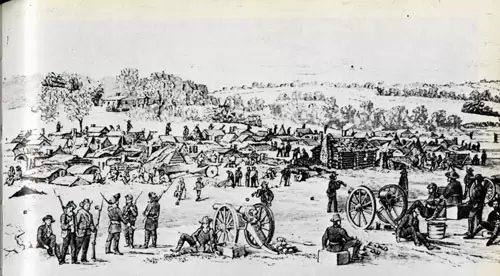
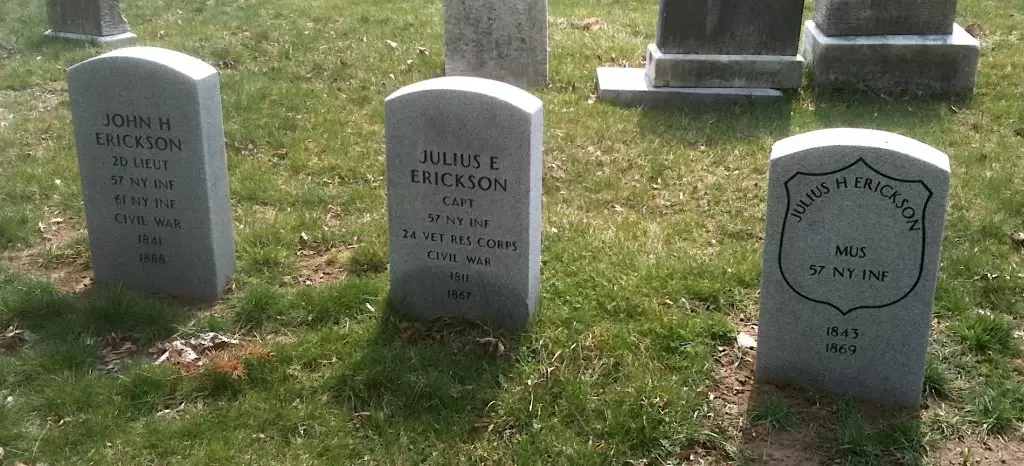
ERICKSON, JOHN P. (1826-1907). Medal of Honor recipient; captain, United States Navy. Born in Sweden, although other documents indicate London, England, he immigrated to the United States in 1850. During the Civil War, he enlisted as a seaman in the United States Navy on May 5, 1864. At that time, he was 5′ 4″ tall with blue eyes, brown hair and a florid complexion. He was captain of the forecastle (living quarters) on board the USS Pontoosuc. For his actions from December 24, 1864 to February 22, 1865, during the capture of Fort Fisher and Wilmington, North Carolina, he was awarded a Medal of Honor for his skill, gallantry and coolness while under enemy fire during that assault. He was severely wounded in that battle and sent to the hospital at Portsmouth, Virginia.
According to the Brooklyn Directory of 1873, Erickson was a peddler; the 1880 census lists him as a laborer who had been unemployed for nine months. The Brooklyn Directory for 1885 records his occupation as milkman. The Veterans Schedule for 1890 confirms his Civil War service, notes that he lost his right arm and was pensioned, although information about his pension is not known. His obituary in the Daily Standard Union, which confirms his Medal of Honor achievement and cites his birthplace as Sweden, states that he lived in Brooklyn for half a century. In 1907 Erickson succumbed to nephritis, a kidney disease. His grave at Green-Wood had no marker for more than 90 years. Section 15, lot 17263, grave 1810.
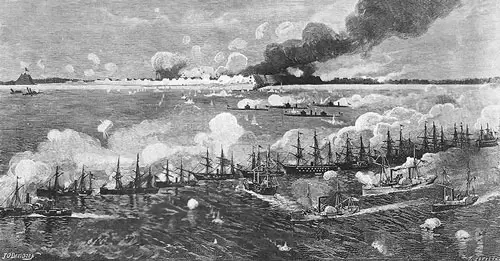
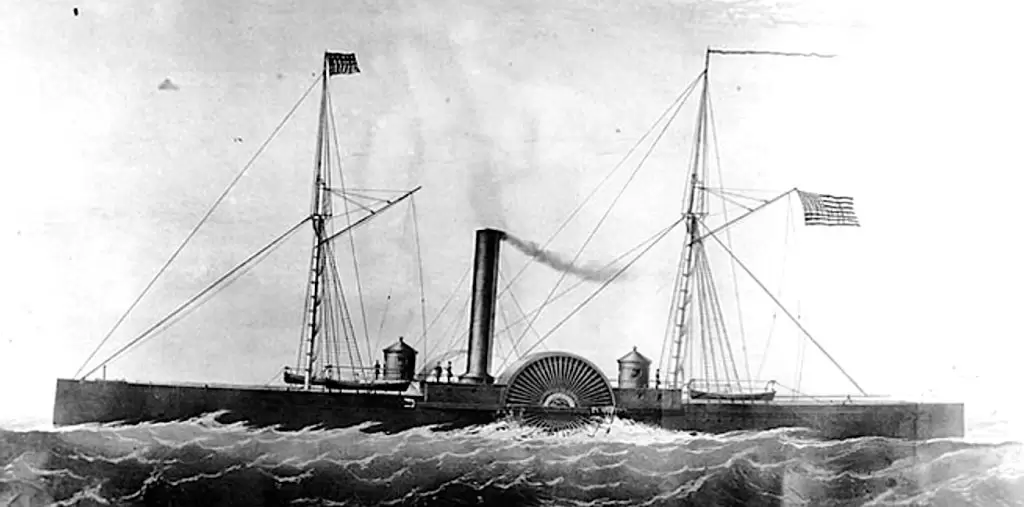
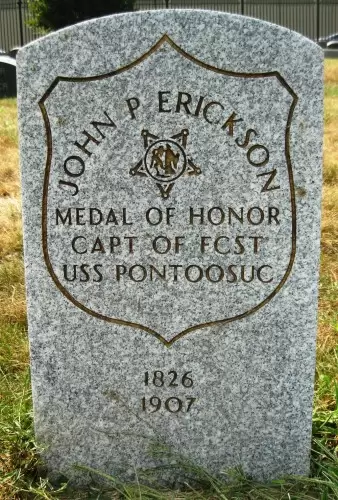
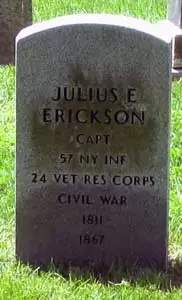
ERICKSON, JULIUS E. (1811-1867). Captain, 57th New York Infantry, Company E; 24th Regiment, 9th Veteran Reserve Corps. Erickson was born in Christiana (now Oslo), Norway. As per Karl Jakob Skarstein, a historian from Norway who is studying Norwegian immigrant soldiers in the Civil War, Julius’s birth name was Julius Olaus Edvard Saxild. His father’s name was Erik Saxild, hence his son’s surname was Erickson. On May 10, 1838, he married Hanna Katrine Hansen. The couple lived in Farsund, near the southern tip of Norway. Erickson was an organist. Skarstein notes that Erickson was a notorious con-man in Norway and was the subject of numerous newspaper articles circa 1850. He was charged with fraud and embezzlement and likely left Norway to escape the law.
Erickson immigrated to America around 1853. As per the census of 1860, Erickson was living in Columbus, Mississippi. Prior to enlisting in April 1861 with his two sons, John H. (see) and Julius H. (see), Erickson was employed as an organist and music teacher. He was commissioned as a captain of Company E of the 57th New York Infantry, where he engaged in many battles with the Army of the Potomac. While serving in the 57th, he was shot in the left hip on or about June 25, 1862, while commanding the advanced pickets in front of General Sumner’s Headquarters near Fair Oaks, Virginia. In July 1863, he was honorably discharged from this regiment and appointed as a captain in the Invalid Corps. On February 23, 1864, he was appointed captain of the 24th Regiment of the Veteran Reserve Corps. He next served as Field Officer of the Day for the garrison in Washington, D.C., from December 1864 to December 1865. Due to “hard service on horseback,” he developed over the course of the year a disabling anal fistula that made it painful for him to sit for very long in any position and from which he never fully recovered. He was honorably discharged from service on June 30, 1866.
Erickson received an invalid pension because of the fistula in 1867, certificate 83,968. His obituary in the New York Daily Tribune confirmed his military service and noted that he was transferred to the 9th Veterans under medical certification. That obituary also stated that he was an accomplished student of mechanics and a Freemason. His death, in Washington, D.C., was attributed to his wartime debilities. Hannah C. Erickson, who is interred with him, received a widow’s pension after his death in 1867, certificate 255,882. Section 189, lot 17813.

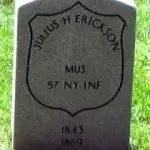
ERICKSON, JULIUS H. (1843-1869). Musician, 57th New York Infantry, Company E. Born in Norway, his family lived in Columbus, Mississippi, at the time of the 1860 census. At the onset of the Civil War, he enlisted on August 19, 1861, at New York City, and mustered into the 57th on October 4, 1861. On July 11, 1862, Erickson was discharged for disability at Philadelphia, Pennsylvania. His father, Julius E. (see), and his brother, John H. (see), also served with the 57th New York. His last residence was 58 Schermerhorn Street in Brooklyn. Consumption claimed his life. Section 189, lot 17813.

ERKENBRACK, THOMAS A. (1844-1868). Private, 84th New York (14th Brooklyn) Infantry, Company B; 5th New York Veteran Infantry, Company B. Originally from Troy, New York, Erkenbrack enlisted at Brooklyn on August 26, 1862, and mustered into the 14th Brooklyn the next day. A sail-maker, he was 5′ 7¾” tall with blue eyes, brown hair and a light complexion. Captured on July 1, 1863, at Gettysburg, Pennsylvania, he was confined at Richmond, Virginia, until he was paroled on August 26, 1863. He transferred from the 14th Brooklyn into the 5th New York on June 2, 1864. Captured on March 31, 1865, at White Oak Road, Virginia, he was paroled on April 2, and mustered out on June 23 at Annapolis, Maryland.
The 1868 Brooklyn Directory lists Erkenbrack as a sail-maker. As per his obituary in the Brooklyn Daily Eagle, members of his company in the 14th Regiment were invited to attend his funeral. His last residence was 480 Atlantic Avenue in Brooklyn. He died from consumption that he contracted while serving in the War. In 1891, his father, Abraham Erkenbrack, applied for a pension, application 511,358, but it was never certified. Section A, lot 8998.
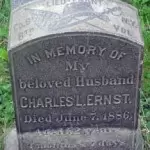
ERNST, CHARLES W. L. (1834-1886). Second lieutenant, 8th New York Infantry, Companies B and A. A native of Germany, he enlisted as a private at New York City on April 23, 1861, the same date that he mustered into Company B of the 8th New York. He became sergeant of his company on June 30 and then rose to second lieutenant effective upon his transfer to Company A on July 25. Ernst resigned on December 23, 1861. His last residence was 11 St. Marks Place in New York City. He died from apoplexy. Section 114, lot 8999, grave 438.
ERNST, WILLIAM M. (1839-1903). Corporal, 34th Ohio Infantry, Company A. Originally from Cincinnati, Ohio, Ernst enlisted as a corporal on July 27, 1861, and mustered into Company A of the 34th Ohio Infantry. (His description in the G.A.R. sketchbook indicates that he was a private.) He was discharged on May 31, 1862, for an appointment in recruiting for the 52nd Ohio Infantry. The 1880 census notes that he was a hogs merchant. On May 13, 1885, Ernst mustered into Marquis de Lafayette Post #140 of the G.A.R.; his description indicates that he was a merchant living in New York City. His last address was 422 West 22nd Street in Manhattan. He died from a stroke at the Southwest corner of West 14th Street and 8th Avenue in Manhattan. Section 56, lot 4376.
ERVING, JOHN (1789-1862). Colonel, 1st Light Artillery, United States Army. Born in Massachusetts, Erving was commissioned a second lieutenant in 1809, and fought in the War of 1812 and the Mexican War. A career officer, he was periodically promoted over the ensuing decades, finally reaching the rank of colonel of the 1st Artillery in 1857, and serving until he retired on October 26, 1861. The New York Times, in its September 12, 1861 edition, named Erving as one of 52 officers placed on the retirement list by an act of Congress; Erving was listed as among the most prominent. He died in New York City exactly one year after his retirement. Roger Hunt included details about his service in his latest book in his “Colonels in Blue” series, subtitled, U.S. Colored Troops, U.S. Armed forces, Staff Officers and Special Units (McFarland Press).
During Erving’s military service, his family lived in Philadelphia, Pennsylvania, before relocating to New York City. John Erving, his son, who married into the Van Rensselaer family, also served in the Union Army during the Civil War. His grandson, John Langdon Erving achieved notoriety in 1892 when he accompanied Charles Parkhurst on an undercover investigative tour of “vice dens” in New York City. The young Erving earned the nickname “Sunbeam” after dancing with naked girls at one of the spots that they visited. John Erving’s military correspondence, diaries and genealogical data are at the New-York Historical Society in Manhattan. Section 170, lot 13710.
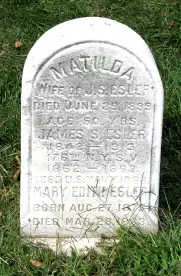
ESLER, JAMES SIMPSON (1841-1912). Private, 52nd Regiment, New York State National Guard; 176th New York Infantry; acting third assistant engineer, United States Navy. Esler, a Brooklyn native, enlisted there as a private on November 5, 1862, and mustered into the 52nd National Guard that day. As per his muster roll, he was a machinist by trade who was 5′ 10″ tall with grey eyes, light hair and a fair complexion. On December 22, 1862, he transferred into Company I of the 176th New York. After being taken as a prisoner of war on June 23, 1863, at Brashear City, Louisiana, he was paroled and then returned to his regiment on August 17 of that year. He mustered out on November 16, 1863, at New York City. Esler noted that he had blood poisoning resulting from exposure that led to his discharge for disability. He was appointed as an acting third assistant engineer in the United States Navy on April 18, 1864, and served on three ships, among them the USS Bienbelle and the USS Virginia. He was discharged on July 23, 1866.
In civilian life, Esler was a machinist by trade. In 1892, he applied for and received an invalid pension under certificate 34,970. At the time he applied for his Naval pension, he indicated that he had a scar on his neck from a burn. From July 1909 through February 1910, he was a resident at the Soldiers’ Home in Bath, New York. His last residence was at 431 Hoyt Street, Brooklyn. His death was caused by apoplexy. The inscription on his gravestone validates his Civil War service. Section 115, lot 11193, grave 241.
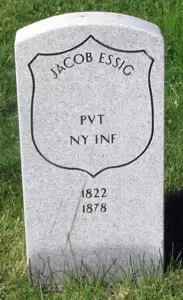
ESSIG, JACOB (1822-1878). Private, 68th New York Infantry, Company G; 15th New York Heavy Artillery, Company B. A native of Germany, Essig enlisted as a private at New York City and mustered into the 68th New York on August 14, 1861, and transferred out on January 1, 1862. He also served in the 15th New York Heavy Artillery although the specific dates are unknown. His last residence was on East 40th Street in Manhattan. The cause of his death was pneumonia. Section 15, lot 17263, grave 2470.
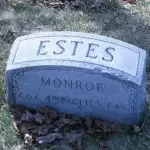
ESTES, TRUMAN MONROE (1836-1889). Private, 4th New York Cavalry, Company C. Born in Vermont and a machinist by trade, Estes enlisted as a private on August 29, 1861, at Yonkers, New York, and mustered into his company that same day. He was discharged for disability on November 6, 1862, at Cumberland, Maryland.
According to the census of 1870, when he lived in Essex, New Jersey, the Brooklyn Directory for 1874, and the census of 1880, he worked as a machinist. In 1879, he applied for and received an invalid pension, certificate 451,752. Estes last lived at 317 Van Brunt Street in Brooklyn. His widow, Matilda Estes, received a pension in 1890, certificate 325,168. His tombstone confirms his military service. Section 6, lot 20118, grave 75.
EULER, JOHN H. (1839-1900). Private, 8th Regiment, New York State Militia, Company F. A New York City native, Euler served with the 8th Regiment for three months in 1861. The 1876 New York City Directory lists him as a carpenter; the 1880 census records his profession as house framer and the 1888 New York City Directory states that he worked as a contractor. In 1894, he successfully applied for a pension, certificate 956,632. He last lived at 158 East 127th Street in Manhattan. “Valve heart legions” is listed as his cause of death. Mary Euler, who is interred with him, applied for and received a widow’s pension, certificate 503,823. Section 14, lot 6740.
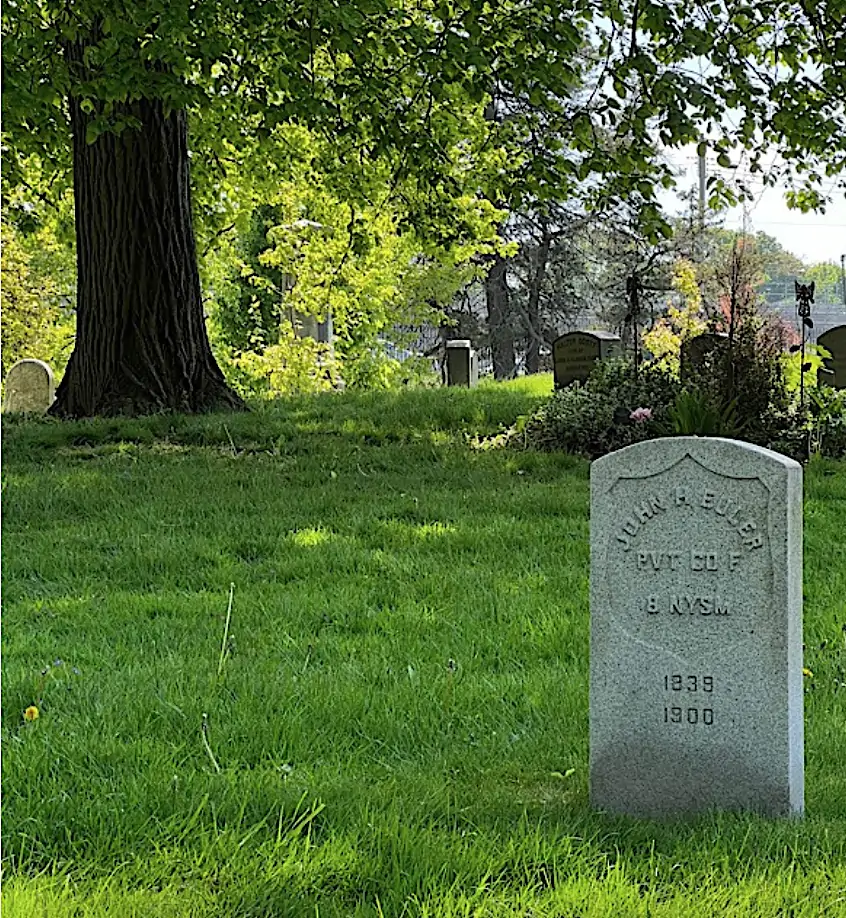
EUNSON, EUGENE SILSBEE (1841-1914). Major by brevet; captain, 174th New York Infantry, Company C; 162nd New York Infantry, Company C; sergeant, 37th Regiment, New York State National Guard. Eunson, a bookkeeper by trade, who was 5′ 10″ tall with blue-gray eyes, brown hair and a dark complexion, was born in New York City. An ancestor on his mother’s side came to the Americas with Henry Hudson and another ancestor was on George Washington’s staff during the Revolutionary War. Eunson joined Company G of the 37th Regiment on May 1, 1860, and mustered with his company when it was activated for three months in 1861. He re-enlisted as a corporal and served in the 37th Regiment from May 29-September 2, 1862, being promoted to sergeant during that period.
Eunson re-enlisted at New York City on October 17, 1862, as a first lieutenant, and was commissioned into the 174th New York the next day. He was promoted to captain on July 14, 1863, took part in the siege of Port Hudson, Louisiana, and transferred into the 162nd New York on February 17, 1864. Wounded in the thigh at Pleasant Hill, Louisiana, on April 9, 1864, and taken prisoner when the field hospital he was in was overrun, he praised “Surgeon Robert Cutler or Cutter, of a Western Regiment who voluntarily remained to care for our wounded.” Held at a Confederate hospital there, Eunson was paroled at Red River Landing, Louisiana, on June 16, 1864. He then was transferred to the St. James Army Hospital at New Orleans, stayed there a few days, then returned by steamer to New York City, accompanied by a doctor who obtained a leave of absence to do so, and remained there until his leave of absence expired. He was then ordered to Camp Parole at Annapolis, Maryland, where he stayed until he was exchanged in December. Found unfit for field service, he was assigned to the Draft Rendezvous on Hart Island in New York Harbor, where he performed light duty until his term of service expired and he was discharged on October 13, 1865. On May 12, 1866, he was brevetted major by New York Volunteers and United States Volunteers, “for faithful and meritorious services at the siege of Port Hudson, Louisiana, and the Battle of Pleasant Hill, Louisiana, to date from March 13, 1865.”
After his discharge, Eunson rejoined the 37th as a private, then was elected captain of the 71st in May 1866, became a major on November 15, 1869, and remained in that rank until his resignation in 1872. (The 37th was consolidated into the 71st Regiment.) Active in the Freemasons and other civic organizations, he was instrumental in founding the Veteran Association in which he held the positions of major, lieutenant colonel and colonel. In 1892, his application for an invalid pension was granted, certificate 842,062. He last lived at 270 West 12th Street in Manhattan. His death was attributed to a cerebral hemorrhage. Section 186, lot 19090, grave 4.
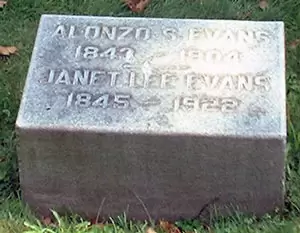
EVANS, ALONZO SAMUEL (1843-1904). Private, 47th New York Infantry, Company C; 8th Regiment, New York State National Guard, Company E; 84th Regiment, New York State National Guard, Company F. Evans enlisted as a private at New York City on August 23, 1861, and mustered into the 47th New York on September 14, 1861. After his discharge, he re-enlisted as a private and served for 30 days in the 8th New York National Guard in 1863, and then served with the 84th New York National Guard for 100 days in 1864.
As per the censuses of 1870 and 1880, Evana was employed as a clerk; but he was listed as an agent in the New York Directories for 1872, 1880, 1888, and 1894. Evans also worked as an agent for the SPCA (Society for the Prevention of Cruelty to Animals). In an article in the New York Herald on October 11, 1884, mention was made that Evans appeared at the Harlem Police Court alleging that two members of the New York Jockey Club assaulted him. Evans was represented by Henry Bergh Jr., the founder of the ASPCA in 1866, who is also interred at Green-Wood. In another article in the New York Herald on February 24, 1894, it was reported that Evans arrested one of the employees of the 23rd St. Street Car Line who was salting the tracks; the employee refused to stop the practice when asked. The article went on to say:
The law permits the use of salt on crossings, switches and curves, but not on the straight tracks. I am glad the HERALD has aroused the public to the great abuse of the salt practice. The salt melts the snow on the tracks and makes it easier to remove, but its injury to horses cannot be estimated. The salt scratches the feet of horses and then enters the cut, causing swellings and a burning sensation which is apt to make the animals crazy. Then again it rots hoofs and makes horses useless….”
A livery stable owner went on to say:
I am glad the HERALD is calling attention to this abuse on the part of the street car companies. There is no doubt that all the car tracks are regularly salted after every snow storm. I have seen it done in the early morning hours. The loss to livery men to enormous every winter from this cause.
The Veterans Schedule for 1890 confirms his service in the Civil War. He was listed as a detective on the census of 1900. Evans was a member of the Royal Arcanum. He applied for an invalid pension in 1897, application 1,197,255, and his widow, Janette Evans, who is interred with him, applied for a pension in 1905 under application 838,509. Evans last lived at Chelsea Square in Manhattan. He died of angina pectoris at the home of his daughter on McDonough Street in Brooklyn. Section 180, lot 13972.
EVANS, CORNELIUS (1841/2-1872). Drum major, 51st New York Infantry, Company F; musician, 12th New York State National Guard. Cornelius was born in New York and raised in Manhattan by father James, a boiler maker, and his mother Eliza; they lived there with his younger siblings, Alfred, Mary, and Frances. At the age of 19, he is recorded in the 1860 census as being a laborer in Woodbridge Township, New Jersey.
Cornelius enlisted for three years on October 11, 1861, as a musician in New York’s 51st Infantry. He was discharged nearly a year later on October 9, 1862, at Pleasant Valley, Maryland, due to disability. Cornelius was also a drum major in the New York National Guard’s 12th Regiment. The announcement of his funeral in the New York Herald of April 27, 1872, confirms his service as a drum major in the 12th. When he registered for the draft in 1863, his listed profession was milkman.
After the war, Cornelius married his wife, Mary. By 1870, they had three children, naming their first-born son after his brother Alfred; they also had a daughter, Isabella, and another son, George. They lived in Brooklyn and Cornelius worked at the Greenpoint Post Office as a shipping clerk. He succumbed to smallpox that same year, dying in Renwick Smallpox Hospital on what is now called Roosevelt Island but was then known as Ward’s Island. His death certificate lists his occupation as salesman. His widow is listed in the 1872 New York City Directory as living at 225 East 29th Street in Manhattan, Section 17, lot 17245, grave 1596.
EVANS, FELIX (1817-1905). Loyal Union supporter. Evans was born in Birmingham, England. In 1849, he moved to Brooklyn and opened its first English chop house restaurant there in the Fort Greene neighborhood. During the Civil War, he wanted to show his loyalty to the Union by displaying a large American flag over his restaurant’s doorway. Little did he know that the flag he displayed had the wrong number of stars, missing one star for a new state added to the Union. People started to gather at the front of his restaurant and began to riot demanding that he remove the flag or the crowd would remove it and the restaurant. Evans then replaced the old flag with a new flag with the correct number of stars. Active in civic organizations, he was a member of the Freemasons, the Longfellow Lodge and the Sons of St. George. His last residence was 34 Schenck Avenue, Brooklyn. Section 164, lot 16046, grave 4.
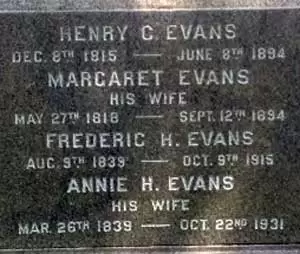
EVANS, FREDERIC H. (1839-1915). First lieutenant, 2nd Regiment, District of Columbia Volunteers, Company E. A native of Canton, Maine, he resided in Washington, D.C., at the onset of the Civil War. He was a first lieutenant in the 2nd District of Columbia Regiment. According to his Draft Registration record, filled out late in the War, he was a clerk assigned to the Quartermaster Department.
Evans relocated to Brooklyn in 1867 where he established and became president of the F. H. Evans Iron Works at 33-37 Hew Street in Brooklyn. Evans was at one time president of the American Institute. A Freemason, he also belonged to the Hanover and Municipal Clubs, the Brooklyn League, and the New York Chamber of Commerce. He was an honorary member of the 23rd Regiment, New York State National Guard. In addition, he helped organize the Amateur Opera Organization. He last lived at 73 Penn Street in Brooklyn. The cause of his death was nephritis. Section 166, lot 28800.
EVANS (or EVERS), FREDERICK (1842-1864). Corporal, 84th New York (14th Brooklyn) Infantry, Company I. A native of Wales, he was a plumber’s apprentice as per the census of 1860. He enlisted at Brooklyn as a private on June 30, 1861, mustered into the 14th Brooklyn on August 1, and was promoted to corporal on January 1, 1864. Wounded in the right thigh at the Battle of the Wilderness, Virginia, on May 8, 1864, he died on May 20 at Harewood Hospital in Washington, D.C. Though his paperwork was transferred to the 5th Veterans (to date from June 2, 1864), he died before the intended transfer. His muster roll notes that he was also borne as “Evers.” As per his obituary in the Brooklyn Daily Eagle, which confirmed the details of his death, members of his regiment who were in New York City were invited to attend his funeral. In 1870, Daniel Evans, his father, applied for and received a pension, certificate 211,833. Section A, lot 8100, grave 330.
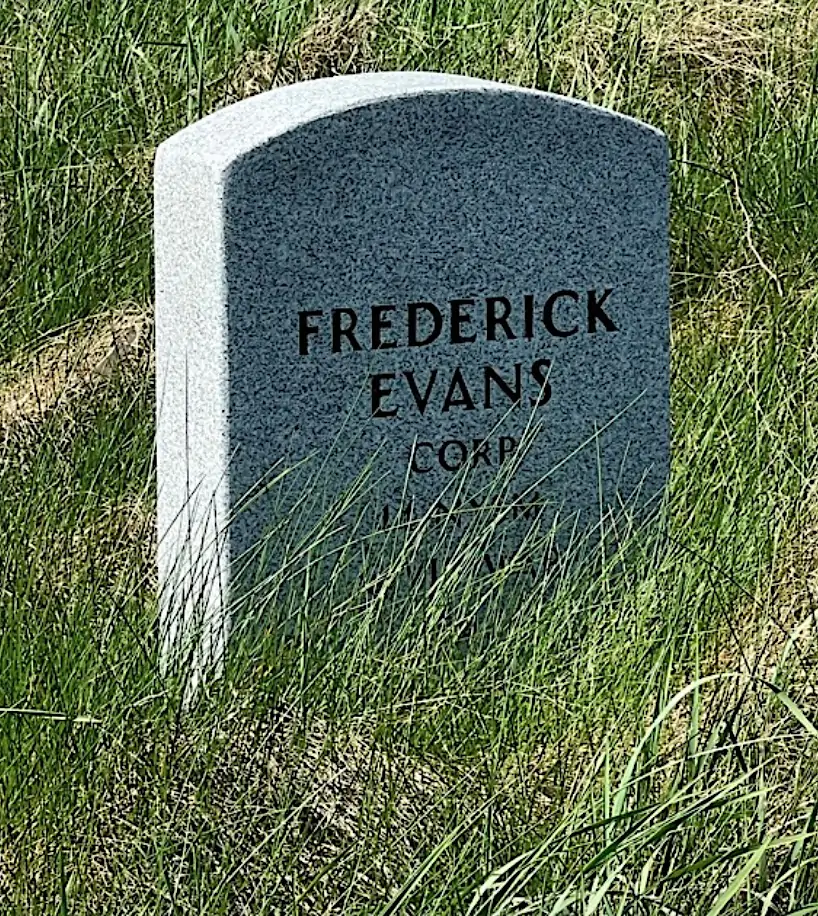
EVANS, HENRY M. (1841-1914). Corporal, 5th New York Heavy Artillery, Company I; private, 6th New York Battalion Heavy Artillery, Company A. Evans, a native of Constableville, New York, enlisted as a private at Grieg, New York, on August 21, 1862, and mustered into the 6th Battalion Heavy Artillery on September 11. On December 31, 1862, he was transferred into Company I of the 5th New York Heavy Artillery. He received a promotion to corporal on February 24, 1863, and mustered out on June 24, 1865, at Harpers Ferry, West Virginia.
Evans lived in Brooklyn at the time of the 1875 New York State census. As per the census of 1900, he had been married for twenty-five years, and lived in Manhattan. In 1902, his application for an invalid pension was approved, certificate 1,079,740. The census of 1910 reports that he and his wife lived in Manhattan on 105th Street, that he could read and write and that he worked as a clerk in the millinery business. He last lived at 201 West 104th Street in Manhattan. His death was attributed to pneumonia. Shortly after his death in 1914, Angeline Evans, who is interred with him, applied for and was granted a widow’s pension, certificate 773,683. Section 146, lot 27759, grave 2.
EVANS, KATE (or KATHERINE, KATERIN) BALLANTYNE (1833-1921). Abolitionist. A native of Edinburgh, Scotland, her ancestors were noted publishers there. Although her obituary says that the John Ballantyne who published the works of Sir Walter Scott was her father, that is incorrect; that John Ballantyne died in 1821, before Kate Ballantyne Evans was born. Her early life in the United States was spent in South Carolina. As per her obituary in the Brooklyn Daily Eagle, it was her firsthand observations of slavery there that made her an ardent abolitionist. That obituary notes that she came to Brooklyn where she joined the Plymouth Church and became an active member throughout her lifetime. The 1860 census reports that Evans lived in Brooklyn with her husband and two young children.
The Brooklyn Daily Eagle notes that during the Civil War, Evans worked with the Reverend Henry War Beecher (see) in his anti-slavery and other war-related work. The censuses of 1870 and 1880 note that she lived in Brooklyn and was keeping house for her husband, a Wall Street banker, and two sons; she lived at 168 Fort Greene Place in Brooklyn in 1880. The Brooklyn Directory for 1889- 1890 reports that she was an upholsterer and still lived on Fort Greene Place.
Evans’s obituary, which was headlined Patriot of Two Wars, notes that she was a strong supporter of the United States during the World War (World War I). A large American flag was draped in her sitting room and all visitors were asked to kiss the flag before engaging in conversation. The 1920 census reports that she was a widow, lived on Woodruff Avenue in Brooklyn, was not working and was a naturalized citizen. Her last residence was 181 Woodruff Avenue, where she succumbed to paralysis after a long illness. Section 207, lot 32092.
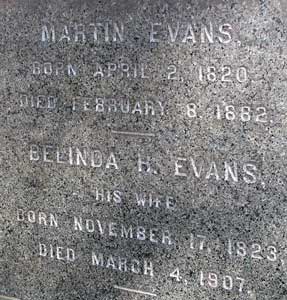
EVANS, MARTIN (1820-1882). Lieutenant colonel by brevet; major and additional paymaster, United States Volunteers, Paymaster’s Department. A Brooklyn native, Evans was a druggist according to the censuses of 1850 and 1860 and his 1863 Draft Registration. At the time of his passport application in 1856, he was 5′ 4″ tall with grey eyes, dark brown hair, a fair complexion, round chin, straight nose, and oval face. During the Civil War, Evans enlisted as a major on March 18, 1864, and was commissioned that day into the United States Volunteers Paymaster’s Department as major and additional paymaster. On November 28, 1865, he was promoted by brevet to the rank of lieutenant colonel “for faithful and meritorious service” before he mustered out on December 1.
As per the census of 1880, Evans was in the real estate business. His obituary in the New York Herald confirmed his Civil War service and stated that he was active in Democratic Party politics in the Seventh Ward. His last residence was at 163 Willoughby Street in Brooklyn, where he died from an overdose of morphine that he was taking for a nervous affliction. In 1890, Belinda Evans, who is interred with him, applied for and received a widow’s pension, certificate 347,804. Section 102, lot 232.
EVANS, RICHARD WASHINGTON (1842-1867). First lieutenant, 1st North Carolina Light Artillery (also known as the 10th Regiment of North Carolina Volunteers), Company F, Confederate States of America. Born in Wayne County, North Carolina, he was the son of Dr. Augustus Coutanche Evans, a special Confederate agent. Dr. Evans was sent to Europe to procure drugs and medicine for the Confederacy early in the Civil War; he died in 1863. At the onset of the Civil War, Richard Evans was a cadet at soon-to-be Confederate General D. H. Hill’s Military School at Charlotte, North Carolina. Richard Evans enlisted as a second lieutenant at Wayne, County, North Carolina, where he resided, on May 16, 1861, and was immediately commissioned into the 1st North Carolina Light Artillery, also known as the 10th Regiment of North Carolina Volunteers. On April 9, 1862, he wrote a letter to his mother from Fort Macon, North Carolina, describing life under siege by Union forces; that letter is included among his father’s archived papers from that era. He was taken as a prisoner of war at Fort Macon on April 25, 1862, paroled on August 15 of that year and exchanged the next day. Evans was promoted to first lieutenant on February 13, 1863, and discharged on an unknown date.
His obituary in the Wilmington [North Carolina] Journal notes that a friend said that Evans “bore about him in the most evident manner, principle, fairness, good breeding, and all the qualities that are creditable and correct.” The obituary stated that he “…served faithfully to the time of the surrender, proving gallant in action, and faithful in the performance of every duty….His loss deprives his family of one to whom they trustfully looked for support.” At the time of his death, he was a resident of 54 Van Dam Street, New York City, where he succumbed to cholera. Section 121, lot 11189, grave 150.
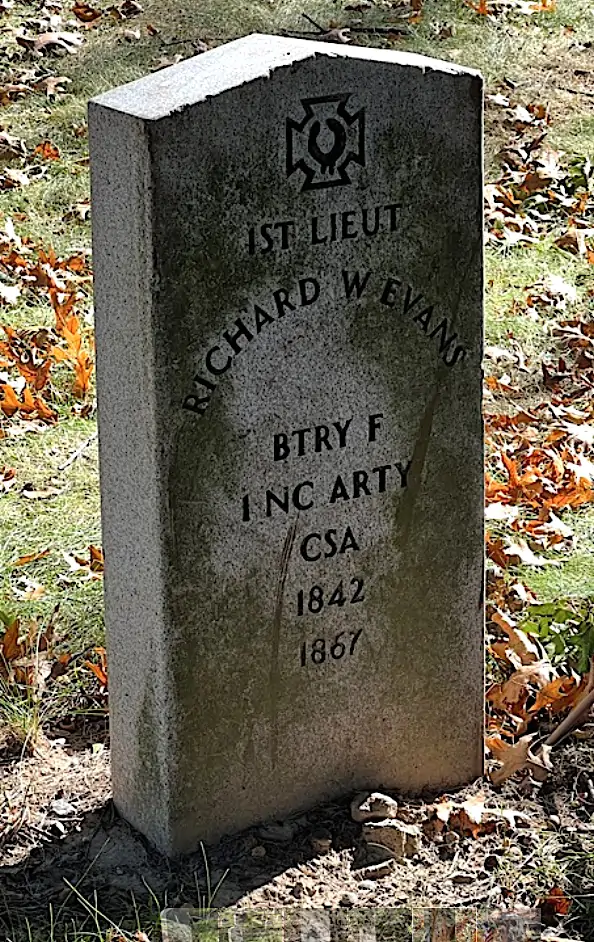
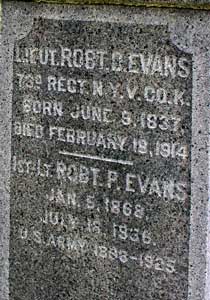
EVANS, ROBERT D. (1837-1914). First lieutenant, 73rd New York Infantry, Companies H and K; private, 7th Regiment, New York State Militia, Company A. A New Yorker by birth, he was a clerk as per the 1860 census. On April 17, 1861, he enrolled to serve 30 days, mustered in as a private with the 7th Regiment on April 26, and mustered out with his company on June 3 at New York City. He re-enlisted at New York City as a first lieutenant on June 5, 1861, and was commissioned into Company H of the 73rd New York on September 29 of that year. The regiment was also known as the second Fire Zouaves. During his service with the 73rd, he was transferred to Company K, and was discharged on December 31, 1862. Wounded in action at some point, he was discharged for disability.
The 1870 census indicates that Evans was living in Albany, New York, and employed there as a clerk at the State Department. He was still in Albany in 1880 but worked as a painter; the censuses of 1900 and 1910 show that he was in New York City working in real estate. In 1904, he applied for and received an invalid pension under certificate 1,091,953. An article in the New York Herald on April 20, 1911, 50 years after the 7th was called to serve in the Civil War, highlighted the members of that Regiment who paraded down Broadway, 2,500 strong, carrying their Civil War flags and having as their rear guard, two brass howitzers. Evans was among four men who appeared in a photograph accompanying the article that celebrated the aged veterans and the appreciation of the public for their service. The piece went on to say that the veterans, many of whom came long distances to march, enjoyed sharing war stories and renewing acquaintances at a banquet held in their honor. After the Titanic disaster on April 15, 1912, Evans’s letter to the editor of the New York Herald appeared in print:
To THE EDITOR OF THE HERALD:—
I cannot refrain from offering a humble suggestion at this time as a safeguard against the repetition of the dreadful misfortune that has befallen the Titanic. Here it is :—
Have it understood by all vessels that have the wireless at their command that when they come in sight of the dreaded icebergs they shall start the wireless giving their longitude and latitude. I have seen icebergs and doubt if a vessel could be built strong enough to stand up under the blow of a vessel head-on going at the speed of our modern steamships. ROBERT D. EVANS. NEW YORK, April 16. 1912.
As per his obituary in the New York Herald, he was a member of the Loyal Legion (whose members were Civil War officers), and served as president of the Society of War Veterans of the 7th New York State National Guard. He resided at 100 West 87th Street in Manhattan. The cause of his death was angina pectoris. Winifred Evans applied for and received a widow’s pension in 1920, certificate 905,347. Section 54, lot 6667.
EVANS, SAMUEL (1840-1914). Coal heaver, United States Navy. Evans was born in Scotland. According to his pension record, he served as a coal heaver aboard the USS Minnesota, USS North Carolina, USS James Adger, USS Ohio, and the USS Brandywine. Further details are unknown. It appears that his application for an invalid pension, filed in 1890, was contested. On January 13, 1894, his attorney testified that Evans was unable to do manual labor; however, he did eventually receive a pension. Evans, who died after being accidentally struck by an automobile, last lived at 4105 Hudson Boulevard in Jersey City, New Jersey. Section 147, lot 22060, grave 1.
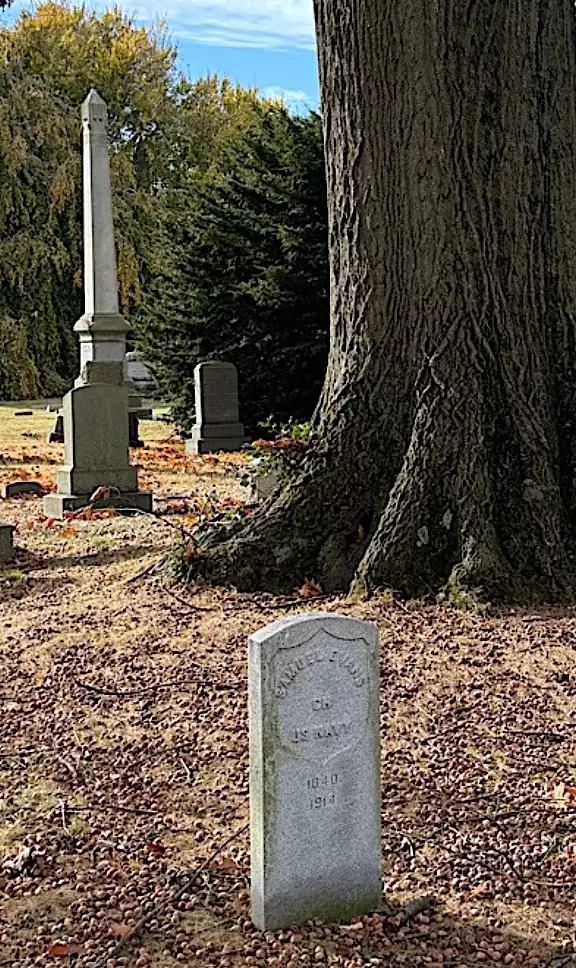
EVERDELL, CHARLES (1827-1920). Second lieutenant, 17th New York Infantry, Company C. A native New Yorker, Everdell enlisted on April 26, 1861, as a second lieutenant, at Morrisania, New York. On May 20, he was commissioned into Company C of the 17th New York and resigned his commission on November 9 of the same year. As per his Draft Registration in 1863, he was an engraver. The New York City Directory for 1868 and the censuses of 1870 and 1880 (at which time he was living in Raritan, New Jersey) all indicate that he was an engraver, a family business. The Veterans Schedule of 1890 confirms his military service. His application for an invalid pension made in 1892 was granted under certificate 299,323. Everdell was still working as an engraver late in his life, as recorded in the censuses of 1900 and 1910. According to a descendant, Charles, Francis (see), Henry (see), and William (see) were brothers. His last residence was in Haslet, New Jersey, where he died of chronic valvular heart disease at the age of 93. Section 167, lot 16917.
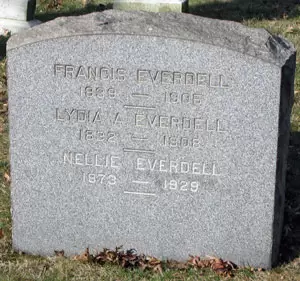
EVERDELL, FRANCIS (or FRANK) (1839-1905). Private, 7th Regiment, New York State Militia, Company D. A native of New York City, Everdell enlisted there as a private in 1861 and served with the 7th Regiment for 30 days. As per the New York City Directory for 1868 and the census of 1870, he was a printer. The census of 1880 shows that he had moved to Summit, New Jersey, where he was employed in the manufacture of fancy goods; the census of 1900 lists him as a property owner. According to a descendant, Charles (see), Henry (see), and William (see) Everdell were his brothers. His last address was 26 Norwood Avenue in Summit, New Jersey. His death was attributed to endocarditis (inflammation of the lining of the artery). Section 167, lot 16842, graves 7 and 8.
EVERDELL, HENRY (1835-1912). Captain, 7th Regiment, New York State Militia, Company D. Born in Manhattan, his family had a long association with the 7th Regiment. According to his obituary in the New York Tribune, his father joined the regiment in 1823, and Henry and three of his brothers (there were 10 sons) were also in the 7th. Henry Everdell joined the 7th in 1856 and at the onset of the Civil War enlisted as a sergeant on April 17, 1861, served with the 7th Regiment for its 30-day activation, and mustered out on June 3 at New York City. A year later, he was commissioned into his company, now part of the New York State National Guard, as a first lieutenant on May 25, 1862, and mustered out three months later on September 5 at New York City. He returned to his company in 1863, was commissioned in June and mustered out on July 20, on which date he was promoted to captain. According to his obituary in the Brooklyn Daily Eagle, when he was drafted in 1863, he had paid a substitute $500 to take his place because family responsibilities required him to remain in the City. Subsequently, when the War ended in 1865, he returned to Company D of the 7th Regiment as a private (because he did not serve after being drafted); he later served as a quartermaster for twenty years.
As per the New York City Directory for 1868, Everdell was a printer. The census of 1870 lists him as a printer; he was listed as a retired printer in 1880 and a printer proprietor in 1900. At first, he was in business with his father, William Everdell & Sons, then formed his own printing and engraving enterprise with his son, Everdell Press, which he maintained until his retirement in 1906. As per his obituaries, he was with the 7th Regiment for 50 years, retiring in 1906 with the rank of lieutenant by brevet and receiving a ceremonial silver officer’s sword for his long-term service. He had also received a diamond service badge after twenty-five years with the regiment. In addition, he was a member of the Lafayette Post #140 of the G.A.R., the New England Society and the Veteran Association of the 7th Regiment. In 1904, his pension application was approved, certificate 1,093,026. According to a descendant, Charles (see), Francis (see), Henry, and William (see) were brothers. Henry Everdell survived his brother William by ten days. At the time of his death he lived at 13 Alice Court in Brooklyn. His widow, Mary Everdell, received a pension in 1912, certificate 753,830. Section 167, lot 16841.
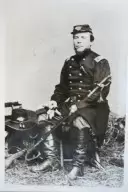
EVERDELL, JR., WILLIAM (1822-1912). Colonel, 23rd Regiment, New York State National Guard. A New York City native who worked in the printing and engraving field, William Everdell introduced color printing and opened a business in Brooklyn that he later merged with his father’s firm at 104 Fulton Street in Manhattan. In 1850, he joined the Brooklyn City Guard (Company G of the 13th Regiment) and became a lieutenant two years later and then captain in 1854. The City Guard became the nucleus of the 23rd Regiment during the Civil War.
His obituary in the Brooklyn Daily Eagle confirms that he was one of the founders of the 23rd Regiment in 1862, a unit familiarly known as “Ours.” He joined the 23rd New York National Guard as colonel on June 18, 1863. He became the first colonel of that regiment, and commanded it during the Civil War when it marched to the front in July 1863, arriving at Gettysburg, Pennsylvania, just after that battle. When the New York City Draft Riots occurred within days thereafter, Everdell and his troops were rushed back to restore order. Again, however, by the time they arrived, the action was over. He mustered out on July 22, 1863, at Brooklyn.
According to the New York City Directory for 1868, Everdell was a printer; the 1870 census also lists him as a printer but by 1880, he had retired. He was president of the Brooklyn Institute from 1870 through 1878. As per his obituary, he was the first president of the 23rd Veterans’ Association when it was formed in 1870. The obituary notes that he retired from his business in 1873 after he was stricken with paralysis; however, he maintained his interest in military affairs, attending social events and mingling with comrades. An article on January 20, 1912, in the Brooklyn Daily Eagle, “’Ours’ Celebrates Fiftieth Anniversary” highlighted the 23rd Regiment’s festive event attended by more than 8,000. Everdell was unable to attend but was honored by all who were present. A gold-framed letter of greeting was hand-delivered that day to Everdell by F. H. Norton, the colonel and commanding officer of the 23rd Regiment, who read the tribute at the gala:
On this, the fiftieth anniversary of the forming of the Twenty-third Regiment, it is my privilege and pleasure, on behalf of its members, to extend most cordial greetings to you, our first colonel.
During the half century which has elapsed since those stirring days, your name has held first place in the profound respect we feel for those honored men whose patriotic action under your leadership gave this organization its inception.
Accept our assurance that we shall always regard as a precious possession the memory of your devotion to duty, and that your example will be to us in the future, as it has been in the past, a constant incentive to better effort.
Permit me to express to you my personal esteem, regard and affection, sentiments which are shared by all of the officers and enlisted men of the regiment.
According to a descendant, Charles (see), Francis (see), Henry (see), and William Everdell were brothers. He last lived at 812 Washington Avenue in Brooklyn. His death was attributed to apoplexy. Section 167, lot 16843.
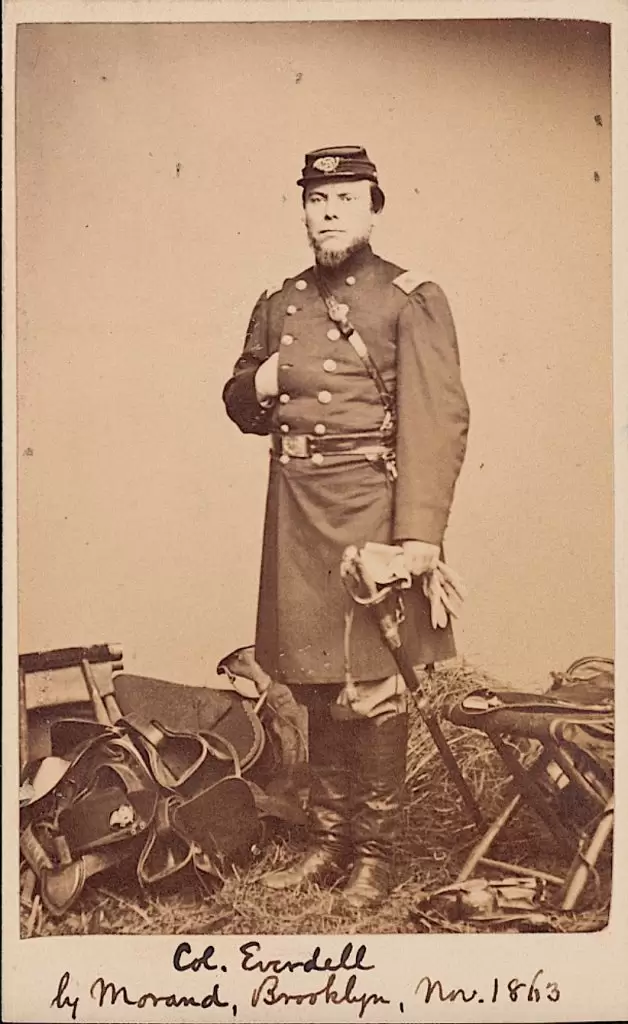
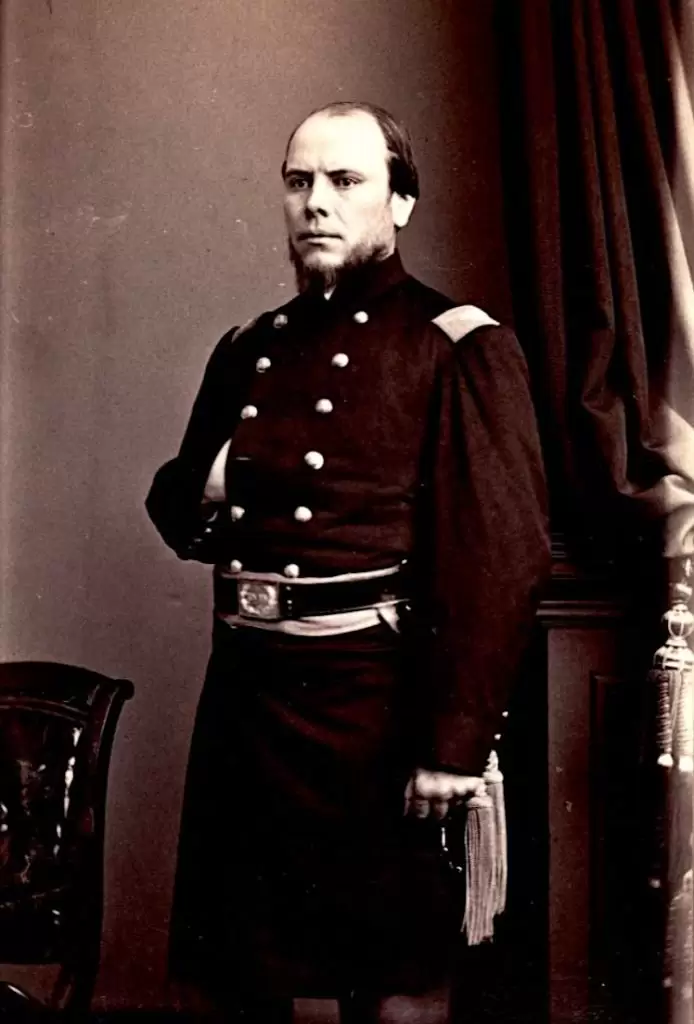


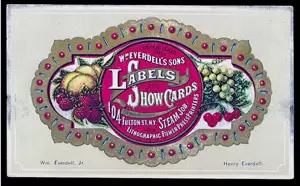

EVERITT (or EVERETT), CORNELIUS L. (1832-1874). Private, 127th New York Infantry, Company C. Born in New York City and a jeweler as per the census of 1850, Everitt enlisted as a private at New York City on August 21, 1862, and mustered into the 127th on September 8. His muster roll shows that he was 5′ 7″ tall with blue eyes, dark hair and a fair complexion. At that time, he was still working as a jeweler. He was discharged for promotion on May 20, 1863, as a second lieutenant in the 47th New York but apparently never served as an officer. The census of 1870, at which time he was living in Plainfield, New Jersey, does not record an occupation. He last lived in Plainfield, New Jersey. Section 75, lot 11519.
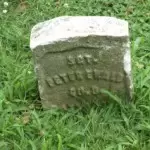
EWALD, PETER (1841-1897). Sergeant, 84th Regiment, New York State National Guard, Company D. Ewald was born in New Jersey. According to his gravestone inscription, Ewald served for 100 days in 1864 as a sergeant in the 84th Regiment, New York National Guard. As per the census of 1870 (in which his personal estate was reported to be $1,000), the census of 1880 and the Brooklyn Directory for 1885, he was a butcher. His last residence was at 442 55th Street in Brooklyn. Ewald died a victim of diabetes. In 1898, Elizabeth Ewald, who is interred with him, applied for and received a widow’s pension, certificate 646,003. Section 166, lot 29868, grave 2.
EWING, ALEXANDER (1840-1864). Corporal, 15th Regiment, New York Engineers, Companies E and A. Ewing was born in Chesterfield, Virginia. On August 16, 1862, Ewing enlisted at New York City as a private and mustered into the 15th New York Engineers on the same date. According to his muster roll, he was a painter by trade who was 5′ 8″ tall with grey eyes, brown hair and a light complexion. He was promoted to corporal on November 1, 1862, and received an intra-regimental transfer to Company A on June 18, 1863. Ewing died of inflammatory rheumatism on May 29, 1864, at the Brigade Hospital at Washington, D.C. Edward Ewing (see) was his brother. His last residence was on North 5th Street in Brooklyn. Section 112, lot 13224.
EWING (or ERVING), DANIEL (1839-1898). Private, 57th New York Infantry, Company D. Born in England, Ewing enlisted at New York City as a private on September 28, 1861, and mustered into the 57th New York that day. He was discharged for disability on October 11, 1862. His muster roll indicates that he was a New Jersey resident who was borne on the rolls as Daniel Erving. Although he applied for an invalid pension on November 17, 1862, application 4,438, there is no evidence that it was certified.
In civilian life, Ewing was a saloon-keeper and then a boarding house proprietor in Jersey City, New Jersey; the census of 1880 lists him as a steward. An article in the Jersey Journal on August 5, 1880, noted that he was sued for “breach of promise” when he failed to marry a woman he seduced with a promise of marriage; he was arrested with bail fixed at $200. As per his obituary in The New York Times, he was, for twenty years, the proprietor of the Ewing Hotel (formerly the Philadelphia Hotel) at 11 and 13 Montgomery Street in Jersey City; he sold the property four months before he died from liver cancer. His last residence was 3115 Montgomery Street in Jersey City. Section 113, lot 17746, grave 6.
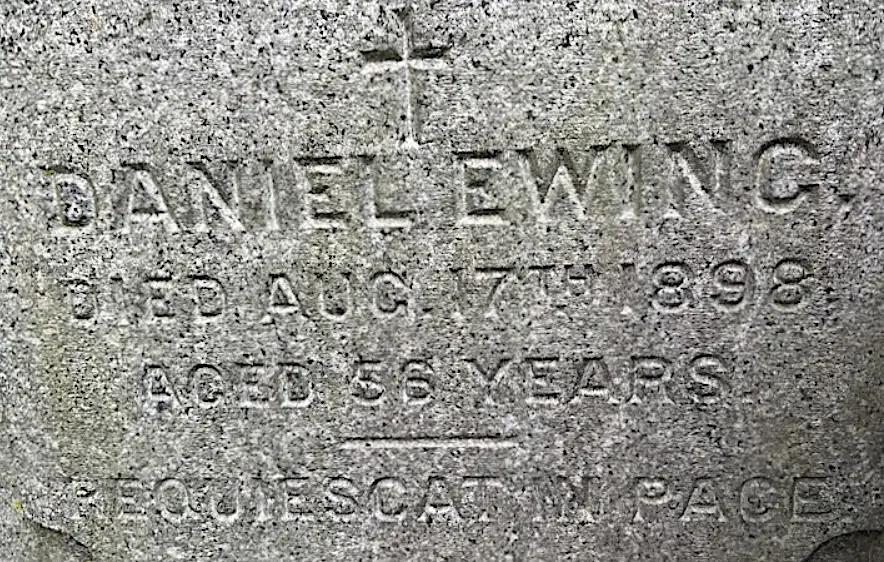
EWING, EDWARD C. (1844-1868). Private, 67th New York Infantry, Company B; 1st Light Artillery, United States Army, Batteries G and L. Born in Cuba, Ewing immigrated to the United States in 1846. During the Civil War, he enlisted as a private at Fort Schuyler, New York, on August 10, 1861, and on August 31 mustered into the 67th New York. After he was discharged on November 8, 1862, he re-enlisted in the United States Army, where he served in the 1st Light Artillery, Batteries G and L.
In civilian life, he was a milkman. Alexander Ewing (see) was his brother. Ewing, whose death was a suicide by hanging, last resided at 213 North 5th Street in Brooklyn. According to articles about his death in the New York Herald (August 25, 1868) and the Brooklyn Daily Eagle (August 24, 1868), he was unhappy in his marriage, was not prospering in his business, and had spoken about ending his life. In 1891, Elizabeth Ewing applied for a widow’s pension, application 283,848, but it was not certified. Section 112, lot 13225.
EYRE, CHARLES (1832-1879). Private, 84th New York (14th Brooklyn) Infantry, Company C. A native of New York City, Eyre enlisted at Brooklyn as a private on April 18, 1861, mustered into the 14th Brooklyn on May 23, and was discharged for disability on August 7, 1862, at Washington, D.C. In civilian life, he was a painter by trade and listed as such in the Brooklyn Directory for 1864 and on the Mortality Schedule for 1880. He last lived in New York City. His death was caused by Bright’s disease. Section 67, lot 2743.
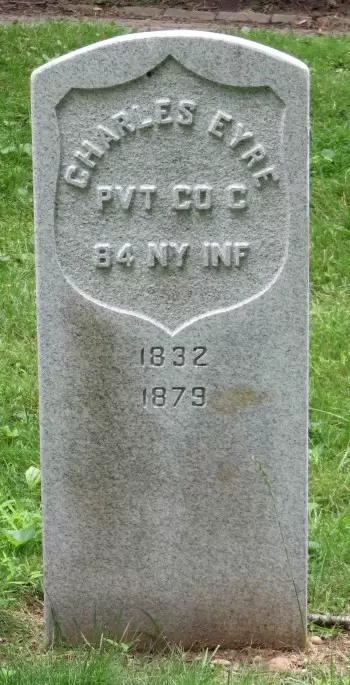
EYTINGE, HARRY (or HENRY) (1822-1902). Captain, United States Navy. Originally from Philadelphia, Pennsylvania, Eytinge, became a performer at age seventeen when he joined a group at the Albany Pearl Street Theater. Concurrently, he was interested in the sea and sailed to Holland, possibly for his father’s mercantile business. Eytinge continued with both trades, owning the brig Ganges and trading with the United States, Europe and the Mediterranean, and appearing in minor plays in London at the Strand Theater in 1847 with the stage name Henry St. Cyr Perry. In 1852, he became a stage manager in Cincinnati, then entered into a joint venture with the Metropolitan Theatre and New York Opera House in 1854.
During the Civil War, Eytinge volunteered to be an officer in the United States Navy and was accepted in spite of a letter questioning his ability to command a vessel. He was given command of the USS Shepherd Knapp and sent to the West Indies. The Shepherd Knapp, a sailing ship, was able to remain at sea for several months, but on his first voyage, Eytinge, despite orders to the contrary, docked in St. Thomas to load 200 tons of additional ballast. On September 4, 1862, he captured the British blockade runner Fanny Laurie, which was taken as a prize. On May 18, 1863, the Shepherd Knapp ran aground at Cape Haitian, and the guns and other materiel aboard that could be saved were salvaged. Eytinge was then given command of the USS Chillicothe and sent to Ellis Cliffs to relieve the USS Manitou. However, the Chillicothe grounded twice en route and Eytinge was relieved of his command with his appointment revoked in December 1863. His total prize money for his service was a modest $525.
Eytinge returned to the theater, managing, producing and acting. His work took him to California and to Ohio where he ran an acting school in the 1870s. His life, once more, had controversy. When he married a woman, Ida Seebohm, another woman he lived with in New York claimed to be his wife under state law. Eytinge and Seebohm had a son, Louis Victor Eytinge, who, after a murder conviction, wrote about character development and advertising. His writings became famous, and Louis, a newly wealthy man, was eventually released on parole. Harry Eytinge, also an accomplished painter, died in Nyack, New York. Section 43, lot 3689.
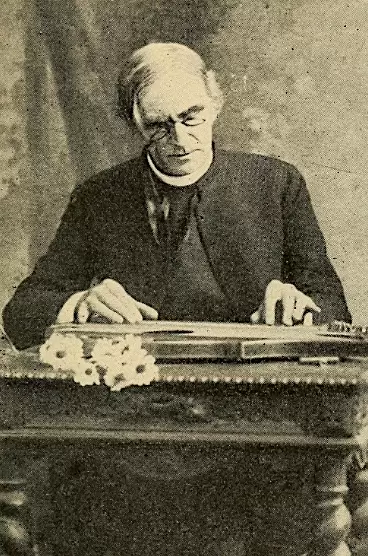
FAIRCLOTH, FRANCIS (or FRANK) MARION (1830-1900). Captain, United States Navy. The year of Faircloth’s birth is uncertain; his obituary states 1820, but what appears to be his passport application states 1833, while data from Green-Wood shows 1830. As per his obituary in The New York Times, which confirms his Civil War service and indicates a birth year of 1820, Faircloth was born in Newark, New Jersey, became a sailor as a young man, and first served in the Mexican War. During the Civil War, he commanded the Boston which he burned to prevent her from falling into the hands of the Confederates.
An article in The New York Times on February 22, 1888, reports that Faircloth was the chief witness in a case involving his command of the steamship Cienfuegos of the Ward Steamship Line. Apparently, on October 15, 1887, the ship arrived in Havana and when Spanish authorities boarded the ship, they found eight cases containing 1,300 pounds of opium in the steward’s room. Upon investigation, it was determined that the drugs were smuggled onto the vessel at the pier in New York City. After the ship was bonded by Spanish authorities, the Ward Steamship Line discharged the captain, steward, waiters, deck officers and the head clerk. As per the news article, Faircloth declared that the opium must have been placed on the ship by persons associated with McKesson & Robbins, druggists on Fulton Street in Manhattan, who had just been associated with the seizure of opium in Western New York. Faircloth was certain that the druggists colluded with officers on board the Cienfuegos. The opium in question had been imported from Liverpool on February 19, 1887, and had been taken from the public stores by the druggists on October 13, 1887, where it had been held in bond. The ship’s manifest listed eight cases of drugs but no markings were founded on the seized opium. It was unclear if the opium was meant to be smuggled into Cuba or reshipped to the United States to evade duty. As of the date of the news article, the opium was still in Havana, unclaimed.
As per his passport application of 1895, in the name of Francis M. Faircloth, a resident of New Jersey, he gives a birth year of 1833. According to that application, he was a seaman who was 5′ 10″ tall with grey eyes, grey hair, a full beard, florid complexion, small mouth, oval face and medium forehead and nose. Faircloth last served in the Spanish-American War when he commanded the transport Seguranca. He last served as port captain in Santiago, Chile, but returned to his home suffering from malarial fever which ultimately caused his death. He last lived at 110 Clinton Avenue in Jersey City, New Jersey. Section 162, lot 15491, grave 2.
FAIRHURST, ELLIS H. (1844-1913). Private, 47th Regiment, New York State National Guard, Company D. A native New Yorker, Fairhurst enlisted at Williamsburg, New York, and mustered into the 47th New York on May 27, 1862. On September 1, 1862, he mustered out at Brooklyn. In civilian life, he was a machinist who was listed in the Brooklyn Directions for 1870 and 1880. As per his obituary in the Daily Union Standard, which confirmed his Civil War service, he was a member of McPherson-Doane Post #499 of G.A.R. in Brooklyn; he joined it in 1894. An article in the Daily Union Standard on January 23, 1899, notes that Fairhurst was installed as the junior vice-commander of his G.A.R. Post at a festive induction ceremony. In addition, he was a Freemason. The notation next to Fairhurst’s name on the Veterans Census of 1890 indicates that he “refused to show his papers.” The censuses of 1900 and 1910 show that he was still employed as a machinist. In 1900, his application for an invalid pension was approved, certificate 1,013,660. A Brooklyn resident for forty years, he last lived at 972 Bergen Street in Brooklyn. His death was caused by arteriosclerosis. Section 129, lot 27373, grave 154.
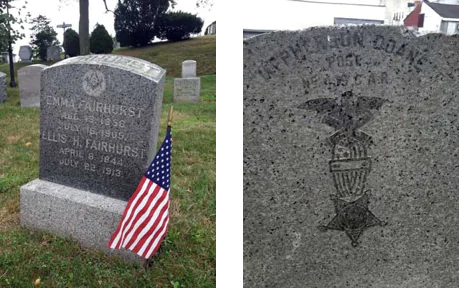
FAIRLOUGH (or FAIRCLOUGH), JAMES (1845-1887). Private, 173rd New York Infantry, Company D. Fairlough enlisted at Brooklyn on September 5, 1862, and mustered into the 173rd on October 30. As per his muster roll, he was a butcher who was 5′ 7″ tall with grey eyes, light hair and a light complexion. On December 19, he deserted from a ship in New York Harbor. He last lived on Downing Street in Brooklyn. He died of pneumonia. Section B, lot 8575, grave 767.
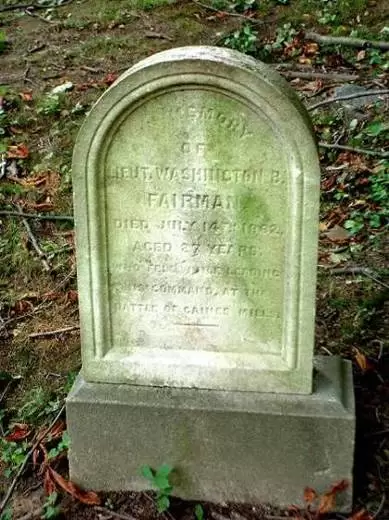
FAIRMAN, WASHINGTON B. (1835-1862). First lieutenant, 25th New York Infantry, Company H; corporal, 44th New York Infantry, Company C. On March 9, 1856, Fairman, a native of Boonville, New York, obtained a Seaman’s Certificate of Protection in New Orleans, Louisiana. That document, which was issued to sailors as a form of identification, included a physical description of the applicant: he was 5′ 11″ tall with blue eyes, brown hair and a light complexion. During the Civil War, he enlisted on September 3, 1861, at Albany, New York, as a corporal, and on October 5 mustered into the 44th. As per his muster roll, he was a sailor by trade. On November 22, 1861, he was transferred into the 25th New York, and was promoted to first lieutenant on that date. On June 27, 1862, he was wounded in battle at Gaines’ Mill, Virginia.
As per a news item in The New York Times on August 1, 1862, Fairman died at the Watt House Hospital on the banks of the Chickahominy River on July 14. The hospital was on the grounds of the former Watt Farm, whose elderly owner, Sarah Watt, fled when the Battle of Gaines’ Mill erupted there. The house, bloodstained and scarred with shell shots and shattered glass, became a hospital site where victorious Confederates housed about 400 injured Northerners. A visitor remarked, “Once a neat and comfortable home now… a foul and battered wreck.” The Watt House survives at the Gaines’ Mill section of the Richmond National Battlefield Park. He was interred at Green-Wood on June 22, 1865. Section 68, lot 5824, grave J.
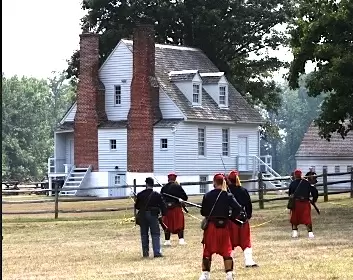
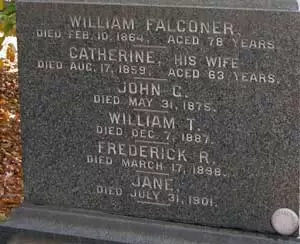
FALCONER, FREDERICK RUSSELL (1828-1898). Sergeant, 71st Regiment, New York State Militia, Company A. Falconer first joined the Light Guard Regiment, later known as the Old Guard, in 1850. The regiment later became Company A of the 71st. In 1861, he was in the 71st New York State Militia for three months, entering as corporal and leaving with the rank of sergeant, and fought at Bull Run, Virginia.
In civilian life, he was a wine and spirits broker whose office was at 35 Liberty Street in Manhattan. He last resided at 128 West 29th Street in Manhattan. Nephritis was the cause of his death. Section 179, lot 11881, grave 6.
FALCONER, JOHN A. (1815-1872). Captain, 79th New York Infantry, Companies D and A. Of Scottish birth, he enlisted at New York City and mustered into the 79th on May 15, 1861, with the rank of second lieutenant. He rose through the ranks to first lieutenant, became a captain on August 1, 1861, was transferred to Company A on October 9, 1861, and was discharged for disability on March 1, 1862. He last resided on West St. Paul’s Avenue in Jersey City, New Jersey. The cause of his death was dropsy (edema). Section 186, lot 18818.
FALK, JACOB H. (1842-1884). Private, 69th New York Infantry, Company C. Of Swedish birth, Falk enlisted as a private at New York City on July 27, 1861, and mustered into the 69th New York on August 6. He was discharged at Nashville, Tennessee, on an unspecified date. A drowning victim, his last residence was 81 Amity Street in Brooklyn. Section 13, lot 19694, grave 201.
FALKNER, LOUIS (or LUDWIG) (1825-1893). Private, 41st New York Infantry, Companies I and C. Born in Germany and a tailor by trade, Falkner enlisted at New York City on June 6, 1861, mustered immediately into Company I of the 41st New York, and transferred into Company C on September 1, 1861. He mustered out of service on June 9, 1864, at Hilton Head, South Carolina.
As per the census of 1870 and the New York City Directory for 1882, he was employed as a tailor. In 1889, his application for an invalid pension was granted, certificate 878,675. His last residence was on Essex Street in Manhattan. He succumbed to rheumatism. Mary Falkner received a widow’s pension after his death in 1893, certificate 404,092. Section A, lot 8998, grave 493.
FALLESEN (or FALLESSEN, FALLENSEN), FALLE (or FALLER, FRANK) N. (1838-1886). Private, 8th New York Infantry, Company K. Fallesen was born in Denmark (although some records say Germany). After enlisting as a private at New York City on April 23, 1861, he soon mustered into the 8th New York. According to his muster roll, he was wounded and captured at the Battle of Cross Keys, Virginia, on June 8, 1862, paroled at Aikens Landing, Virginia, on September 21, and was sick and hospitalized until he returned to his regiment in January 1863. He mustered out with his company on April 23, 1863, at Brooks’ Station, Virginia.
As per the census of 1870, in which his given name is listed as “Frank,” Fallesen was employed as a tavern keeper. The Brooklyn Directories for 1874 and 1881 and the census of 1880 record that he was in the retail liquor business. In 1879, his application for an invalid pension was approved under certificate 358,879. He last lived at 704 Fifth Avenue South in Brooklyn. Bright’s disease claimed his life. Catherine Fallesen applied for a widow’s pension in 1886, application 347,637, but there is no certificate number. Section 5, lot 30483 grave N2.
FALLS, DeWITT CLINTON (1829-1892). Private, 7th Regiment, New York State Militia, Company F. Born in New York, he was a clerk as per the census of 1850. Falls served with the 7th Regiment for 30 days in 1861. The censuses of 1870 and 1880 list him as a stock broker. He was a member of Lafayette Post #140 of the G.A.R. and the Veterans’ Association of the 7th Regiment. According to his obituary in The New York Times, he was associated with the Broad Street firm of Falls & Tilliston and had an association with the Corn Exchange Bank. He last resided at the Park Avenue Hotel in Manhattan. Falls died of arteriosclerosis.
His son, DeWitt Clinton Falls Jr., who is interred with him, was a brigadier general in the 7th Regiment and a renowned expert on military history, uniforms and insignia. He served in the Spanish-American War and World War I and was a military observer in Belgium in 1914 writing, photographing and illustrating the mobilization and equipment there in the early days of World War I. Section 45, lot 5518.
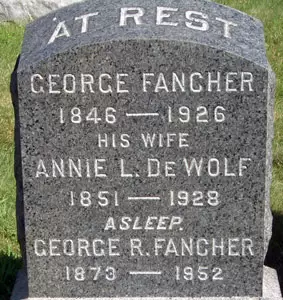
FANCHER, GEORGE (1846-1926). Private, 51st New York Infantry, Company B. Born in New Canaan, Connecticut, he enlisted at Brooklyn on March 7, 1865, mustered into the 51st New York that day, and mustered out on July 7 of that year at Alexandria, Virginia. He was a member of General McQuade Post #557 of the G.A.R. In 1909, he applied for and received an invalid pension, certificate 1,155,546. He last lived at 297 Kosciusko Street in Brooklyn. He died of a cardiac condition. Annie L. Fancher, who is interred with him, applied for and received a widow’s pension in 1926, certificate a5-3-27. Section 199, lot 28453.
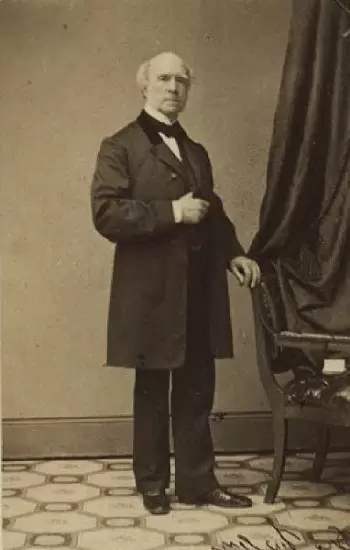
FARLEY, FREDERICK AUGUSTUS (1800-1892). Corresponding secretary, Brooklyn and Long Island Sanitary Fair. Born in Boston, Massachusetts, into a wealthy family, Farley entered Harvard College at the age of fourteen and graduated in the class of 1818. After practicing law for a few years, he entered divinity school at Harvard and graduated with high honors in 1828. He was ordained in Providence, Rhode Island, and then relocated to Brooklyn in 1841 where he became pastor of the Church of the Saviour, a Unitarian congregation on Pierrepont Street. Farley headed the church until 1863. According to his obituary in The New York Times, his salary of $2,000 a year made him one of the highest paid ministers in the New York City and Brooklyn.
Farley was the corresponding secretary for the Executive Committee of the Brooklyn and Long Island Sanitary Fair that was headed by Abiel Low (see). The Sanitary Fair, under the auspices of the United States Sanitary Commission, was held in February and March of 1864. The event brought together women’s groups from the churches in Brooklyn to raise money for Union soldiers who needed supplies and better hygienic conditions in the camps and at hospitals. Transcripts from the Sanitary Fair note that on March 7, 1864, Reverend Farley wrote President Abraham Lincoln that a silk bedspread that incorporated a theme of the stars and stripes and the American eagle was being presented to him; the gift was acknowledged by Lincoln on April 1. At the time of his death due to pneumonia, he was the eldest living member of his class from Harvard and lived at 130 Pacific Street in Brooklyn. Section 71, lot 837.
FARLEY, GEORGE W. (1843-1869). Second lieutenant, 47th New York Infantry, Company I. A native of Flatbush and a painter by trade, Farley enlisted at East New York as a private on September 2, 1861, and mustered into the 47th New York 12 days later. As per his muster roll, he was 5′ 7″ tall with blue eyes, fair hair and a fair complexion. He was promoted to corporal on January 23, 1864, was reduced to ranks at some point, and promoted to second lieutenant on February 13, 1864, but did not muster in at that rank. On September 29, 1864, he deserted at Deep Bottom Run, Virginia. He last lived at 141 Willoughby Street in Brooklyn. According to the U.S. Mortality Schedule for 1870, he died from convulsions. Section 34, lot 5432.
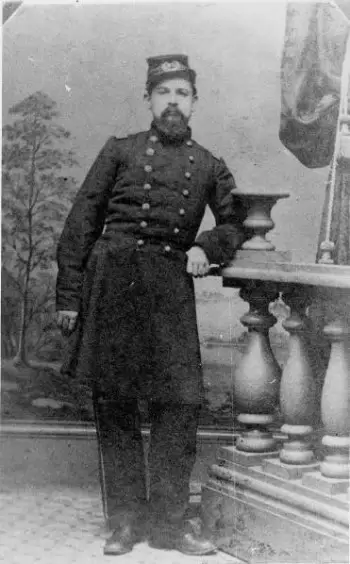
FARLEY, JAMES L. (1835-1886). Lieutenant colonel by brevet; surgeon, 84th New York (14th Brooklyn) Infantry, Field and Staff. A Brooklyn-born physician, he was a graduate of the College of Physicians and Surgeons. During the Civil War, Farley enlisted at Brooklyn as an assistant surgeon on April 18, 1861, and was commissioned into the 14th Brooklyn on May 23. Promoted to surgeon on January 24, 1862, he was hospitalized from September 13 through October 25, 1862, from the USS Bienville with gonorrhea and babo (an illness treated with an ointment); as per his hospital report, the illness was not related to his service. Farley was brevetted to lieutenant colonel on about July 1, 1863, and was medical director of the center at Gettysburg, Pennsylvania, where he tended the wounded for seven days and nights. At Gettysburg, he met up with Confederate General Early whose leg he had amputated at Gaines’ Mills, Virginia. Farley asked Early where he was going to which Early replied, “I’m going to Philadelphia to get a new leg.”
Remaining active in veteran activities as a member and officer of the G.A.R.’s Rankin Post #10 in Brooklyn, Farley served as the national adjutant-general for 1878. In addition, he continued as surgeon for the 14th Brooklyn as of September 5, 1864, when he attained the rank of major. According to the census of 1880, he was living in Brooklyn and was a physician; however, his obituary in The New York Times, which confirmed his Civil War service, reports that he gave up his medical practice in 1872 and had a desk at the Custom House as of 1881 which gave him time to engage in his practice of elocution.
He last lived at 505 Willoughby Avenue in Brooklyn but spent the last five weeks of his life at the Flatbush Insane Asylum. As per an article on his institutionalization, he was suffering from headaches and was self-administering hypodermic injections of cocaine. His friends attributed his “nervous condition” to his devotion to literary readings and focus on elocution. Cemetery records indicate atrophy of the liver as the cause of death. A tribute to Farley by the 14th published after his death in the Evening Telegram notes that he enjoyed rifle shooting and won many prizes for that skill. Cecilia Farley, who is interred with him, applied for and received a widow’s pension in 1895, certificate 654,031. Section 65, lot 25339.
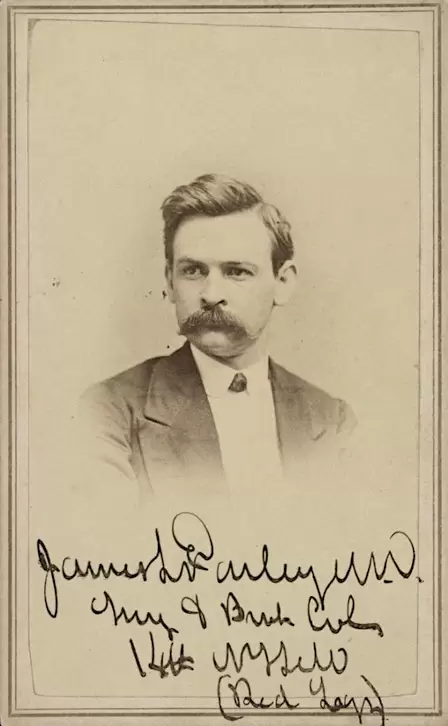
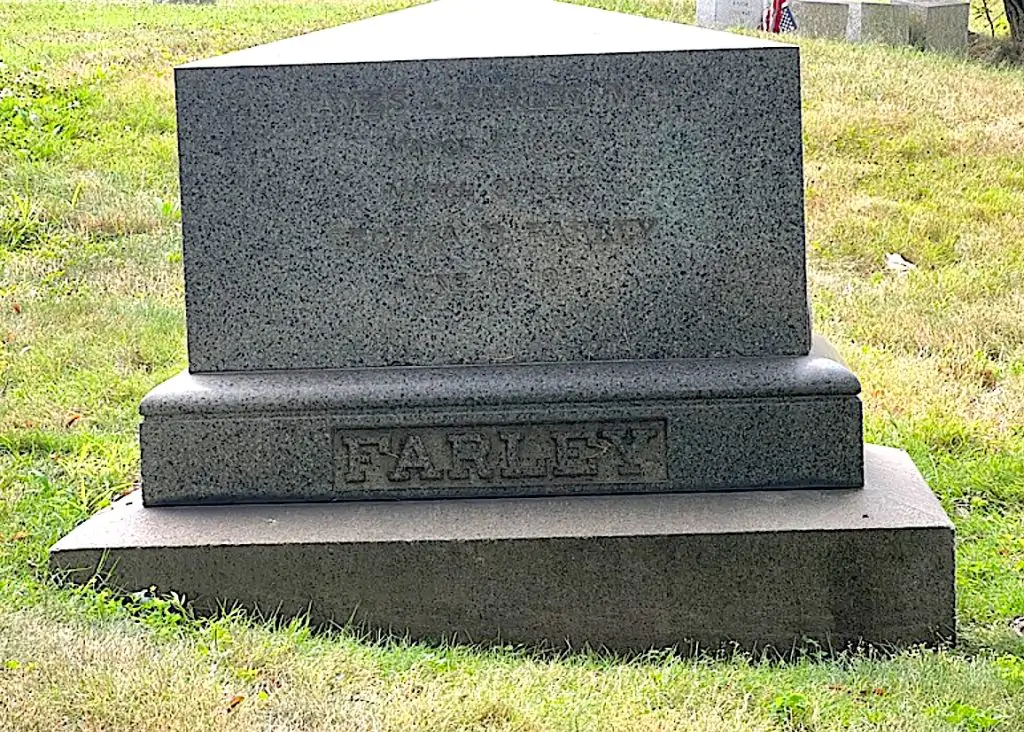
FARLOW, JOHN (1841-1898). Private, 11th New York Infantry, Company D. Born in Ireland, Farlow immigrated to the United States in 1851. He enlisted at New York City as a private on April 20, 1861, and mustered into the 11th New York on May 7, 1861. Injured at First Bull Run, Virginia, he was taken as a prisoner of war. An article in The New York Times on September 25, 1861, listed him among the Union soldiers imprisoned at Richmond, Virginia, and reported that he was at St. Mark’s Hospital there with injuries to the head and left side. His soldier history notes that he was confined at Richmond as of October 14, 1861, and exchanged on an unknown date. However, the history of the 11th Regiment indicates that soldiers imprisoned at Richmond were transferred to Castle Pinckney in South Carolina in September 1861 and remained there until May 1862; it is unclear whether Farlow was ever transferred to Castle Pinckney. Farlow was discharged for a disability on March 6, 1862, at Newport News, Virginia.
On March 11, 1862, he applied for and was granted an invalid pension under certificate 9,781. According to the censuses of 1870 and 1880, he was a fireman. The Veterans Schedule of 1890 confirms his military service and discharge by a doctor’s certificate. After retiring as a New York City fireman, he last resided in Centerport, New York. Shortly after his death due to stomach cancer, Emily Farlow applied for and was granted a widow’s pension, certificate 496,389. Section 85, lot 17700, grave 51.
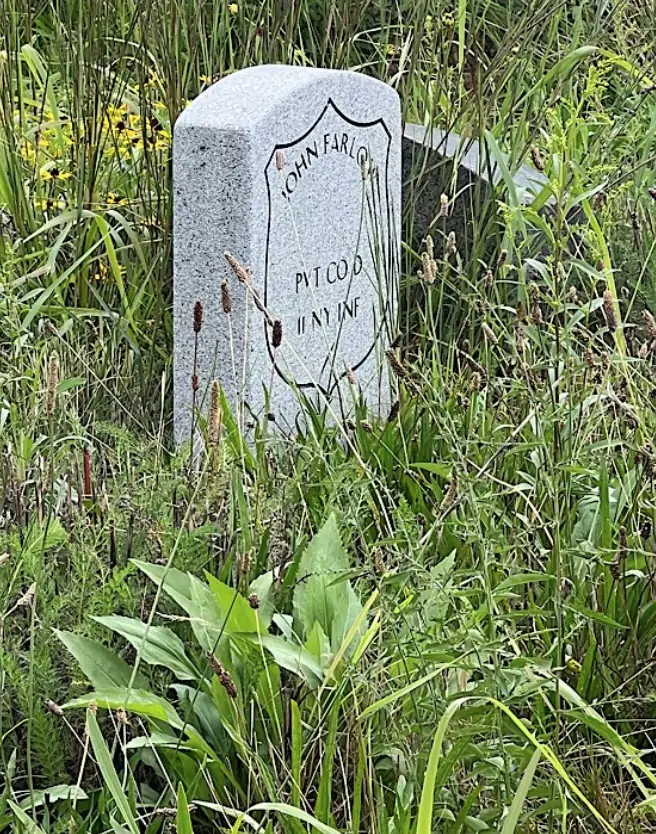
FARMER, GEORGE EDGAR (1840-1870). Lieutenant colonel by brevet; major, 6th New York Cavalry, Companies C and G; 2nd New York Provisional Cavalry. A New York City native, he was in the mercantile business before he left for military service. Farmer enlisted as a second lieutenant on March 30, 1862, at York, Pennsylvania, and was commissioned into Company C of the 6th New York Cavalry that day. His muster roll indicates an enlistment date of September 10, 1861, and a date of muster in on November 12; however, that same document notes that there was no evidence of Farmer’s appearance on the muster roll until March 1862. He was promoted to captain on December 29, 1862, and was transferred to Company G on January 16, 1863. As per his obituary in the New York Herald, he participated in all the battles in General Pope’s campaign including Antietam, Maryland, Fredericksburg and Chancellorsville in Virginia, and Gettysburg, Pennsylvania. He was slightly wounded at the Battle of Trevillian Square, Virginia (June 11-12, 1864), and severely wounded at the Battle of Deep Bottom, Virginia (July 27-29).
Farmer rejoined the regiment in the fall of 1864 when he participated in General Sheridan’s campaign in the Shenandoah Valley. He commanded the 6th Cavalry at the Battle of Cedar Creek, Virginia, on October 19, 1864. Subsequently, he rose to major on January 11, 1865, transferred into the Field and Staff the next month on February 28, then transferred into the Field and Staff of the 2nd New York Provisional Cavalry on June 17, 1865, and mustered out on August 9, 1865, at Louisville, Kentucky. On October 20, 1865, he was brevetted to lieutenant colonel, “for faithful and meritorious service in the late War.”
After the War, Farmer held a “responsible position” at the Bowery Savings Bank, an institution of which his father was a founder. His obituary states that was commander of Phil Kearney Post #8 of the G.A.R.; members met at the Cooper Union to arrange for his funeral. He was also a Freemason. Farmer last lived at 138 East 26th Street in Manhattan. His death was caused by peritonitis. Section 71, lot 5837.
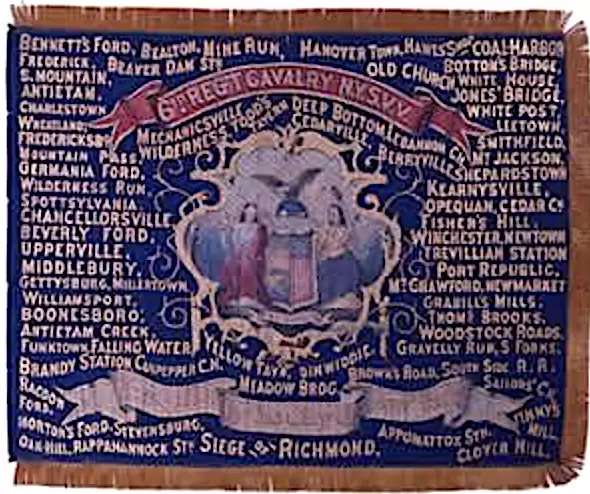
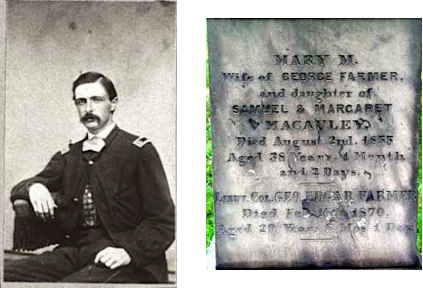
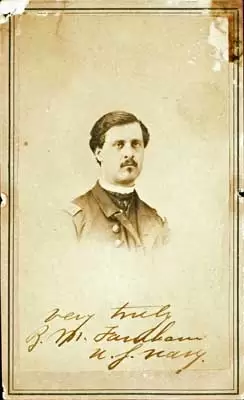
FARNHAM, BELA M. (1843-1899). Assistant quartermaster, 8th Regiment, New York State Militia; acting assistant paymaster, United States Navy. A native of New York City, Farnham first served as a quartermaster in the 8th Regiment, also known as the Washington Grays, when they were called for service in May 1862. As per an article in The New York Times on May 30, 1862, which listed Bela Farnum as the assistant quartermaster, the 8th Regiment was presented with a stand of colors before they departed for Washington, D.C., the previous day. The article reported that the 8th formed their line of march at 4 p.m. on Lafayette Place and then marched to Tiffany’s where there was a ceremony and collation. These words were included in the presentation of the nation’s colors, “…Forget not the example of the patriots of the Revolution, when in the midst of the battle your eyes rest upon the gorgeous ensigns of the State, and of the Republic, which I now, in behalf of some of our most distinguished citizens present to you. Guard them as the emblems of your country, preserve them as the symbols of your own honor, bear them gloriously upon the held, wreathe them with victory, and when you bring them back with you, your fellow-citizens will preserve them as the sacred tokens of your patriotism, and will emblazon upon their silken folds, in letters of gold, the word ‘Washington,’ which shall signify that you have emulated the virtues of the hero and patriot of the Revolution, and have saved from the hands of a ruthless enemy the Capital of the Republic….” There are no further details about that enlistment. Subsequently, he enlisted at New York City as an acting assistant paymaster and joined the United States Navy on September 23, 1864. He was discharged from his duties on June 7, 1865.
Farnum’s name was mentioned in an unusual article in Harrisburg, Pennsylvania’s Patriot on December 23, 1879. According to that article, a cemetery plot at Green-Wood was used as collateral and then sold to Farnum who in turn sold it to another party. The original owner had buried two of his children in that lot, did not want them disinterred, and argued that once the lot is used it cannot be taken away without the owner’s knowledge or permission; the decision was reversed in the original owner’s favor. The Veterans Schedule of 1890 confirms his Navy service. In 1890, he received a pension from the United States Navy, certificate 18,323. He also was brevetted lieutenant colonel and colonel of New York Volunteers but there are no details for these honors.
As per his obituary the Evening Journal, a Jersey City newspaper, he first belonged to Charles Olden Post #44 of the G.A.R., then joined Van Houten Post #3 after his first group disbanded; members of Van Houten Post were invited to his funeral. The obituary confirmed his Naval service and adds that he was paymaster on General Farragut’s flagship. His last residence was 282 Lenox Street in Manhattan. The cause of his death was cirrhosis. Section 104, lot 8356, grave 7.
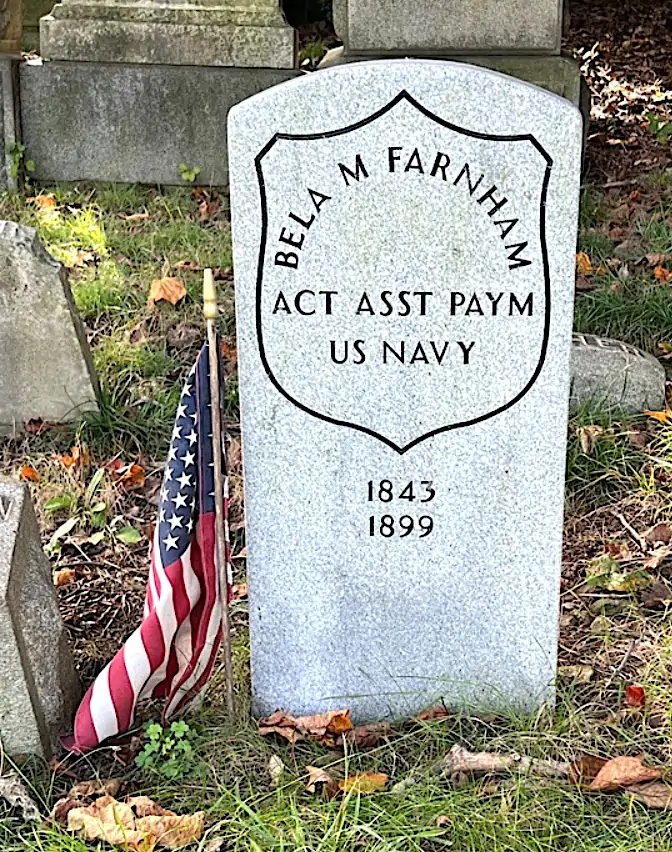
FARNUM, FREDERICK S. (1843-1895). Private, 153rd Illinois Infantry, Company I; 134th Illinois Infantry, Company I. Frederick was born in Providence, Rhode Island, to Charles Augustus and Amanda Experience Farnum. According to the 1860 federal census, 16-year-old Frederick was living in Lake Geneva, Wisconsin, with his father, Charles, and stepmother, Harriet, and working as a clerk.
At the age of 21 or 22, on May 14, 1864, as a resident of Rockford, Illinois, he enlisted as a private in Company I, Illinois 134th Infantry, and mustered in at the end of that month. Discharged from the 134th on October 25 of that year at Chicago, he re-enlisted, as a resident of Palentine, Illinois, on February 20, 1865, in the 153rd Illinois Infantry, Company G, and mustered out of service on September 21, 1865.
By the time of the 1880 federal census, 34-year-old Frederick was living on West 24th Street in Manhattan with his wife, Elizabeth, and, perhaps, two of her younger brothers. His occupation was listed as a press reporter. By 1884, Frederick had become a publisher, according to the New York City Directory.
Frederick apparently moved back to Providence, his birthplace, for a time: the 1890-92 Providence City Directory shows him there until 1891, then notes, “removed to New York City.”
A year earlier, in 1890, Frederick had filed for veterans’ disability benefits; he was probably already suffering the effects of tuberculosis (called phthisis in the 19th century) that, according to his burial record, ended his life a few years later. According to his pension index card, those benefits were never certified. Frederick last lived at 321 Hart Street in Brooklyn. He died on May 19, 1895, at the age of 51. Just weeks later, his widow, Elizabeth, applied for a federal pension; it was certified as 429,723. Section 176, lot 21133, grave 12.
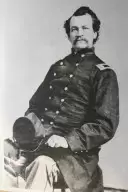
FARNUM, JOHN EGBERT (1824-1870). Brigadier general by brevet; colonel, 70th New York Infantry; 11th Regiment, Veteran Reserve Corps. Born in New Jersey and educated in Pottsville, Pennsylvania, he enlisted in the Army as a member of the 1st Pennsylvania Infantry in 1846, and served through the Mexican War including the landing at Vera Cruz and the surrender of Mexico City. A lover of adventure, he took on the dangerous job of carrying mail from California to Vera Cruz, suffered from cholera while he was in Nicaragua, and then came to New York where he agreed to be a guest aboard a yacht traveling to southern ports. Later, he was indicted in Savannah, Georgia, for carrying on the slave trade as the captain of the Wanderer. He is said to have regretted this action for the rest of his life, and when the Civil War began, he became major of the 70th New York under General Daniel Sickles. Farnum soon distinguished himself in battle and was promoted to colonel. On May 5, 1862, at the Battle of Williamsburg, Virginia, he was severely wounded with wounds to both thighs, but recovered in time to fight bravely at Fredericksburg and Chancellorsville, Virginia, and at Gettysburg, Pennsylvania. For his gallant conduct in those engagements, he was brevetted brigadier general on January 3, 1866. However, his wounds forced him to leave active service, and he served out the War as colonel of the 11th Regiment of the Veteran Reserve Corps.
After the War, Farnum was appointed Inspector of Customs for the City of New York, and continued in that position throughout his life. According to his obituary in the New York Herald-Tribune, which confirmed the details of his military service, a committee of military men arranged his funeral and issued this statement which read in part, “…Resolved, That we have heard with unfeigned sorrow of the death of our companion and friend J. Egbert Farnum, and, while lamenting his death, we have the consolation of knowing that his patriotic services will be remembered by a grateful country, and his personal good qualities cherished by his numerous friends and begrieved comrades….” In addition to attending the funeral wearing the military badges of mourning, the group agreed that a copy of the proceedings of the meeting and the resolutions were to be presented to the family, and members of the National Guard, and ex-officers and comrades from the Mexican War and Civil War would be invited to join in the funeral services. Generals McDowell, Hendrickson, Shaler, Francis B. Spinola (see) and Colonel Beebe attended the service in which Farnum’s rosewood casket, which was inscribed with his rank as brigadier general, was adorned with floral tributes. The pallbearers were Generals Pleasanton, Farnsworth, Graham, William DeLacy (see), McGregor, Francis Pinto (see) and Colonels Burke and James D. Potter (see). The 1st National Guard, also known as Hawkin’s Zouaves, acted as escort. He last resided at 32 Stuyvesant Street in Manhattan. His death was attributed to Bright’s disease. Section 183, lot 20252.
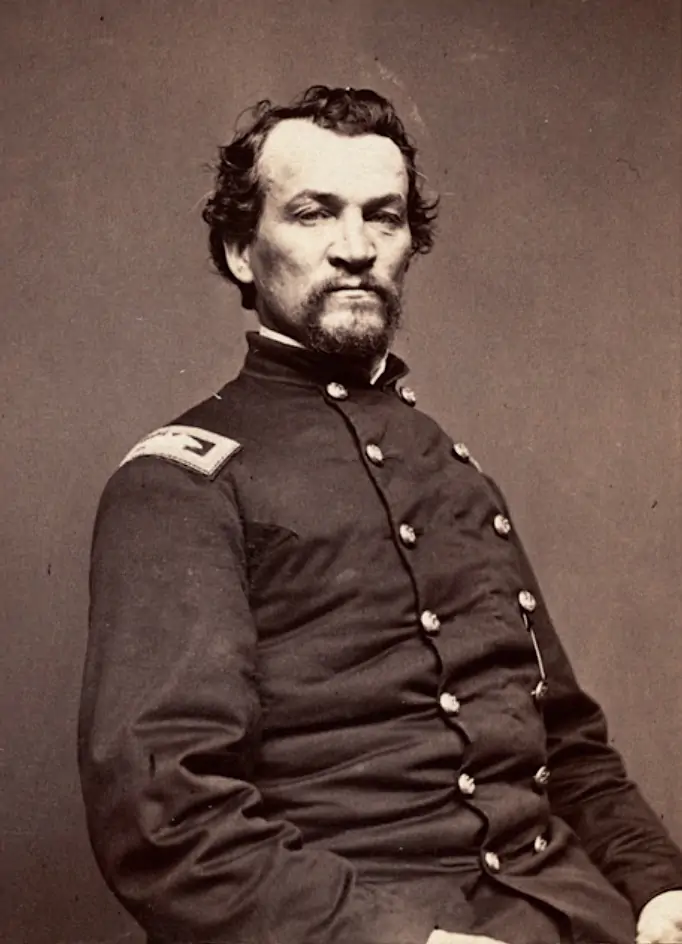
FARON, EDWARD (1824-1889). Machinist, United States Navy. Faron, a New York City native, lived in Orange, New Jersey, from the age of 15. He served in the United States Navy in the Mexican War, taking part in the Battle of Vera Cruz and its capture. A nationally renowned mechanical engineer, he designed ships and used his skills during the Civil War when he supervised the building of the USS Monitor for the United States Navy. He was the master machinist at the Brooklyn Navy Yard, a position previously held by his brother and father. He subsequently designed iron steamers and other vessels for John Roach, a naval contractor whose company in Chester, Pennsylvania, built ships for the Rio Janeiro line. His last residence was in Orange, Essex County, New Jersey. Faron succumbed to neck cancer. Section 102, lot 3242.
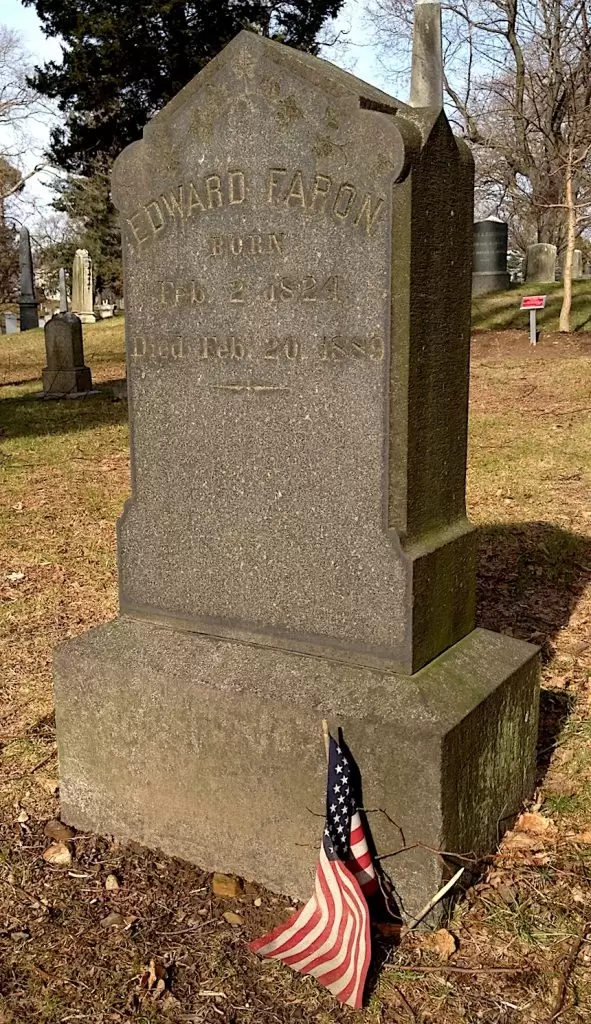
FARRAND, JAMES (1831-1864). Captain, 2nd Michigan Infantry, Companies F, G, and C. Of English birth and a resident of Flint, Michigan, he enlisted there as a first lieutenant on April 23, 1861, and was commissioned into Company F on May 25. According to a biographical entry on “Find A Grave,” he was from a Quaker family and was so opposed to slavery that he was determined to fight to end that institution in his adopted country. He was transferred to Company G on March 6, 1862, and promoted to captain on August 1, 1862, effective upon his transfer to Company C. Wounded at Campbell’s Station, Tennessee, on November 16, 1863, he recovered and returned to action, only to be killed in battle on May 12, 1864, at Spotsylvania Court House, Virginia. Brigadier General J. F. Hartranft, United States Army, wrote of that engagement in his field report of October 25, 1864, “…the Second Michigan, under the command of the gallant Captain James Farrand, repulsed the enemy most handsomely. After all the gunners were killed or wounded, he manned the guns from his regiment, but he was killed soon after while bravely directing the fire of the pieces he had so hastily manned…” Farrand was originally buried at Spotsylvania, then his remains were moved to Fredericksburg, Virginia, by his commanding officer. After his father claimed his remains, Farrand was interred at Green-Wood on November 9, 1865. Section 117, lot 15223.
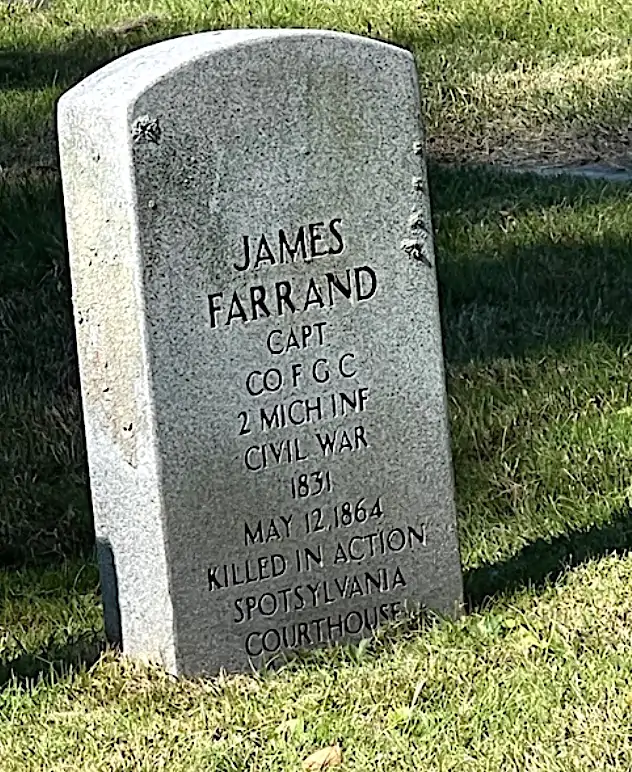
FARRAR, GEORGE CLINTON (1829-1920). Captain, 7th Regiment, New York State Militia, Company K. Born in Temple, New Hampshire, he was 5′ 9″ tall, of dark complexion, with brown hair and eyes, and working as a merchant when he enlisted at New York City on April 17, 1861. The senior captain of the 7th, he was commissioned into his company nine days later, was severely injured when, during howitzer drill at Camp Cameron near Washington, D.C., in May, 1861, he was run over by the artillery squad. He mustered out with the 7th on June 3, 1861, at New York City. On June 29, 1862, he was commissioned into the same unit, then part of the New York State National Guard, served in Baltimore, Maryland, and mustered out on September 5 at New York City. In 1892, he applied for, and was granted an invalid pension, certificate 911,038. He lived in Manhattan until 1898, then moved to Brooklyn. His last residence in Brooklyn was at 980 Decatur Street, where he lived to be 90. He died of nephritis. Section 23, lot 4058.
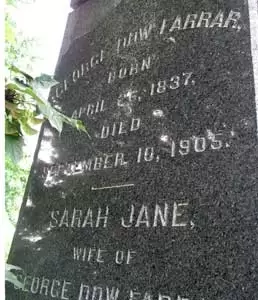
FARRAR, GEORGE DOW (1837-1905). Captain, 145th New York Infantry, Companies D and F. Farrar was born in Wolfboro, New Hampshire. As per his obituary in the Boston Herald, he journeyed West as a young man to improve his health, traveling to St. Joseph, Missouri, and San Francisco, California, and was an associate of Kit Carson, the frontiersman and Indian fighter. During the Civil War, he enlisted as a first lieutenant on August 31, 1862, at New York City. On September 2, 1862, he was commissioned into Company D of the New York 145th Infantry. He received a promotion to captain on April 22, 1863, subsequently transferred to Company F, and mustered out on January 23, 1864.
A manufacturer at the time of his 1891 passport application, Farrar was 6′ tall with gray hair and eyes, an oval face, dark complexion, medium mouth and straight nose. His obituary reports that he was an iron manufacturer and confirms his Civil War service. His last residence was in Great Barrington, Massachusetts. He died of Bright’s disease.
According to an article in the Brooklyn Daily Eagle on September 9, 1906, Mrs. Sarah Farrar, a summer resident of Great Barrington, donated a permanent fund of $100 a year to the Searles High School there for a student who excelled in Latin and for another student who demonstrated academic excellence in another subject to be determined by a school committee; the awards were to be named the George Dow Farrar prizes in honor of her husband. In addition, she founded the George Dow Farrar Home and School for Nurses in New Brighton, Staten Island, in 1907. Her original gift of $25,000 was supplemented by a bequest of $30,000 after her death in 1914 to maintain and support the home. An article in The New York Times on May 21, 1914, notes that Mrs. Farrar left $250,000 to charity and $30,000 in trust for Timothy Connelly, a bellboy at a Great Barrington inn who provided her with prompt and pleasant service. An article in the Springfield (Massachusetts) Union on May 22, 1914, indicates that Mrs. Farrar also paid for Connelly’s 1912 tuition at the Hallock School for Boys in Great Barrington and in the fall of 1913, deeded a local house to him. Connelly went on to graduate from Georgetown University, served in the American Expeditionary Forces in World War II, and was a commander of the South Berkshire American Legion Post. Section 69, lot 3260.
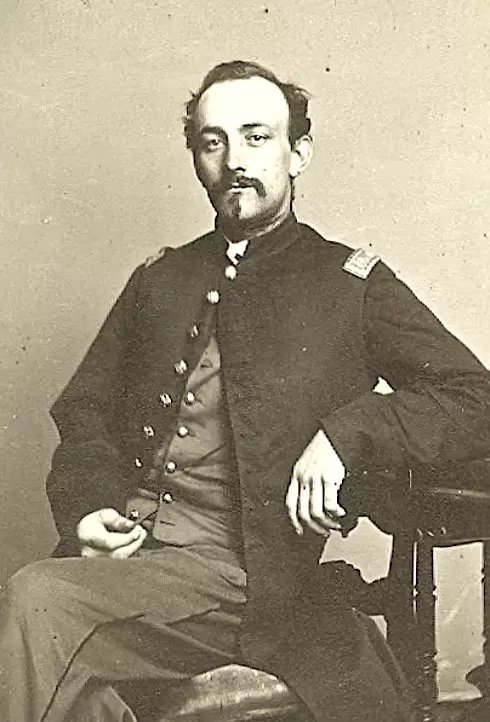
FARRELL, FRANK (1838-1879). Private, 174th New York Infantry, Company B. After Farrell enlisted at New York City as a private on September 30, 1862, he mustered into the 174th New York on October 17, and mustered out on an unknown date. He last lived in New York City. Section 181, lot 15645.
FARRELL, JOHN FRANCIS (1828-1884). Corporal, 5th New York Infantry, Company F. A native of New York City, Farrell was a caulker by trade who was 5′ 6½” with blue eyes, black hair and light coloring. He enlisted at Fort Schuyler, New York, on April 24, 1861, and mustered in on May 9. After being wounded in the right thigh at Second Bull Run, Virginia, on August 30, 1862, he was hospitalized in Alexandria, Virginia. Farrell was promoted to corporal on December 8, 1862, hospitalized at Finley General Hospital in D.C., from March-April 1863, and mustered out with his company at New York City on May 14, 1863. Subsequently, he served in the United States Army from 1867 through 1875 and with the New York Fire Department. He last resided in Brooklyn. His death was attributed to heart disease. Section 207, lot 21496.
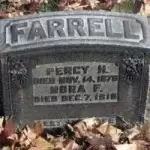
FARRELL, PERCY H. (or P.H.) (1839-1876). Private, 12th Regiment, New York State Militia, Company H. Of Irish origin, Farrell served for three months in the 12th Regiment’s State Militia in 1861. He last lived at 312 East 29th Street in Manhattan. His death was due to a congestion of the lungs. Originally interred at Evergreen Cemetery, he was re-interred at Green-Wood on April 4, 1884. In 1892, Honora Farrell applied for and was granted a widow’s pension, certificate 370,811. Section 183, lot 20727.
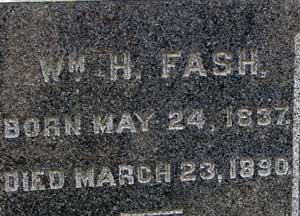
FASH, WILLIAM H. (1837-1890). Private, 15th New York Engineers, Company D. Born in New York State, Fash enlisted as a private at New York City on May 6, 1861, mustered into the 15th Engineers on June 25, and was discharged for disability on September 10, 1861, at Fairfax Court House, Virginia. His application for an invalid pension was granted in 1867, certificate 309,394. As per the 1870 census, he was a butcher living with Mary C. Fash who was “keeping house.” He last lived at 449 West 34th Street in Manhattan. His cause of death was pneumonia. His widow, Annie (Catherine Anne) Fash, received a pension in 1896, certificate 275,469. In 1901, Mary C. Fash, contested and applied for a widow’s pension, application 733,074, but it apparently was not granted. Section 49, lot 7206.
FAULHABER, WILLIAM C. (1829-1872). First sergeant, 4th Regiment, New York State National Guard, Company C. Of German origin, Faulhaber became a naturalized citizen on October 16, 1857. According to the census of 1860, he was a saddler. During the Civil War, he enlisted as a first sergeant and served for 30 days in 1863 with the 4th Regiment’s Heavy Artillery. The 1870 census lists him as a harness-maker. His obituary in the New York Herald states that he belonged to the American Protestant Association, a nativist group alarmed at the spread of Catholicism. He last lived at 528 8th Avenue in Manhattan. He died of phthisis.
Elizabeth Faulhaber applied for a widow’s pension in 1898, application 682,400, but it was never certified on the pension index. However, an article in the Yonkers Statesman on January 20, 1910, reports that the local Congressman Andrus asked the Secretary of the Interior to place Elizabeth Faulhaber on the pension rolls at a rate of $24 a month; it is not clear if that directive ever took effect. His remains were removed from Linden Hill Cemetery and re-interred at Green-Wood on November 5, 1910. Section 146, lot 25760, grave 3.
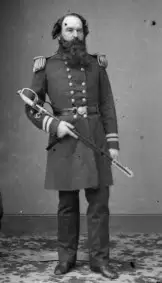
FAUNCE, JOHN (1807-1891). Captain, United States Revenue Marines. Born in Plymouth, Massachusetts, Faunce was the captain of the steam cutter Harriet Lane, a ship named for the niece of James Buchanan, who acted as his First Lady, and was at the helm of that vessel outside Charleston Harbor when she fired the “first Naval shot” of the Civil War against the steamer Nashville. He entered the Revenue Marines, a forerunner of the Coast Guard, as a resident of Baltimore, Maryland, on June 5, 1841, when he was commissioned as a second lieutenant and then rose to first lieutenant on October 28, 1843, and to captain on March 8, 1855. In 1860, while in command of the Harriet Lane, Faunce was asked by the United States government to entertain the Prince of Wales, the future King Edward VII, at West Point. The prince presented Faunce with a gold watch as an expression of gratitude for his hospitality.
First launched in 1857, the Harriet Lane saw action in the Navy during the Civil War (after being transferred from the Revenue Marines on March 30, 1861) at many battles including: Fort Sumter, South Carolina; Hampton Roads, Virginia; New Orleans, Louisiana; and Galveston, Texas. After Fort Sumter, Faunce was captain of the cutter when she was at Newport News, Virginia, and then sent to Hatteras Inlet where it ran aground on August 29, 1861. When Fort Hatteras, North Carolina, surrendered, the flag was lowered aboard the Harriet Lane. Much of her provisions and armament had to be destroyed to lighten her load before she rejoined the squadron at Hampton Roads, Virginia, on September 8. He was later assigned to shore duty and was not the captain of the cutter in 1862 when it was in Key West, Florida, and then in the Gulf. In 1863, the ship was captured by the Confederates in Galveston and after being retaken, was declared unfit for duty.
Faunce brought the Harriet Lane back to New York in 1867. In 1871, at the order of the Treasury Secretary Sumner Kimball, Faunce was sent to inspect all of the Life Saving Stations. He reported that the “apparatus was rusty for want of care and some of it ruined.” As a result, new equipment, standards of performance, station routines, and physical standards set the service on a road toward professionalism. In civilian life, he was a member of the New York Yacht (which he and the Prince of Wales were made members on the same day) and Marine Clubs. According to his obituary in The New York Times, the gold watch that he was gifted by the Prince of Wales was in his pocket on the day he died shortly after setting up a game of lawn croquet with his grandson. He last lived at 67 Atlantic Avenue in Jersey City, New Jersey. His death was attributed to “mitral insufficiency or old age.” Section 162, lot 14466.
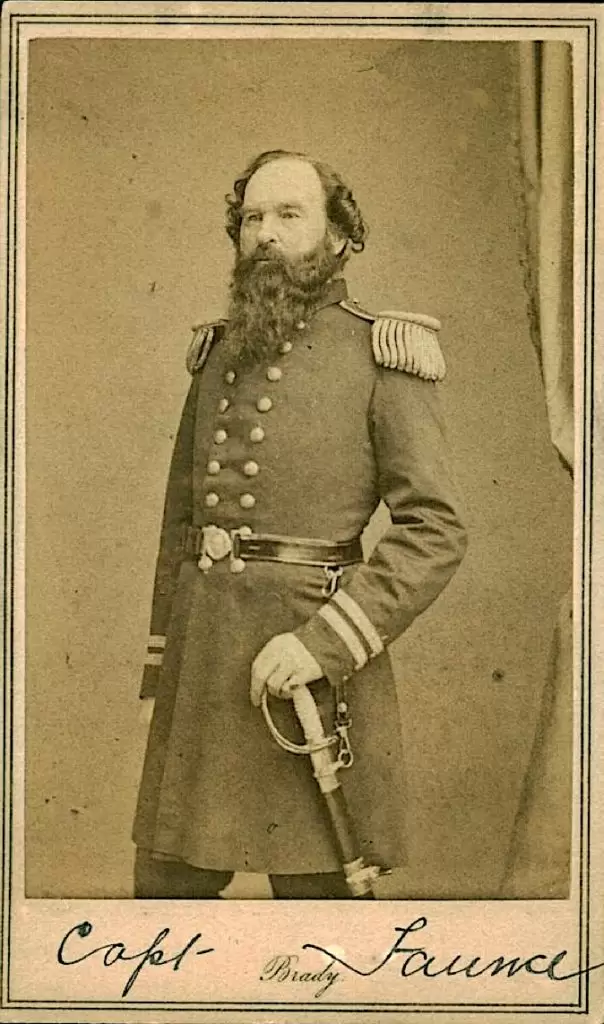
FAVILL (or FAVILLE), JOSIAH MARSHALL (1840-1913). Colonel, lieutenant colonel and major by brevet; captain, 57th New York Infantry, Companies E, H, A, and F; private, 71st Regiment, New York State Militia, Company C. Of English birth, he was a student when the Civil War began. The Diary of a Young Officer: Serving with the Armies of the United States During the War of the Rebellion (1909) gives his account of his experiences. He enlisted as a private in April 1861, mustered into the 71st Regiment and served for three months. In his diary, he described the frenzied preparations for war in Washington, D.C., “Washington has become an immense fortress; the streets are crowded with men in an endless variety of uniforms, and all the public buildings are more or less, turned into temporary barracks.” At First Bull Run, Virginia, that July, he wrote of the Union rout, “By this time the men were throwing away their blankets, knapsacks, and many of them their guns, in order to fly faster; and when the enemy began shelling the woods we were in, the panic was complete, and all semblance of order was lost….Confusion became confounded.” After his discharge on July 25, he was eager to get a commission in one of the new regiments that were being formed.
He re-enlisted at New York City as a second lieutenant on September 21, 1861. On November 12 of that year, he was commissioned into Company E of the 57th New York. (His diary lists the date of his commission as of October 18.) He was carried on the rolls as Josiah M. Faville. He began his rise through the ranks on March 7, 1862, when he was promoted to first lieutenant and adjutant. (According to his diary, the date of the promotion was December 10, 1861.) In April 1862, he reflected, “Many of my notions have been rudely shattered. The old army officer who loomed up so mighty as a man of war, has lost much of his prestige; red tapeism, slowness, jealousy in such monstrous form, that like vice, to be hated, is but to be seen.” Favill wrote of the confusion at the Battle of Fair Oaks, Virginia, on May 31-June 1, 1862:
The colonel, Captain McKay, and I took position in the center of the regiment, close to the men, and sat on horseback, straining our eyes for the first approach of the enemy….suddenly, without any warning, a heavy musketry fire opened all along the enemy’s line. The noise was tremendous; and the bullets whistled about our eyes like hailstones, tearing branches, twigs, and leaves from trees. The horses reared and plunged, and the center and left of the regiment were thrown into some confusion….McClellan seems to be afraid….Nothing prevented a great disaster to the Confederacy on the first but the timidity of McClellan.
By July 1862, the 57th New York had been decimated with 41 percent of the men killed or wounded or lost to malnutrition and exposure. On September 17, 1862, he was ordered to close a gap on the Union line as the enemy was advancing. He wrote, “I walked across the field right on the edge of the cornfield, my ears fairly burning with the singing of the deadly Minnie, I could see nothing, but the tips of the cornstalks were constantly toppling over, cut by the rebel infantry line.” Favill fought at Fredericksburg in December of 1862 and described the advance on Marye’s Heights in his diary:
We marched rapidly forward, passing a huge pile of bricks, which the round shot was scattering in every direction, then came a mill race, and on the other side of it a high board fence: clearing these obstacles in the face of a terrible fire, with considerable loss and obliquing somewhat to the right at first…we marched directly forward, in front of Marye’s house….When within some three hundred yards of the rebel works, the men burst into a cheer and charged for the heights. Immediately the hill in front was hid from view by a continuous sheet of flame from base to summit….The losses were so tremendous that before we knew it our momentum was gone, and the charge a failure.
Favill then had the task of withdrawing the 57th from Fredericksburg. On December 20, 1862, Colonel Samuel K. Zook (see) wrote from Falmouth, Virginia, about the field operations of December 11-16 citing Favill, his aide-de-camp, for guiding a battle line comprised of the 2nd Delaware and the 52nd New York alongside the railroad that “…advanced rapidly over the crest of the hill nearest the enemy’s line, under a very heavy fire of artillery from the heights, and musketry from a stone wall, sunken roads, and numerous rifle pits…” After his promotion to first lieutenant on April 14, 1863, effective upon his transfer that day to Company H, his regiment moved to Chancellorsville, Virginia, and he was again commended by Zook. Of the Battle of Gettysburg, Pennsylvania, he wrote about the death of General Zook there on July 2, 1863, “Thus ended the career of a brilliant officer, an estimable gentleman, and a faithful friend. Killed at the head of his troops, on his native soil, defending the honor and integrity of the country he loved so well, is after all a glorious death to die, and so far as he is concerned, perhaps is the most fitting climax of a brilliant career.” He accompanied Zook’s body to New York City and then observed the Draft Riots there. On July 28, 1863, Favill was appointed judge advocate of the 1st Division, Second Corps, and prosecuted courts-martial for the government. He was promoted to captain on November 14, 1863, effective upon his transfer that day to Company A. On January 1, 1864, from Stevensburg, Virginia, Favill reflected on the war:
Who would have dreamed in ’61, that those of us who started out to finish the war in the course of a three months’ service, would still be in the field three years afterwards, with the task still unaccomplished? . . . [I]n the meantime we . . . are no longer enthusiastic boys, but veteran soldiers. . . . Over one half of our original number has disappeared from the muster rolls; killed in action; died of wounds, of disease, of fatigue and exposure, or perhaps resigned, unable to stand the constant shock of arms. This old state of Virginia has become a vast cemetery, in which thousands of once bright and ambitious men belonging to the army of the Potomac now lie scattered in its shady nooks or somber woods unmarked except by their bleaching bones and the accumulation of various parts of their accoutrements, which still lay rusting and rotting about them. Amongst the survivors, the excitement and enthusiasm of early days has long since passed away, but the resolve still remains, and until the work is done this army will never lay down its arms.
In May 1864, he fought in Virginia at the Battles of the Wilderness and Spotsylvania, writing of the former battle, “fighting in dense woods, where the bursting shells invariably in dry weather set fire to the dead leaves and branches.” Of Spotsylvania, Favill wrote in his last diary entry about riding at the head of the column with Captain Hazzard, “[I] never before experienced such exhilaration; the thundering guns dashed over the space and were in position in no time, promptly sending their shrapnel over the heads of our troops into the enemy. The engagement was fought in full view and dexterously managed…the tactics displayed and splendid bravery on both sides was admirable.” He transferred to Company F on June 30, 1864, and mustered out two months later on August 11. He was brevetted major of New York Volunteers on April 11, 1866, “for faithful and meritorious service,” and brevetted colonel and lieutenant colonel of United States Volunteers, “for gallant and meritorious services during the War,” to date from August 10, 1865.
According to the census of 1870, Favill was living in Brooklyn and was a corn merchant; the 1876 New York City Directory lists him as a commercial merchant. The 1880 census reports that he was a shipping merchant. At the time he applied for a passport in 1890, he was 5′ 6″ tall with brown hair and eyes, a dark complexion, small chin, prominent nose and oval face. The 1893 Brooklyn Directory contains his ad for Security Storage Warehouses, an elevator facility for storage of carriages, furniture, trunks and pianos. In 1906, he received an invalid pension, certificate 1,123,370. His obituaries in the Brooklyn Daily Eagle and New York Tribune confirmed his Civil War service. In his will, he left $5,000 to Long Island College Hospital and $5,000 to New York University. He last lived in the St. George Hotel in Brooklyn. He succumbed to neck cancer. Section F, lot 19097, grave 11.
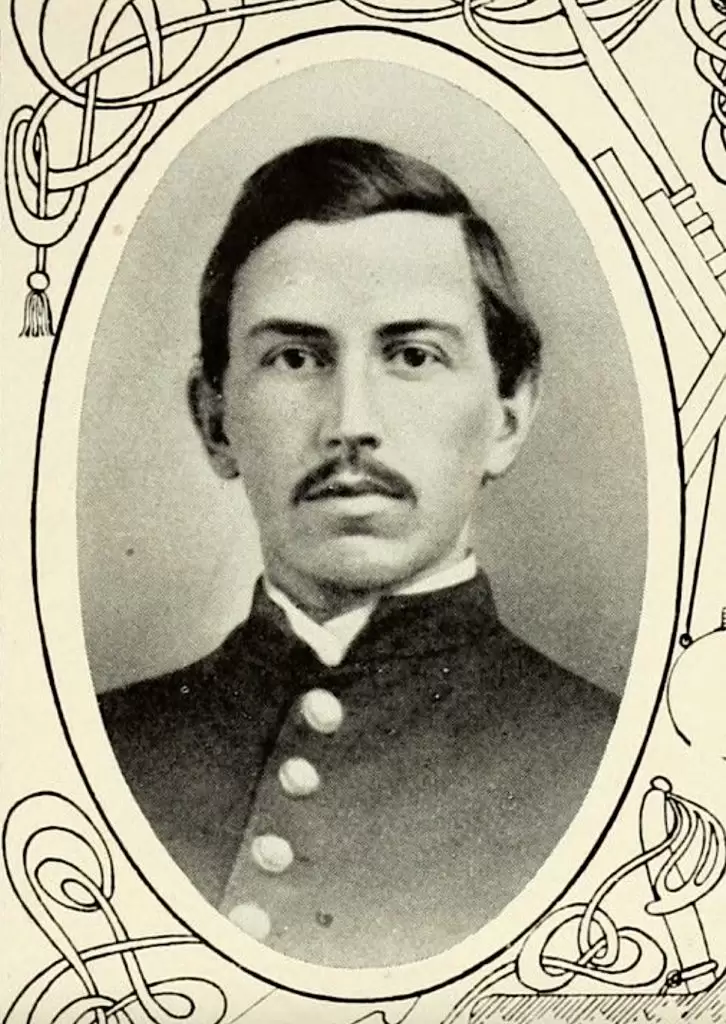
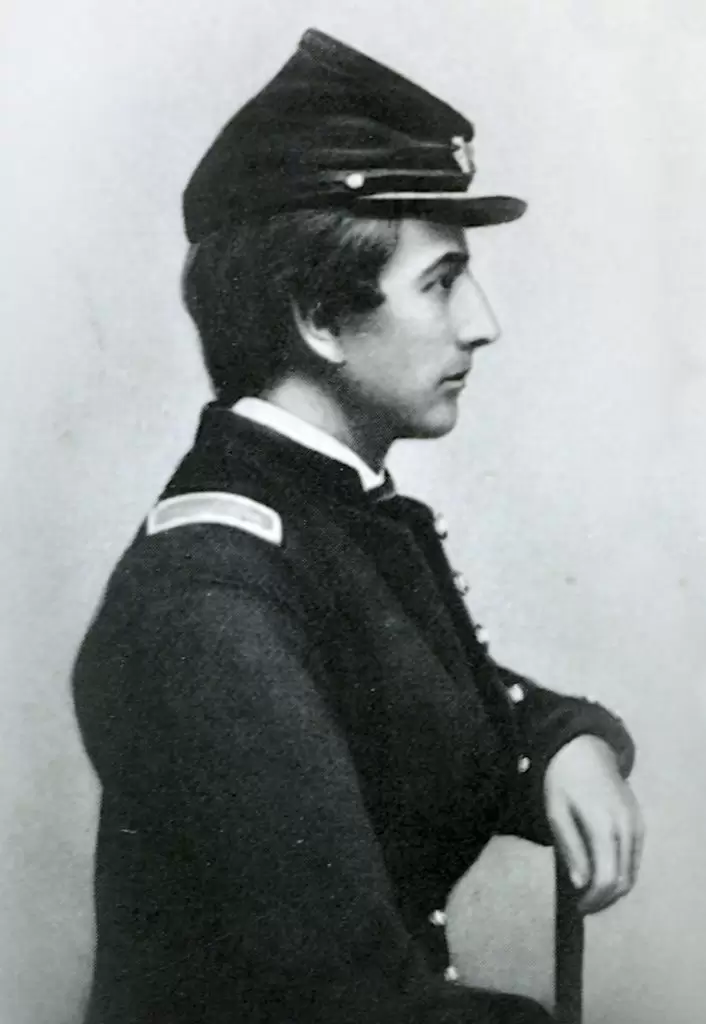

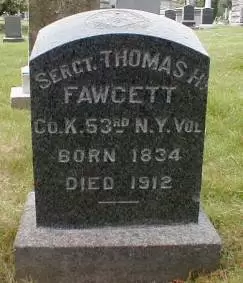
FAWCETT, THOMAS (1834-1912). Sergeant, 53rd New York Infantry, Companies C and K. . A native of Manhattan, Fawcett enlisted on September 18, 1861, as a sergeant, and mustered into Company C of the 53rd New York the next day. As per his muster roll, he was employed as a clerk, stood 5′ 7″ tall, and had grey eyes, dark hair and a dark complexion. On October 22, 1861, he transferred to Company K. He mustered out on March 21, 1862, at Washington, D.C.
In 1903, his application for a pension was approved, certificate 1,060,401. On June 9, 1904, he became a member of G.A.R.’s William Rankin Post #10 in Brooklyn. His obituary in the Brooklyn Daily Eagle notes that he had been an optician who owned a business in Manhattan for fifty years before retiring in 1902. In addition, he was a Freemason for 52 years and also belonged to the War Veterans and Sons Association and the Knights of Honor; members of the Rankin Post and his Masonic lodge were invited to attend his funeral. Fawcett last lived at 111 Nevins Street in Brooklyn. Shortly after his death from apoplexy in 1912, Mary Fawcett applied for and received a widow’s pension, certificate 749,326. Section 143, lot 22418.
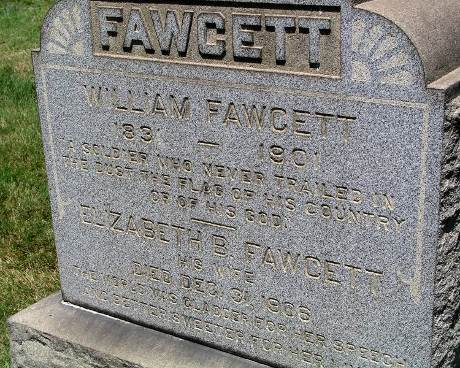
FAWCETT, WILLIAM (1834-1901). Private, 82nd New York Infantry, Company B. Born in Ireland, he enlisted at New York City on April 17, 1861, and mustered into the 82nd on May 21, 1861. As per his soldier record, Fawcett was captured at Bull Run, Virginia, on July 21, 1861, and was held as a prisoner of war at Libby Prison in Richmond, Virginia, then transferred to Salisbury, North Carolina, and ultimately held at New Orleans, Louisiana. He was paroled and later discharged for disability on February 1, 1862. However, his obituaries in the Brooklyn Standard Union and the Brooklyn Daily Eagle both report that he was incarcerated until the end of the War. His obituary in the Brooklyn Daily Eagle goes on to say that he kept busy during his confinement by sculpting bone and wood with a jack knife that that had secreted in his shoe. The relics that he whittled were brought home and displayed in 1901 in a Civil War exhibit by the No Name Chautauqua Circle.
According to the censuses of 1880 and 1900 and the Brooklyn Directory for 1888-1890, Fawcett owned a saddlery and hardware manufacturing business at 97 Cliff Street in Manhattan. He was granted an invalid pension in 1890, certificate 834,877. Fawcett was a member of the Ulysses S. Grant Post #327 of the G.A.R. and was treasurer of his church’s Sunday school for a generation. His last residence was 239 Van Buren Street in Brooklyn. His death was attributed to “shock operation.” In 1901, Elizabeth Fawcett, who is interred with him, applied for and received a widow’s pension, certificate 548,922. Section 187, lot 18952, grave 6.
FAWPELL, PETER B. (1832-1863). Detective and assistant to the provost marshal. A New York City resident, Fawpell was a detective on the staff of Special Provost Marshal Lafayette C. Baker in Washington, D.C. In 1862, President Abraham Lincoln signed an executive order that made the War Department responsible for rooting out subversive activities. Baker was charged with the responsibility of conducting all investigations related to this mission, and his department, the first federal detective agency, was considered a forerunner of the Secret Service. Fawpell, a detective on Baker’s staff, was killed in the line of duty. On the evening of August 7, 1863, he and other detectives approached a house in White Point, Virginia, thought to be used by men disloyal to the Union. Some accounts at the time indicate that the detectives were working together with officers and crew of the USS Coeur de Lion, a gunboat. In any event, as Fawpell approached the residence, a Union guard demanded his identification, and, in an apparent misunderstanding, he was mortally wounded by gunshots, a case of “friendly fire.” He died hours later and his remains were returned to New York for burial. His obituary in The New York Times confirms his accidental death in the line of duty as assistant to the provost marshal. His last residence was at 109 Christopher Street in New York City. Section 158, lot 14608.
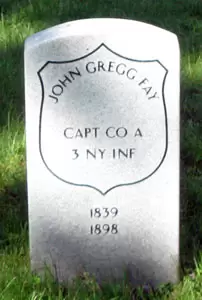
FAY, JOHN GREGG (1839-1898). Captain, 3rd New York Infantry, Company A. Born in Westchester, New York, he was a descendant of Lord Pell of Pelham Manor, the holder of the Long Reach Patent, which he transferred to the Huguenots, giving them possession of New Rochelle, New York, in the early part of the eighteenth century. Fay enlisted on April 17, 1861, at Albany, New York, as a first lieutenant, was commissioned into the 3rd New York on May 14, and was promoted to captain on July 2 of that year. As a captain, he commanded the 3rd New York at the siege and defense of Suffolk, Virginia, from April 11 to May 4, 1863. He was dismissed from the service on May 24, 1864, but that dismissal was reversed and he was honorably discharged.
After the Civil War, Fay became a lawyer and belonged to the G.A.R. and a Masonic lodge. He was Supervisor of New Rochelle and also served as a vestryman of St. Paul’s Church, East Chester. At his funeral, the sword that he used in battle adorned his casket and an honor guard from the G.A.R. paid tribute to him. He last lived in Manhattan at 20 West 15th Street. The cause of his death was diarrhea. His widow, Katharine Fay, applied for a federal pension in 1900, application 729,774, but it appears that it was never granted. Section 47, lot 6437.
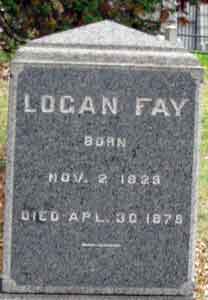
FAY, LOGAN (1829-1879). Orderly sergeant, 7th Regiment, New York State Militia, Company D. Fay, a native of New York, traveled to California in 1849 with three of his brothers and, in 1853, established a soap-making factory in San Francisco with one of his brothers. Logan Fay returned to New York in 1856 where he and another brother went into the soap manufacturing business. During the Civil War, Fay enlisted as a private at New York City on April 19, 1861, and mustered in the 7th Regiment, New York State Militia, Company D, for its 30-day activation. The unit mustered out at New York City on June 3. In 1862, he rejoined his company for three months as an orderly sergeant when his unit was part of the New York State National Guard. The 7th served from May 25 through September 5, 1862, at Baltimore, Maryland.
The census of 1870 lists Fay as living in Staten Island (Richmond) and employed in manufacturing; the New York City Directory of 1872 lists his soap factory, Fay Brothers, at 62 Broad Street in Manhattan. Fay Brothers was an international company and exported laundry soap to Haiti. An article about the soap-making industry in Haiti notes that previous to the establishment of soap factories on the island in 1893, the laundry product was imported from the United States, principally from Fay Brothers and that the island’s brown coarse soap was in the same style as that of the Fay Brothers.
He died suddenly of yellow fever while on business in Port-au-Prince, Haiti. His obituary in the New York Morning Telegraph reported that he belonged to the 7th Veterans’ and was “universally respected and esteemed.” Abbie M. Fay, who is interred with him, applied for and received a widow’s pension in 1932, certificate A-5-31-33. She made headlines across the nation on July 19, 1939, when she announced her intention to vote for the first time, at age 98, in the August 1 Democratic primary in Frederick County, Virginia. (Mrs. Fay lived for many years in England and returned to the United States in 1932; she died a month before her 101st birthday.) Section 149, lot 13645.
FEATHERSTONE, ALFRED (1837-1875). Private, 2nd Massachusetts Cavalry, Company K. Originally from Northampton, England, Featherstone was a painter by trade. He enlisted as a private at Southboro, Massachusetts, on June 1, 1864, and mustered into the 2nd Massachusetts Cavalry on that date. As per his muster roll, he was 5′ 9″ tall with blue eyes, light hair and a light complexion. He was paid a bounty of $25 upon his enlistment for three years. Featherstone’s records indicate a pattern of desertion. The Descriptive List of Deserters Arrested for June 23, 1864, and signed by the provost marshal of the District of Columbia, reports that he was arrested the previous day after being found in citizen’s clothes without a pass at the depot in Washington, D.C., with a ticket to New York City. A $30 reward was paid for his arrest and return to the provost general. His muster roll for August 1864 indicates that he was assigned to Company K as of August 23. Subsequently, he deserted from his unit at Pleasant Valley Remount Camp in Maryland on September 17, 1864. Featherstone’s muster roll for December 1864 indicates that he deserted from Summit Point, Virginia, on November 20, 1864. There are no further muster rolls for him. His last residence was 532 West 42nd Street in Manhattan. He died from pneumonia. Section 127, lot 17931, grave 187.
FEISS, FREDERICK (or FRED) (1825-1892). Sergeant, 5th Regiment, New York State Militia, Company B. A native of Baden, Germany, Feiss became a naturalized citizen in 1849 at which time he was living at 34 Madison Street in Manhattan. After enlisting as a sergeant at Washington, D.C., on May 16, 1861, he immediately mustered into Company B of the 5th Regiment, also known as the Jefferson Guard, and mustered out with his company at New York City on August 7, 1861.
The 1870 and 1880 censuses indicate that he lived in Manhattan and worked as an upholsterer; he was a widower living with his adult daughter at the time of the 1880 census. He last lived at 516 East 84th Street in Manhattan. His death was attributed to dysentery. Section 117, lot 10975, grave 613.
FENDT, ALEXANDER (1845-1865). Private, 1st New Jersey Light Artillery, Company C. Of German origin, Fendt enlisted as a private and mustered into “Batty C” of the 1st New Jersey Light Artillery on September 28, 1864. After suffering from a gunshot wound that caused a contusion of his left lung, he died on April 17, 1865, at City Point, Virginia. Section 102, lot 8761.
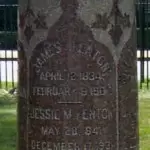
FENTON, JAMES V. (1834-1907). Corporal, 82nd New York Infantry, Company G. Of Scottish birth, Fenton enlisted as a private at New York City on June 1, 1861, and was promoted to corporal on March 1, 1862. He was wounded at the Battle of Antietam, Maryland, on September 17, 1862, and deserted three months later on December 21. As per his 1863 Draft Registration and the census of 1900, he was a carpenter by trade. His last residence was at 282 Winthrop Street in Brooklyn. He succumbed to pneumonia. Section 196, lot 28089, grave 2.
FENWICK, WILLIAM L. R. (1832-1890). Landsman, United States Navy. Of Irish origin, Fenwick enlisted on July 21, 1864, in the United States Navy and served on board the USS Vermont, transferred to the Chocura, and then served on the Portsmouth from which “he secured his discharge” on July 29, 1867. According to his marriage certificate in 1868, the census of 1880, and his death certificate, he was employed as a house painter. The 1890 Veterans Schedule confirms his service on the gunboat Chocura from July 29, 1864, through July 22, 1867. His last residence was 76 Rapelyea Street in Brooklyn. Shortly after his death in 1890, Mary A. Fenwick applied for and received a widow’s pension of $8 per month from the Navy, certificate 8,196. Section 40, lot 4548.
FERGUSON, ALEXANDER (1837-1919). Private, 8th Regiment, New York State Militia, Company H; United States Marines. A native of Scotland, his family immigrated to the United States when he was a baby. He was trained as a silversmith and enlisted for a 90-day tour of duty with the 8th New York State Militia in April 1861, mustered in on April 26, and left for the defense of Washington, D.C. The regiment fought in Virginia at the advance on Manassas and at First Bull Run on July 21, 1861. He mustered out with his company at New York City on August 2 and re-enlisted in the United States Marines serving with Admiral David Farragut. In one engagement to break the blockade of the Mississippi, his boat overturned and he lost all of his belongings including a family bible that his mother gave him when he entered military service. At a later date, the boat was raised and he secured the book that became a treasured heirloom.
After his mustering out on November 19, 1865, Ferguson resumed his trade, was active in David Farragut Post #516 of the G.A.R. in Manhattan, and taught Bible classes in Sunday school at the Chelsea Methodist Church. His application for an invalid pension was approved under certificate 30,644. His obituary in the Brooklyn Standard Union confirms his Civil War service and trade as a silversmith from which he retired in about 1909. Ferguson retired to Huntington, Long Island, where he resided the last six years of his life. His death was listed as “cardiac dilatation.” Annie Ferguson applied for and received a pension in 1919 under certificate 881,191. Section 103, lot 12064.
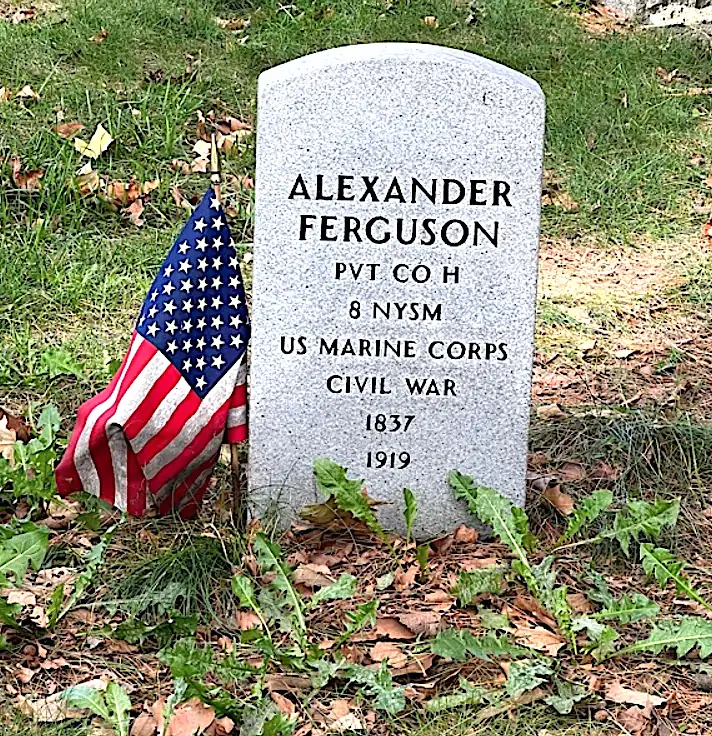
FERGUSON, ANDREW (1824-1869). Private, 173rd New York, Company E. Born in Ireland, Ferguson was a laborer at the time he enlisted at Brooklyn on September 2, 1862. He mustered into the 173rd New York on October 30, and mustered out on October 18, 1865, at Savannah, Georgia. At the time of his death, he was a driver as per the Brooklyn Directory. His last address was 144 Nassau Street in Brooklyn. His death was caused by gastritis. Section 122, lot 17806, grave 89.
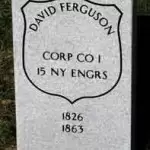
FERGUSON, DAVID (1826-1863). Corporal, 15th New York Engineers, Company I. Corporal, 15th New York Engineers, Company I. Ferguson, who was born in Scotland, married Margaret Flemming in 1850. During the Civil War, he enlisted at New York City as a private on May 9, 1861, and mustered into the 15th New York on June 17 for a term of two years. As per his muster roll, he worked in civilian life as a rigger and was 5′ 8″ tall with blue eyes, brown hair and a ruddy complexion. On November 1, 1862, he was promoted to corporal. Ferguson was hospitalized at Armory Square Hospital in Washington, D.C., in April 1863.
As per the article, “Three Letters From Soldiers,” in Prologue Magazine (summer 2016) by Kenneth M. Price and Jacqueline M. Budell, Ferguson was sick in a Washington, D.C., military hospital when his letter home to his wife was written and signed by volunteer nurse Walt Whitman, as “a friend;” two other letters written by Whitman on behalf of soldiers have surfaced after 2015. Ferguson’s letter was first published in Walt Whitman: The Correspondence, edited by Edwin Haviland Miller (1961). Whitman urged soldiers to communicate with their families on his many visits to hospitals. He wrote letters to loved ones on behalf of soldiers who could not express their thoughts in writing, either because of disability or illiteracy, and related this in his book, Memoranda During The War (1875). The soldiers represented the “divinity” of the ordinary people whom Whitman praised in his writings; Whitman volunteered as a scribe, an amanuensis, or literary assistant. Whitman later wrote of his connection to the wounded and sick soldiers: “I believe no men ever loved each other as I and some of those poor wounded, sick and dying men love each other.”
On April 29, 1863, Whitman wrote this letter to Ferguson’s wife. Unbeknownst to Ferguson, his wife had died five days earlier.
I am now to inform you that I have been now sick for two weeks—have been for the past week in Armory Square Hospital—have a pretty bad cold, the doctor does not call my disease by any particular name—I have considerable cough—but I think I shall be up all right before a great while, so you must not be uneasy—I have pretty good care taken of me here, & I shall do well—I send you an envelope for you to put a letter in, as I wish you to write to me.
I send you my love. I have this letter written by a friend who sometimes calls in to see me & the other boys.
Good bye for the present, & God bless you & all.
David Ferguson
The above letter written by Walt Whitman, a visitor to the hospitals.
Ferguson was discharged for disability at Washington D.C., on May 22, 1863. As per the article in Prologue Magazine, the surgeon’s certificate noted: “Extreme debility resulting from a severe attack of pneumonia and the impossibility of his recovering before the expiration of his term of service.”
After returning to New York, Ferguson last lived at 609 Water Street in Manhattan. He died from consumption on June 16, 1863, leaving two orphaned children, a daughter and son, ages 11 and 9. In 1892, an application for arrears on his minor’s pension was filed by Charles Ferguson and approved under certificate 376,311; his sister, Mary Jane, had died in September 1877 of consumption, the same disease that afflicted both parents. Section 115, lot 13536 (Soldiers’ Lot), grave 65.
FERGUSON, JOHN R. (1832-1923). First sergeant, 67th New York Infantry, Companies K and E. A native of Scotland, Ferguson enlisted as a sergeant at New York City on June 4, 1861, mustered into Company K of the 67th New York on June 24, and was transferred into Company E on December 1. At some point, he was reduced to the rank of private but was promoted to corporal on March 8, 1862, and then to first sergeant on September 5, 1862. He was discharged for disability on February 27, 1863, at White Oak Church, Virginia. His last residence was on Lincoln Place in Brooklyn where he lived to the age of 91. His death was attributed to arteriosclerosis. Section 17, lot 17245.
FERRERO, EDWARD (1831-1899). Major general by brevet; brigadier general, United States Volunteers; colonel, 51st New York Infantry; lieutenant colonel, 11th Regiment, New York State Militia. Born in Grenada, Spain, to Italian parents, he immigrated to this country when he was two years old. Italian political refugees, including Garibaldi, Argenti, Albius, and Avazzana, often came to visit his father. Edward Ferrero began his career as a dance instructor at his father’s fashionable school, then ran his own school and taught dancing at the United States Military Academy. In 1859, he wrote The Art of Dancing, Historically Illustrated. He was about 5′ 7″ and had a fair complexion with light blue eyes and dark hair.
At the outbreak of the Civil War, Ferrero was lieutenant colonel of the 11th Regiment, New York State Militia. In 1861, he raised the 51st New York Infantry, known as the “Shepard Rifles,” and commanded a brigade against Roanoke Island, North Carolina. In his field report of February 8, 1862, outlining the action at Roanoke Island, he described his pride when his troops planted the American flag and took possession of the ammunition in the fort there. He also commanded a brigade at Second Bull Run, Virginia; Antietam and South Mountain, Maryland, and served in Pope’s Virginia Campaign. Fighting at South Mountain and Antietam, he was rewarded with an appointment as brigadier general of Volunteers in 1862, and resigned as colonel of the 51st New York Infantry. On March 14, 1862, he wrote from New Berne, North Carolina, describing the intense fire endured by his troops, “The regiment under my command landed from the steamers Lancer and Pioneer on the 13th instant about 14 miles below New Berne, N. C….A continuous fire was then kept up on the enemy, which they returned with great vigor, making sad havoc in our ranks…My loss at this point was very severe, owing to the exposed position of the troops when advancing to fire…The unflinching courage displayed by all of my command cannot be too highly praised, each one vieing (sic) with the other to make our victory sure and complete. To particularize those who behaved with gallantry would be unjust where all did so well. The following officers, however, I cannot avoid noticing…Capt[ain] David R. Johnson (see), of Company I, who was severely wounded, displayed great bravery…” Ferrero served at Fredericksburg, Virginia; Vicksburg, Mississippi; Knoxville, Tennessee; Cincinnati, Ohio; and Bean’s Station, Tennessee, and was brevetted major general in 1864.
In the last campaign of the War, including the siege of Petersburg, Virginia, Ferrero commanded the “colored division” of the 9th Corps. As this siege dragged on, a plan was hatched for coal miners from the 48th Pennsylvania to tunnel underneath the Confederate lines and to detonate a massive explosion to breach those lines. While the coal miners worked for one month to dig their 600-foot tunnel, Ferrero’s troops were trained to spearhead the assault. However, on the day before the detonation, the troops of Brigadier General James H. Ledlie were ordered to precede Ferrero’s men in storming through the expected gap in the Confederate line. On July 30, 1864, four tons of powder were successfully detonated, and nine companies of South Carolinians were blown high into the air. Nevertheless, both Ledlie’s and Ferrero’s men charged to disaster, running into The Crater which the explosion left instead of forming around it. While these men committed this fatal mistake, Ledlie, joined by Ferrero, sat in a bombproof oblivious to the plight of their commands, and “passed a bottle of rum back and forth.” Southern troops reformed on the rim of The Crater, shooting down trapped Union men, and many black troops were shot even after they surrendered. One Union officer said, “The men were dropping thick and fast, most of them shot through the head. Every man that was shot rolled down the steep sides to the bottom, and in places they were piled up three and four deep. Bayoneted muskets, which had been abandoned on the field earlier, were picked up by the Confederates and flung, like javelins, into the pit. Heavy canister fire from a Confederate battery swept Union soldiers who somehow had managed to scramble to the crest of the Crater A court of inquiry found that Ferrero, Ledlie, and their commander General Ambrose Burnside, were primarily responsible for this disaster, but Ferrero avoided formal punishment, and despite the incident was brevetted major general in December 1864. Ferrero mustered out of service on August 24, 1865, and returned to New York, where he managed several large ballrooms until the end of his life. His last residence was on West 78th Street in Manhattan. He died from pneumonia. Amanda Ferrero, who is interred with him, applied for and received a widow’s pension, certificate 673,787. Section 76, lot 4317, grave 2.
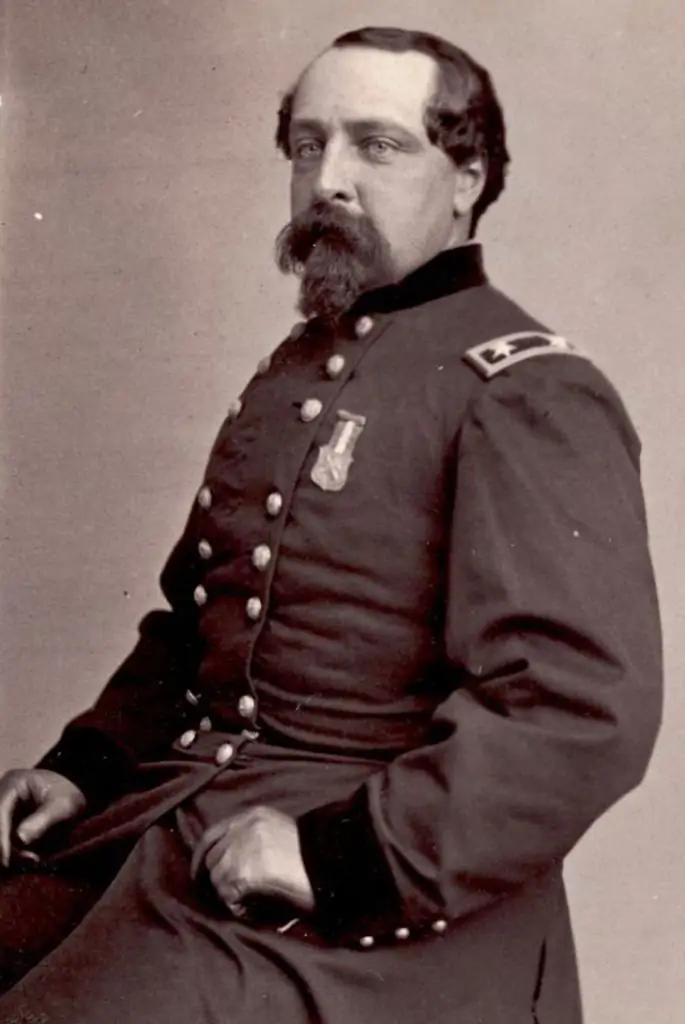
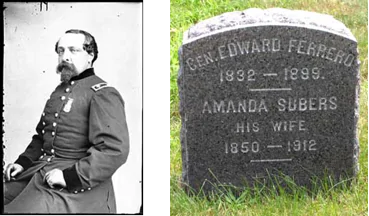
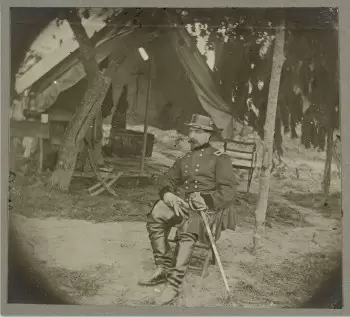
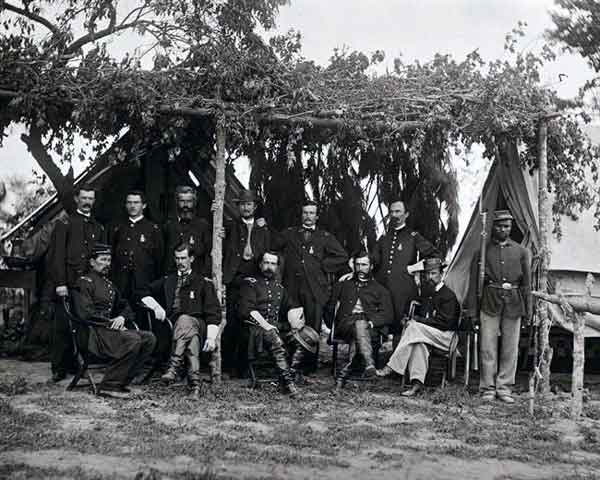
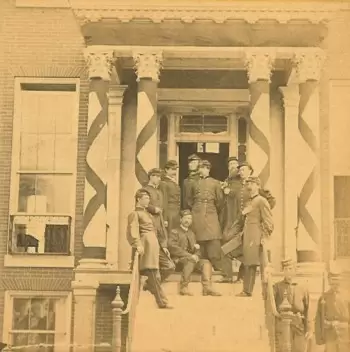
FERRIER, ALEXANDER (1830-1886). Private, 83rd New York Infantry, Company L. A native New Yorker, Ferrier’s occupation on the census of 1860 was “porter and ale.” During the Civil War, he enlisted at New York City on September 6, 1861, and mustered into the 83rd New York on that day. During his service, he was listed as a deserter on September 15, 1862, at Thoroughfare Gap, Virginia, and surrendered at an unstated place on March 10, 1865. He mustered out on May 13, 1865, at Fort Columbus in New York Harbor.
The New York City Directory of 1868 lists him in the soda business; according to the census of 1870, he was an ale bottler. He was a worker in a soda water factory as per the census of 1880 and the 1880 New York City Directory. Ferrier last lived at 408 Second Avenue in Manhattan; his death was attributed to phthisis. In 1911, Mary Ferrier, who is interred with him, applied for and received a widow’s pension, certificate 559,375. Section 170, lot 13342.
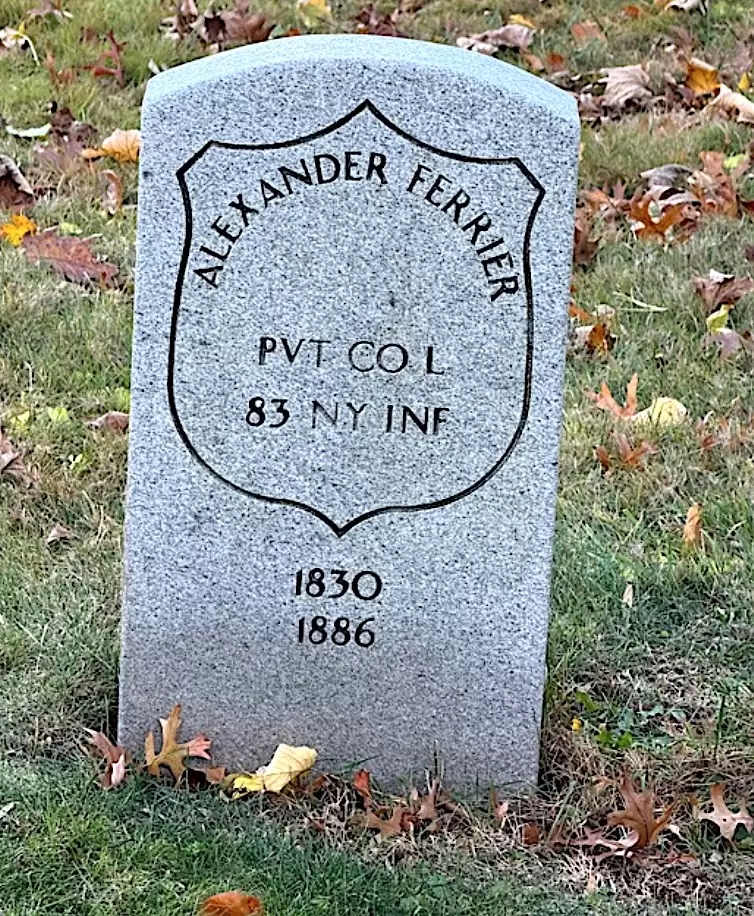
FERRIS, ELDAD HOLMES (1833-1865). Acting assistant surgeon, United States Army. A native of New York City, Ferris was a graduate of the Medical College of the City of New York, class of 1857. During the Civil War, he served as an acting assistant surgeon for the United States Army. Further details are not known. He died of gastritis on September 23, 1865, at his residence on East 24th Street in Manhattan. Ferris’s remains were moved to the current location on September 16, 1876. Section 102, lot 6087.
FERRIS, JAMES (1817-1897). Private, 182rd New York Infantry, Company K. After enlisting at New York City as a private at age 45 on September 27, 1862, Ferris mustered into the 182nd New York on November 17, and mustered out on May 15, 1865. His pension record cites additional service in Company A of the 22nd Veterans and Company K of the 186th New York. Ferris’s obituary in The New York Times confirms his service in the 22nd Veterans and notes service in the 69th New York Infantry; however, there is no indication of service in the 69th on his pension index card.
After the War, he was a civil servant who worked for the Post Office, Custom House and Internal Revenue Department. His application for an invalid pension was granted in 1873, certificate 130,526. His death resulted from heart disease. Section 200, lot 24701.
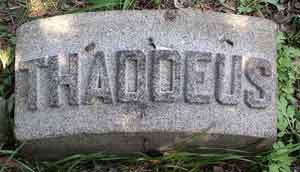
FERRIS, THADDEUS C. (1838-1864). Captain, New York Enfants Perdus, Companies B, C, G, and E; first lieutenant, 90th New York Infantry, Company A; second lieutenant, 53rd New York Infantry, Company I. A resident of Degraw Street in Brooklyn and a native of New York City, Ferris stood 5′ 9½” tall with grey eyes, dark hair and a light complexion. As per a report in the September 29, 1859 edition of The New York Times, a police officer by the name of Thaddeus C. Ferris of the Sixth Precinct, Brooklyn force, was dismissed after he was accused of seduction. Given the rarity of that name, that officer appears to have been this man.
Ferris, a salesman, enlisted at New York City on August 5, 1861, was commissioned as a second lieutenant into the 53rd on October 14, 1861, and mustered out on March 8, 1862. On May 8, 1862, he re-enlisted as a first lieutenant and was commissioned into the New York Enfants Perdus, Company B, on that date. Promoted to adjutant on July 20, 1862, he was immediately transferred to the Field and Staff and subsequently transferred to Company C on November 8, 1862, upon his promotion to captain. He was transferred to Company G on January 15, 1863 (estimated date), to Company E on January 23, 1863, and to Company G on February 15, 1863 (estimated date). He mustered out on February 6, 1864, at Hilton Head, South Carolina. He re-enlisted as a first lieutenant on May 25, 1864, at New Orleans, Louisiana, and was commissioned into the 90th New York on June 20, 1864. Killed in battle on October 19, 1864, at Cedar Creek, Virginia, he was buried at Green-Wood on November 9, 1864. On April 28, 1865, Mary Genevieve Ferris applied for and received a widow’s pension under certificate 57,622. Section 63, lot 4483.
